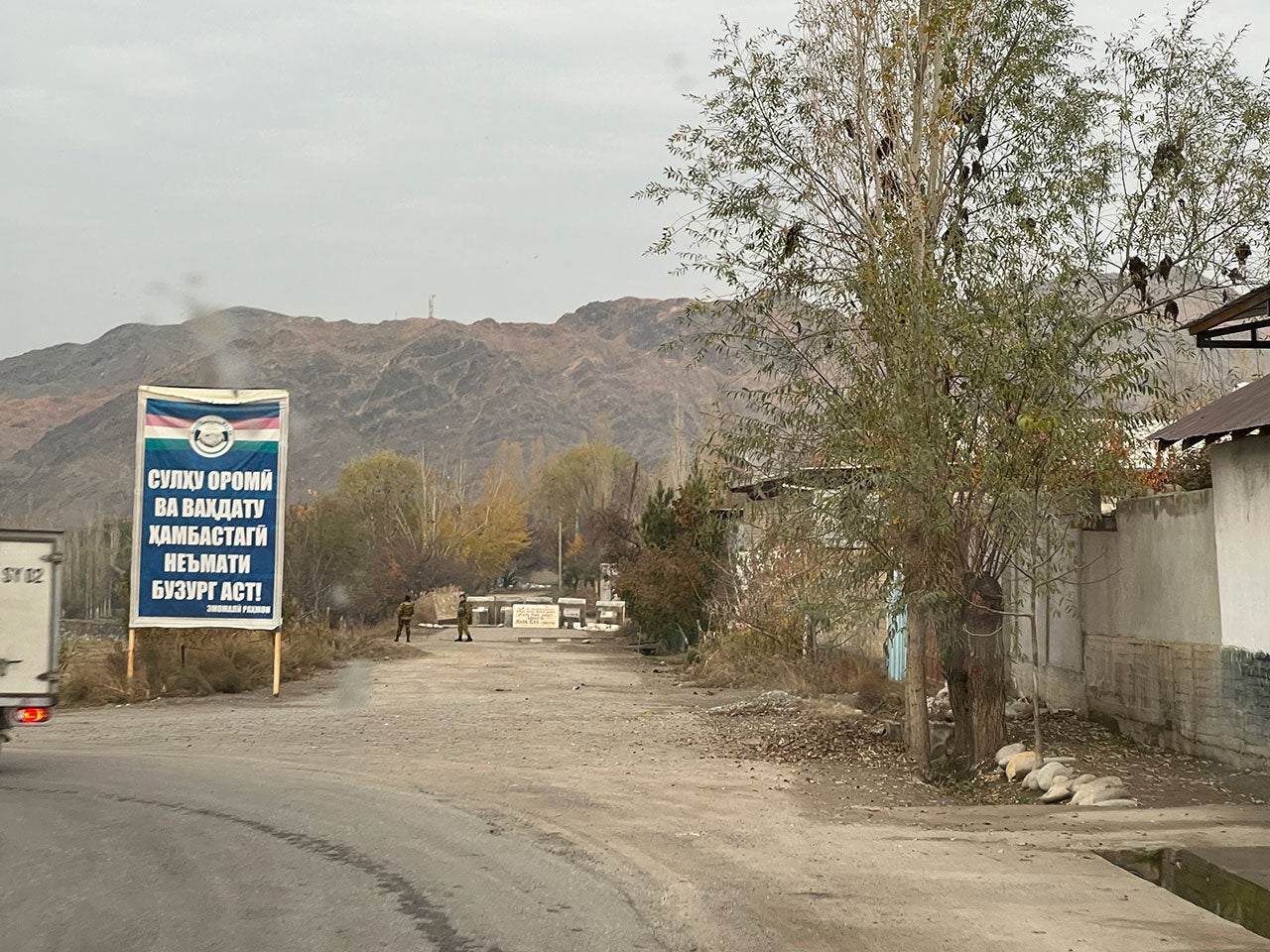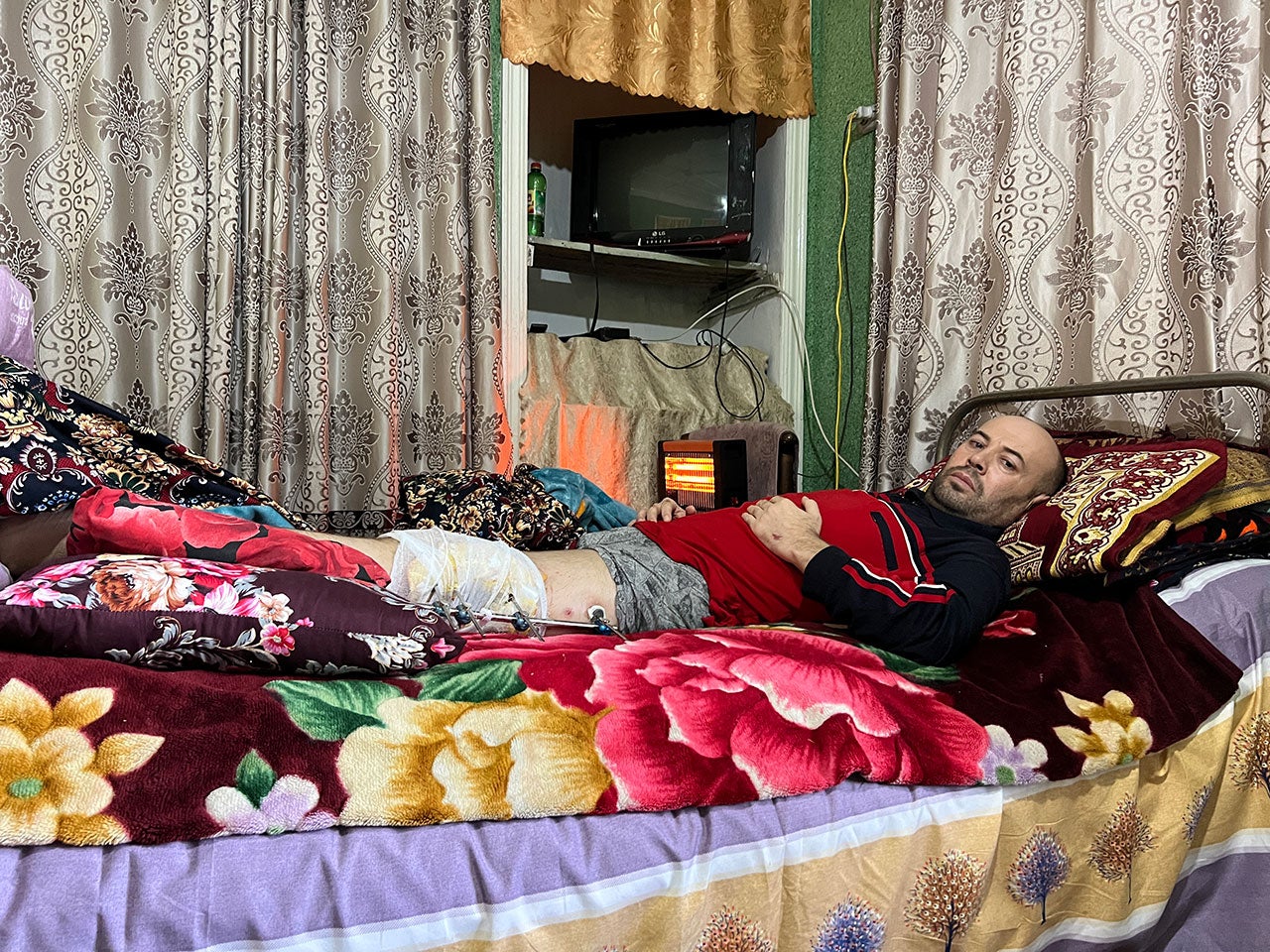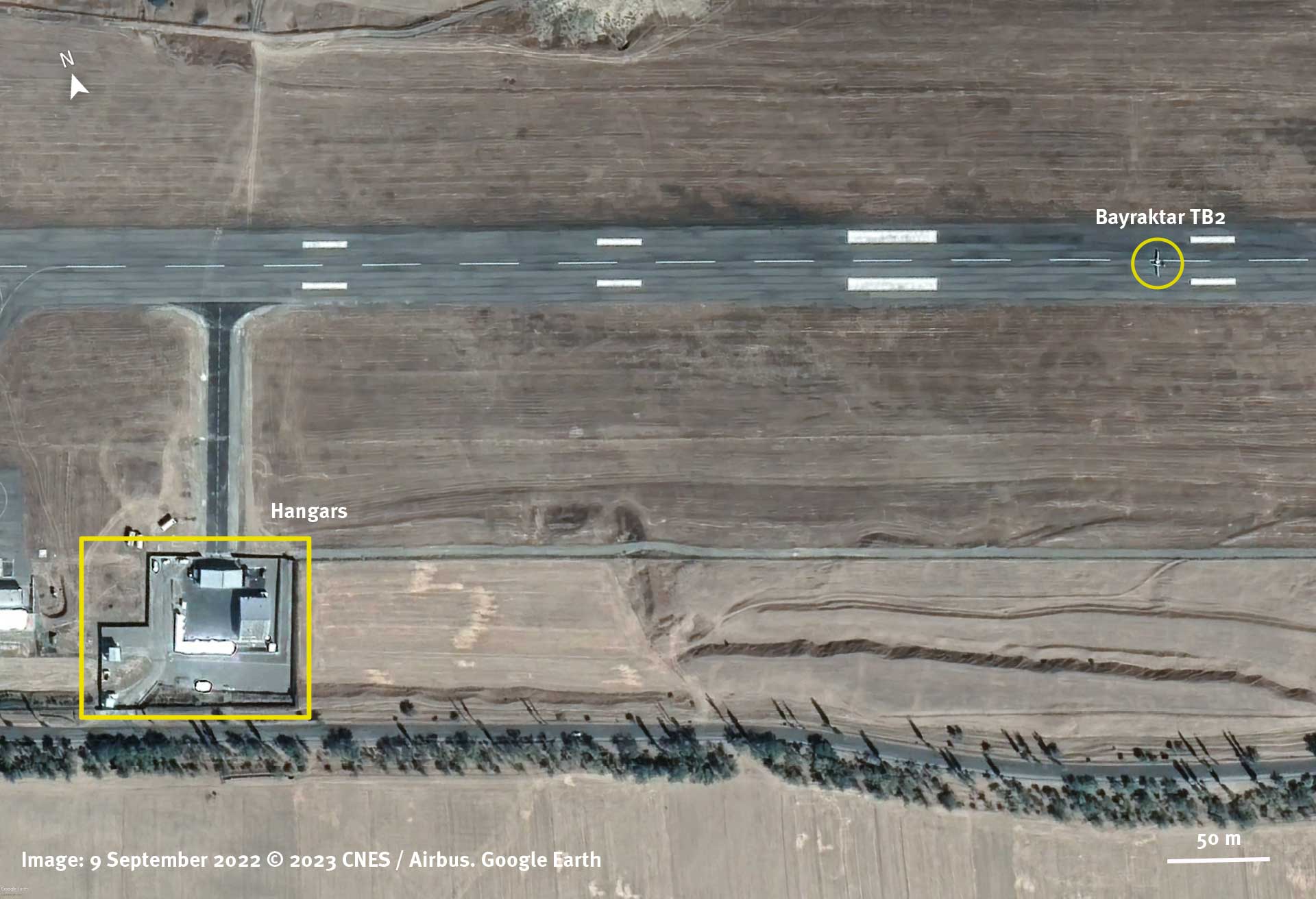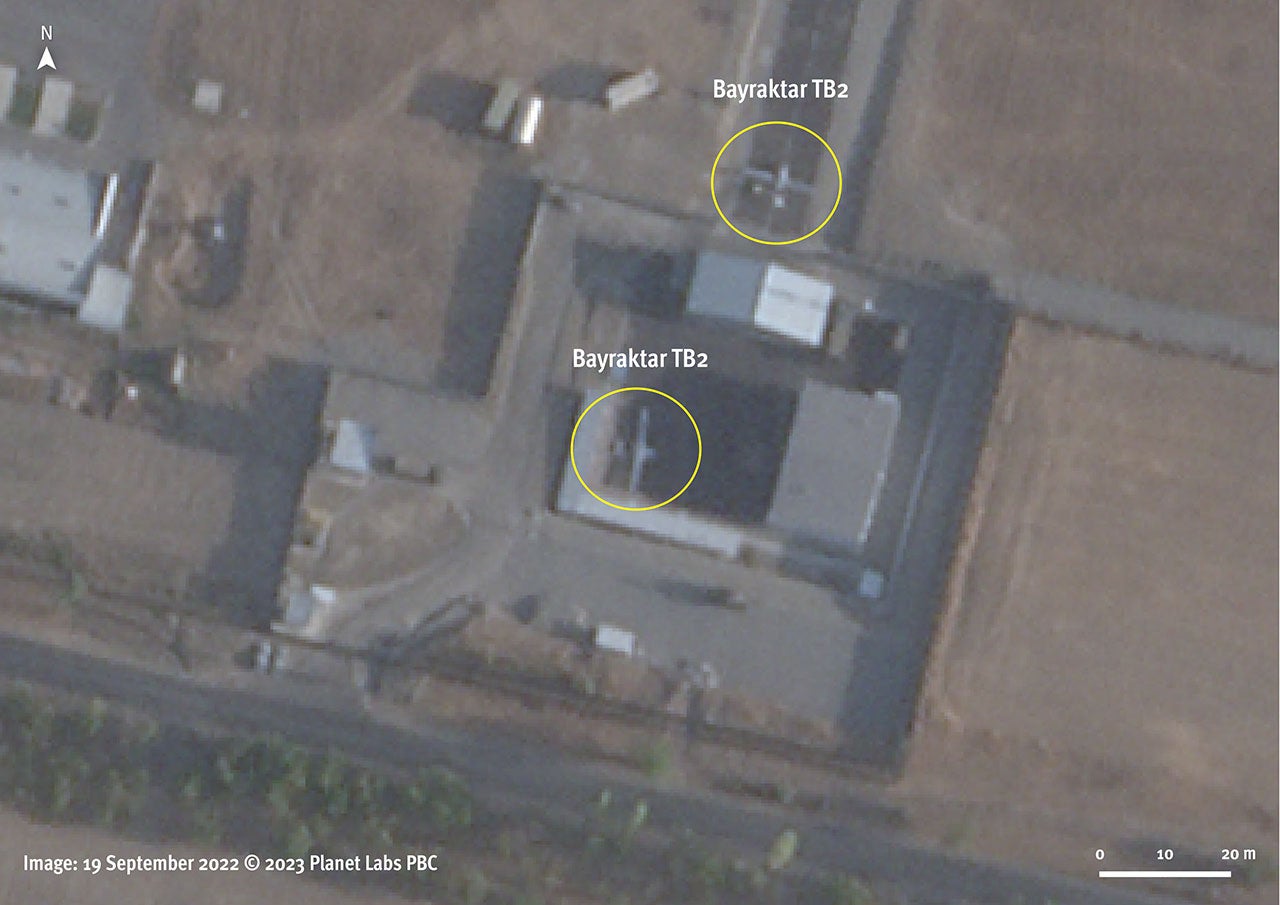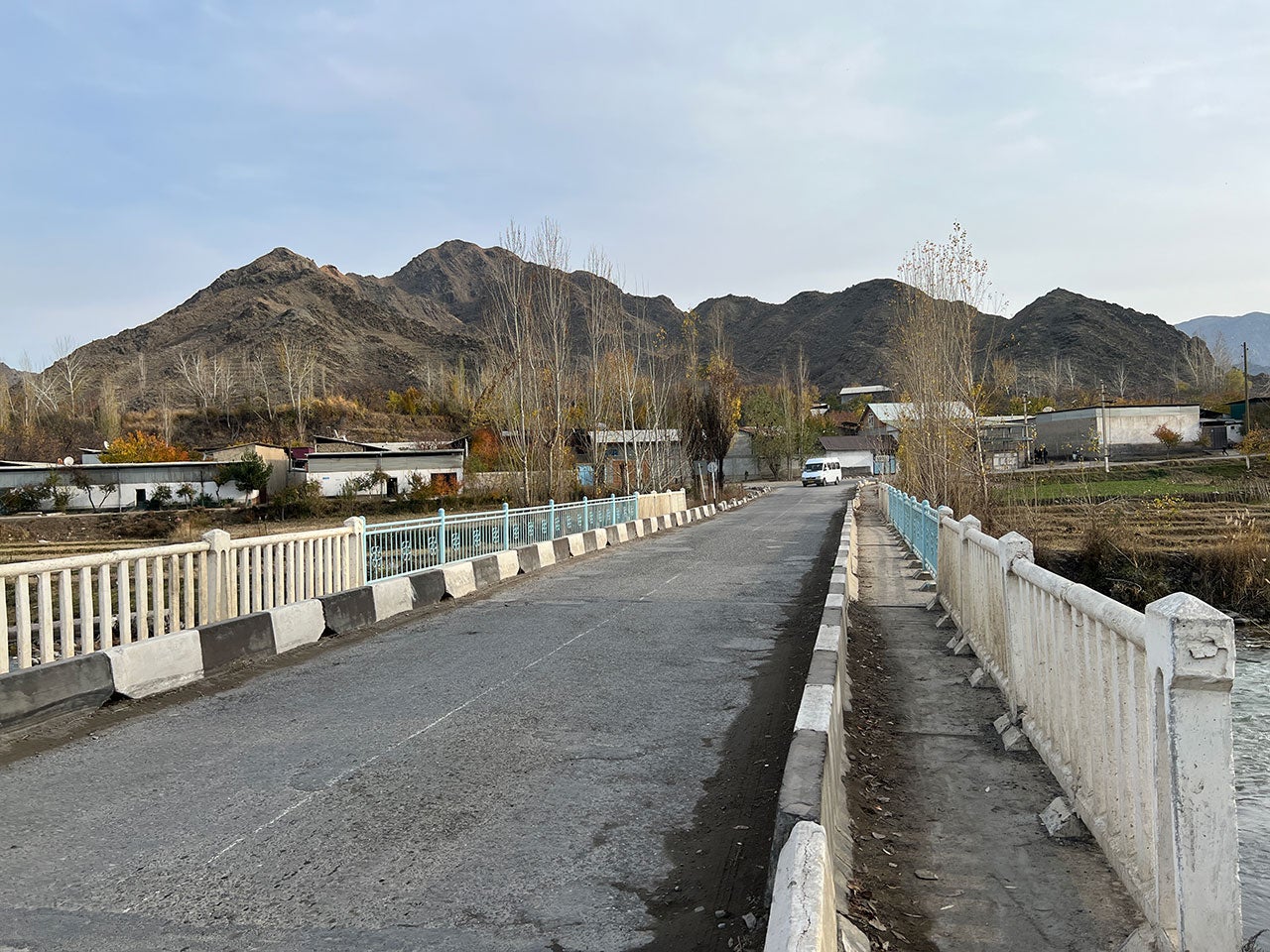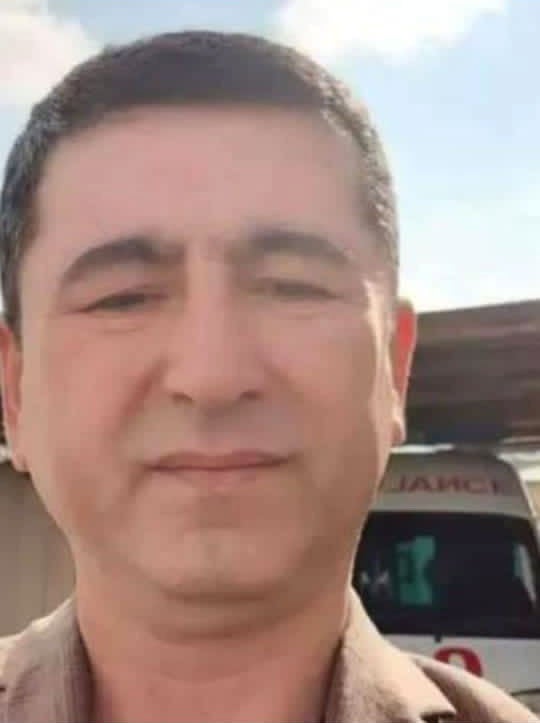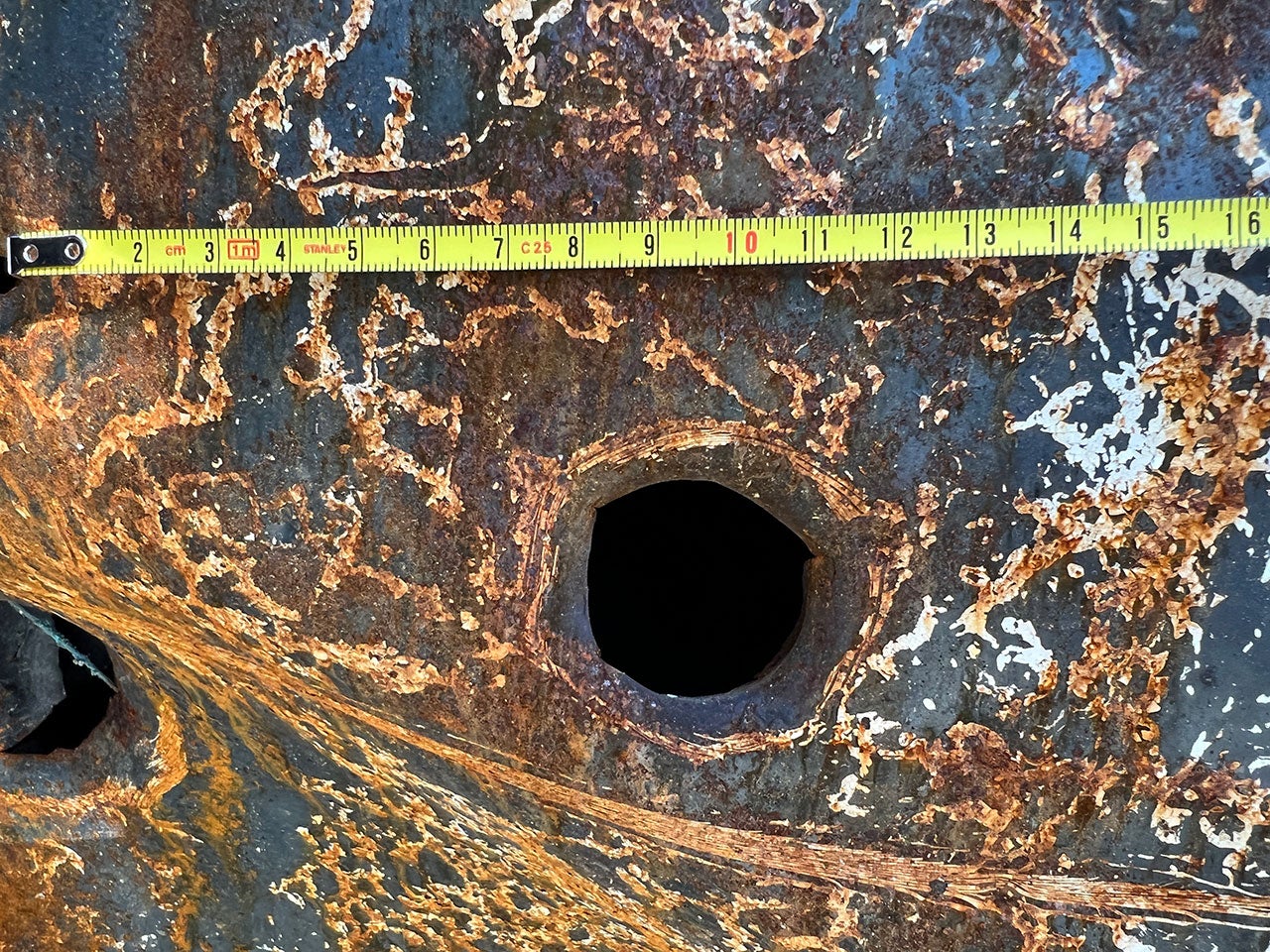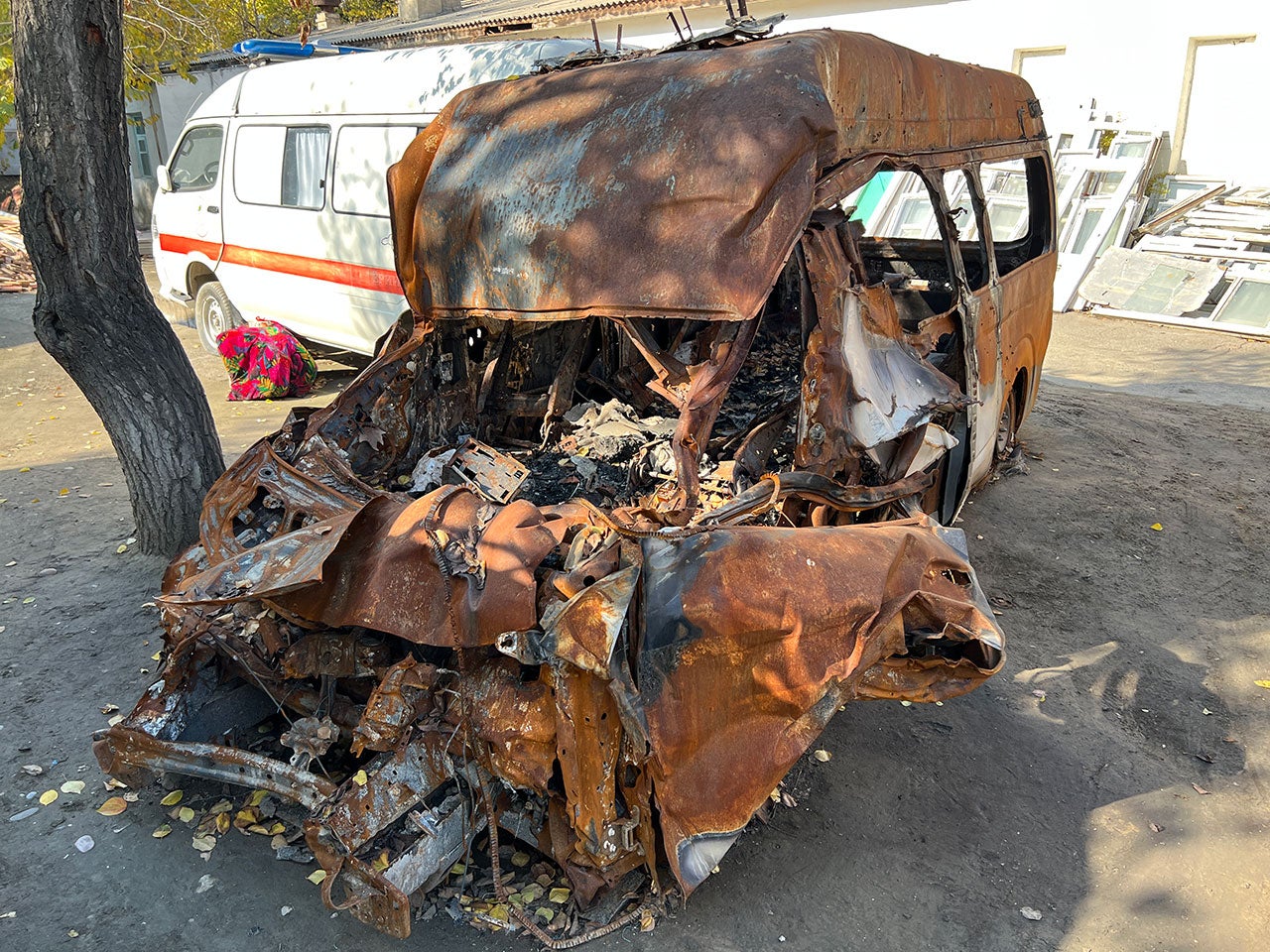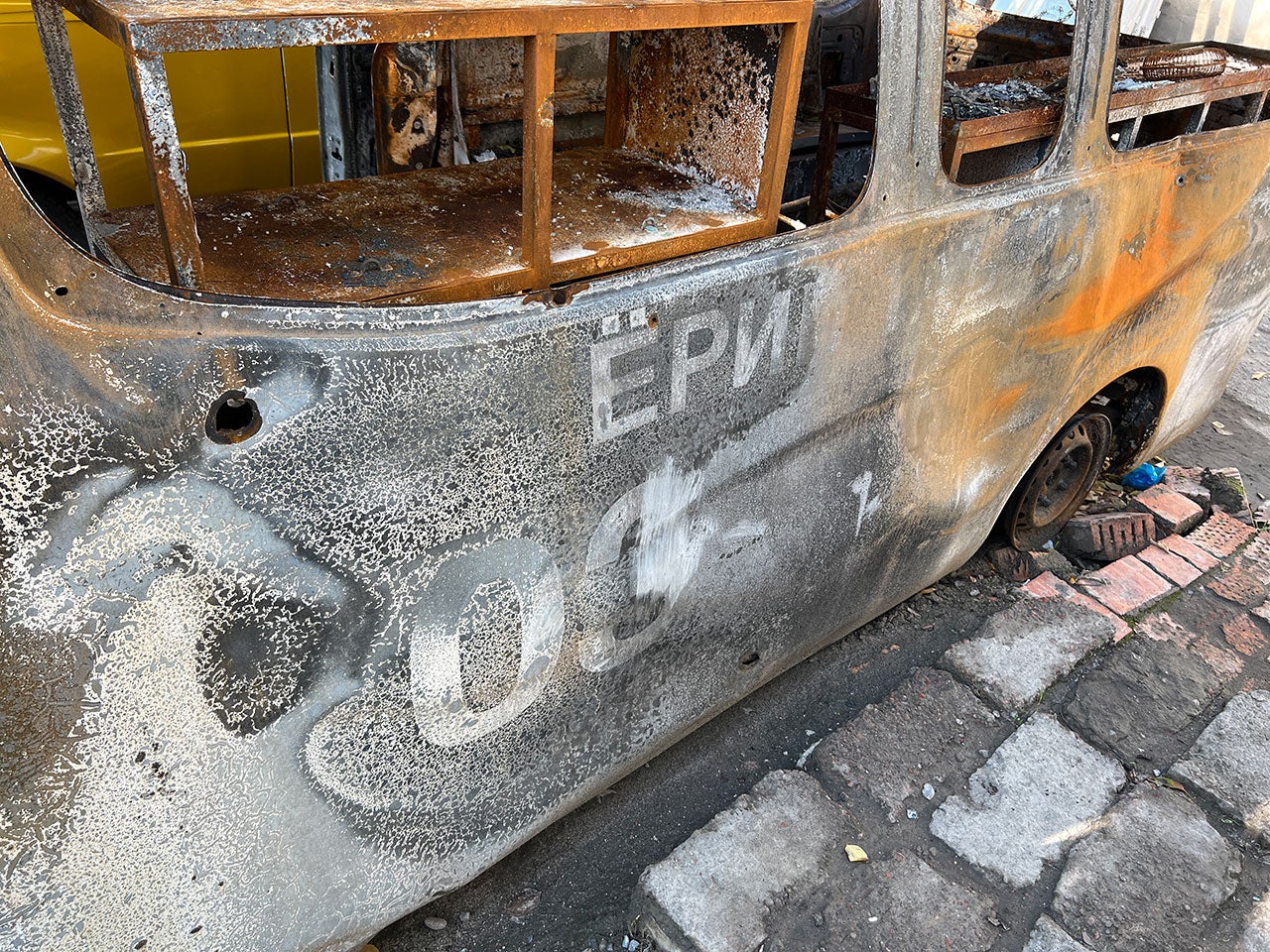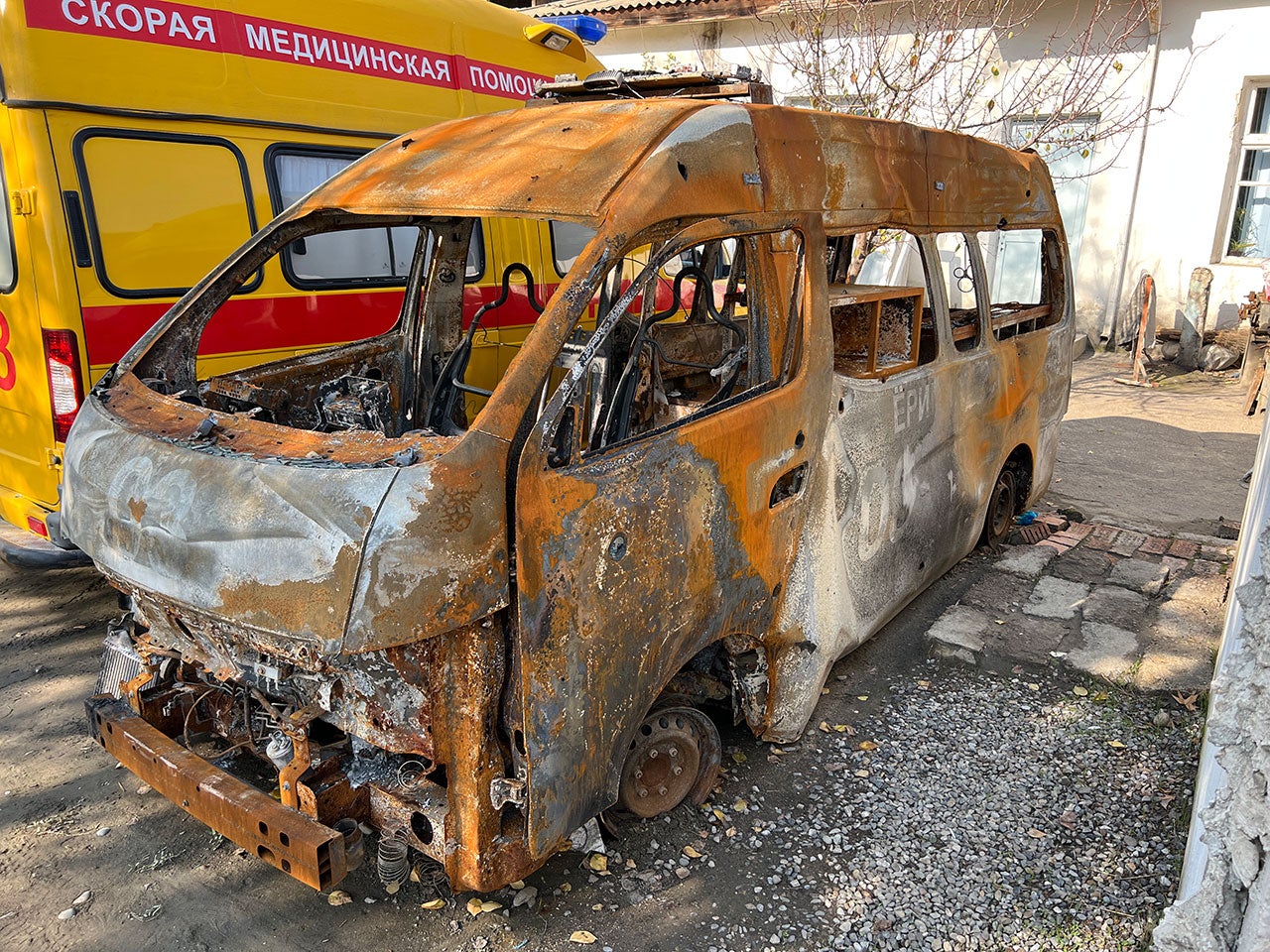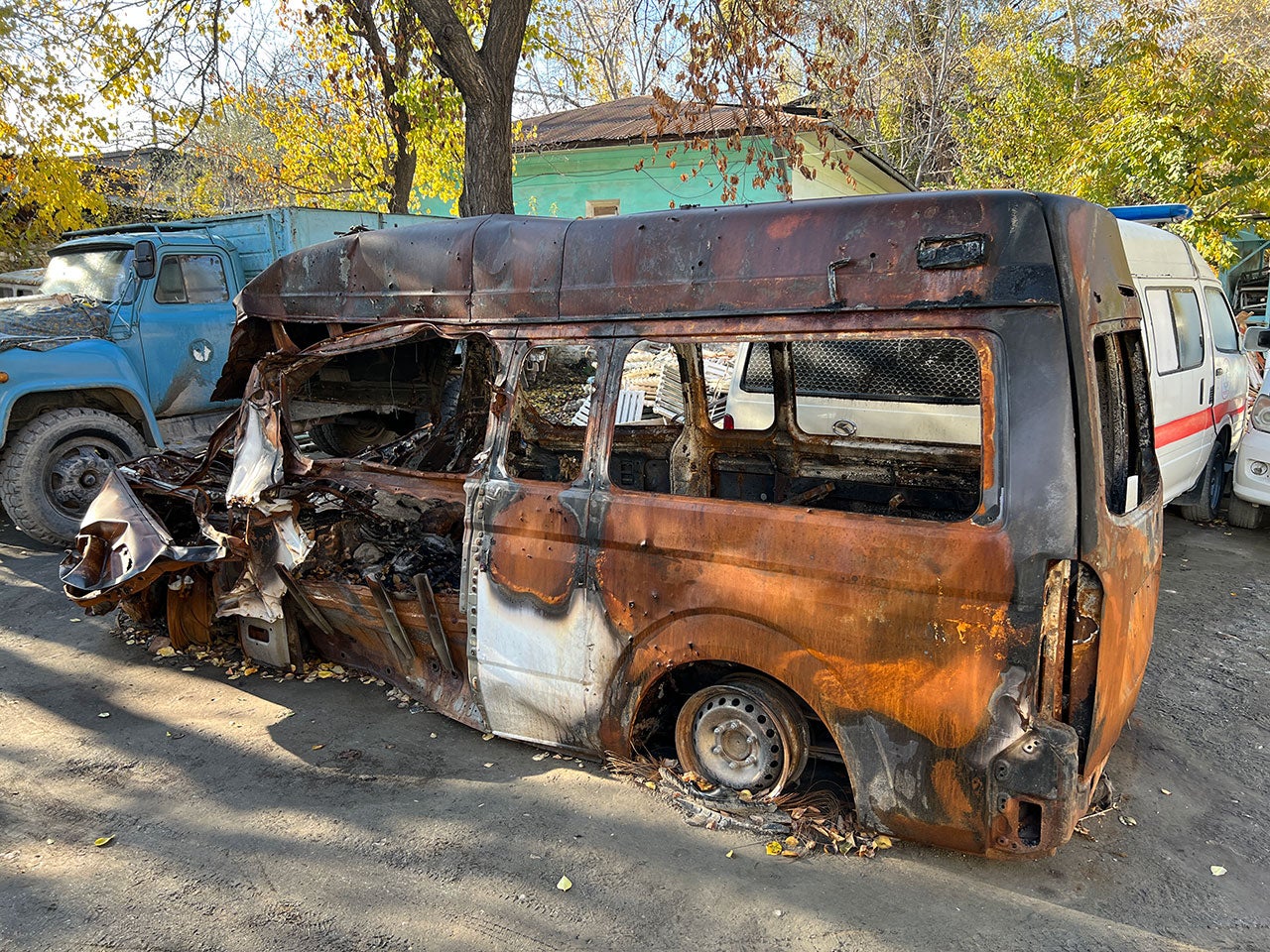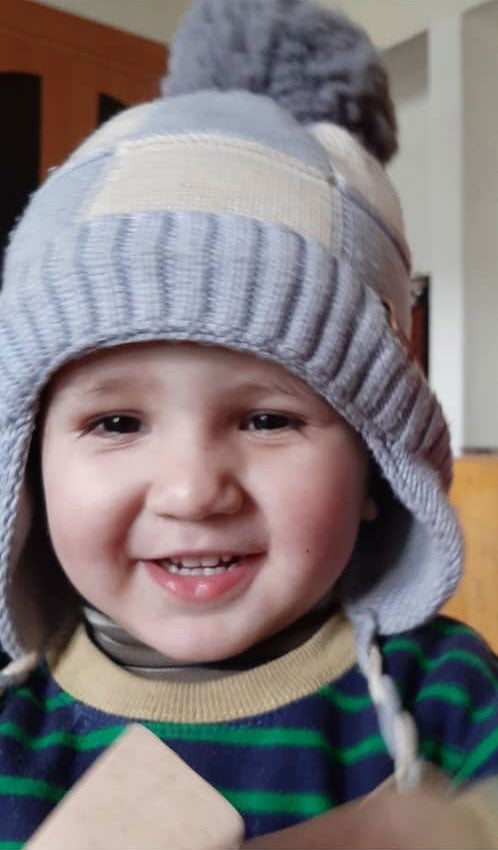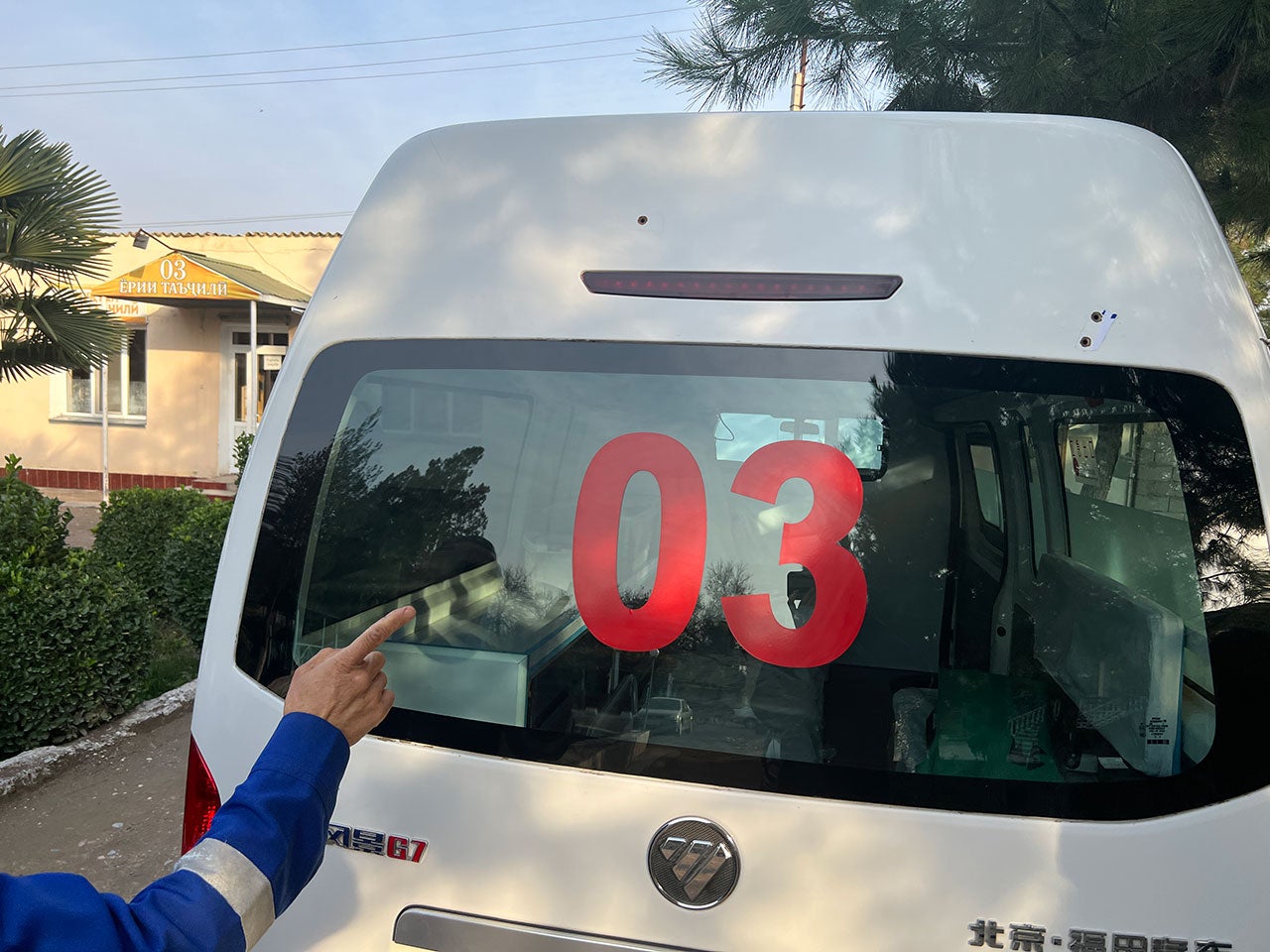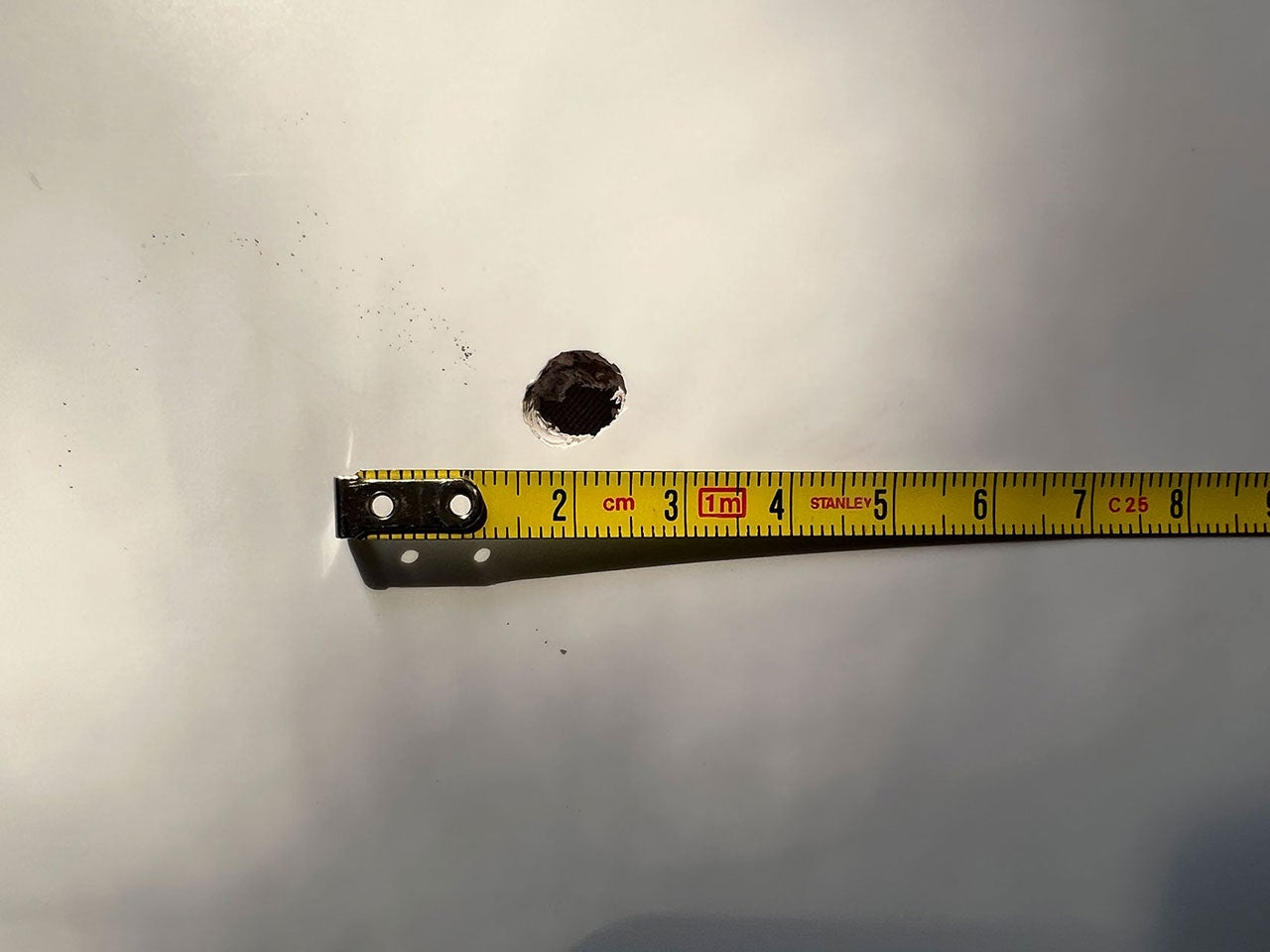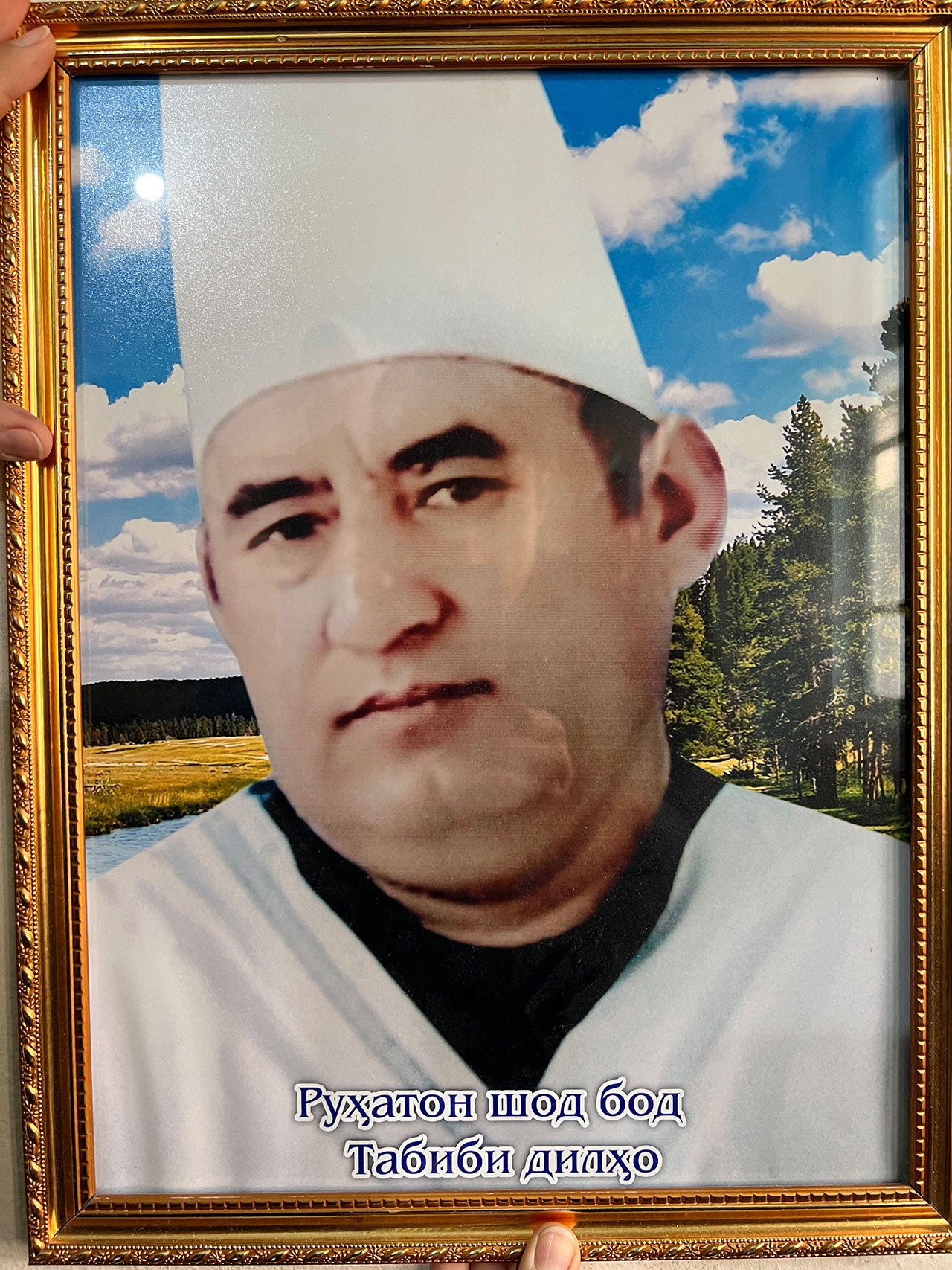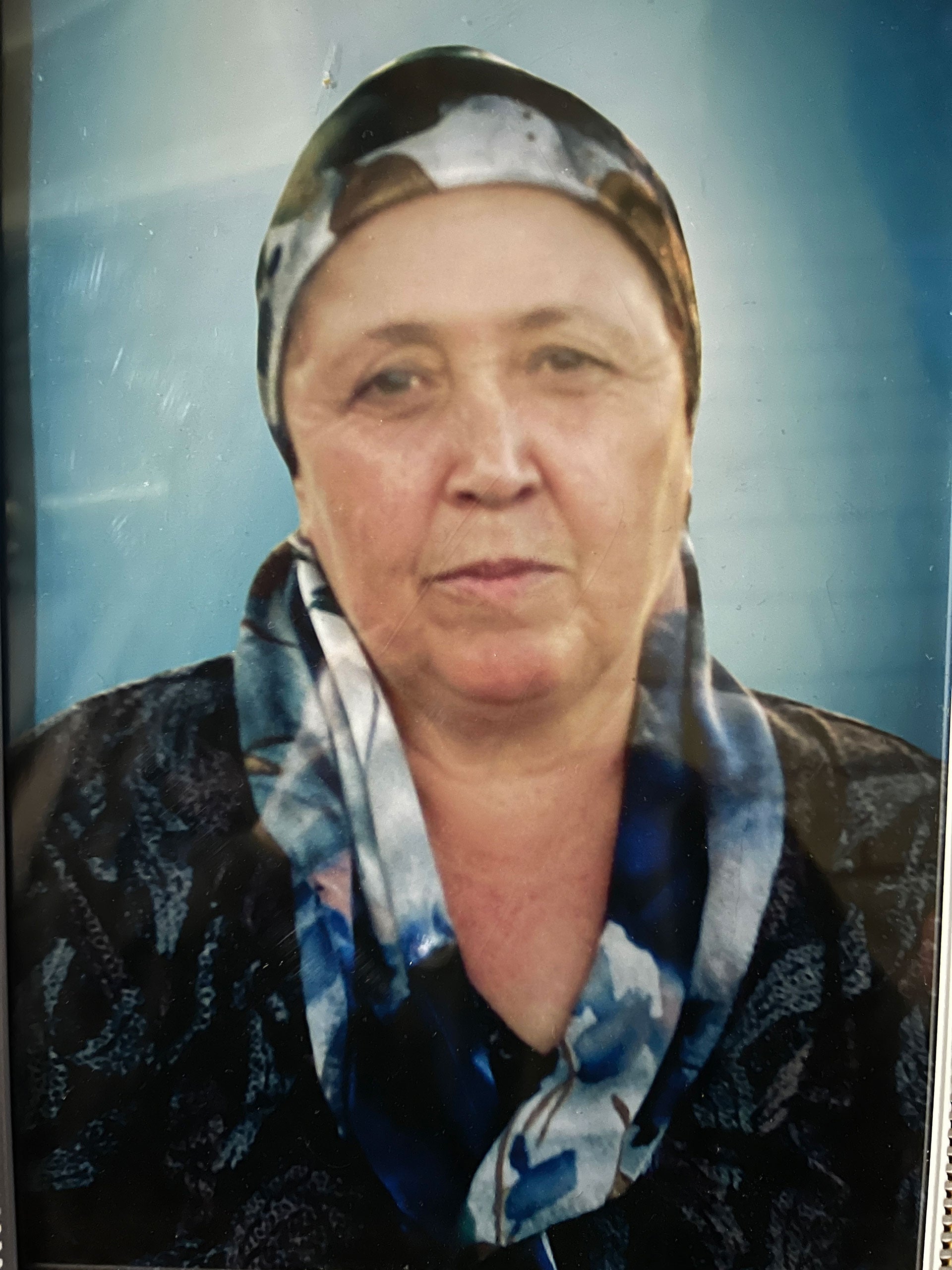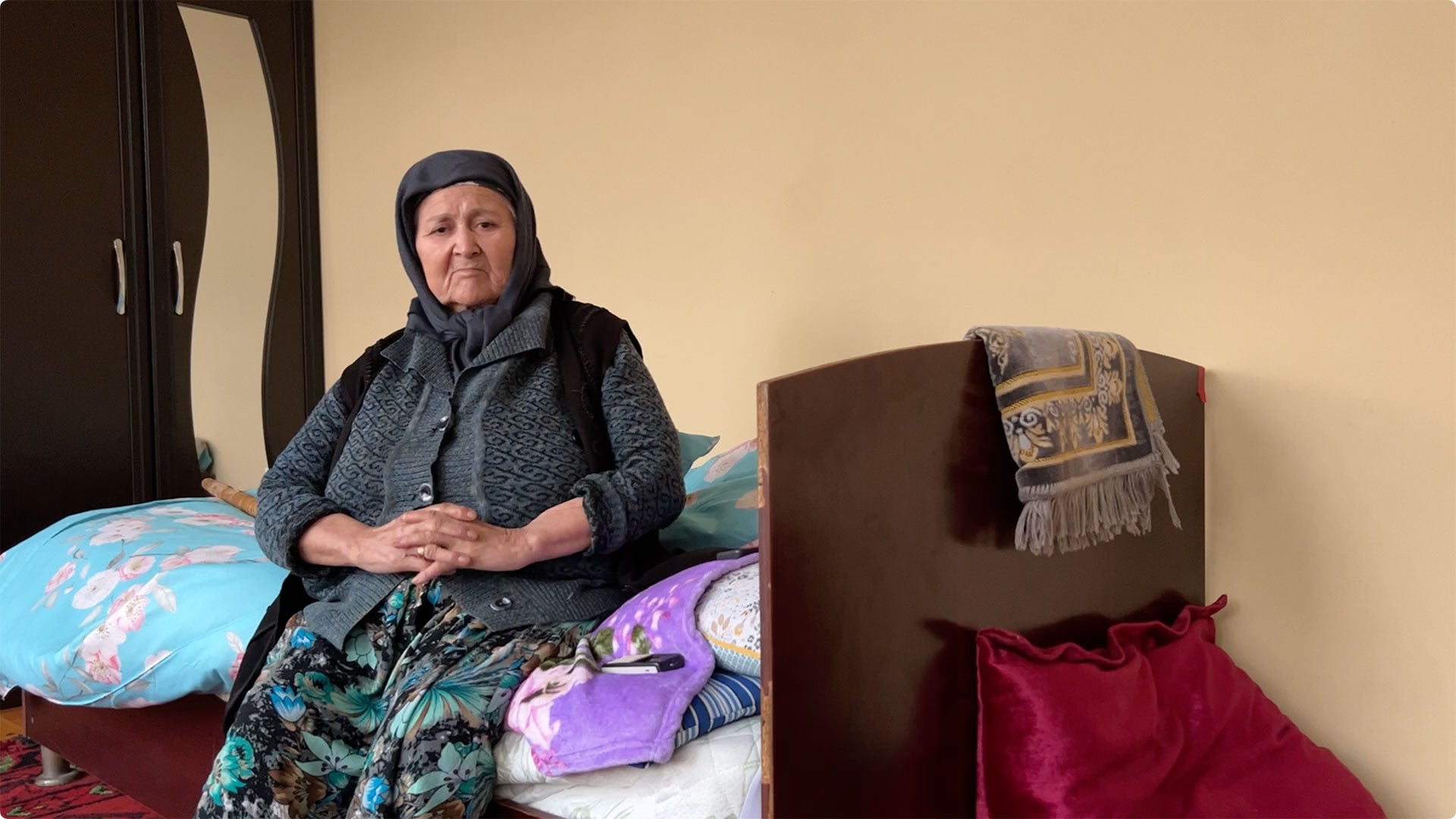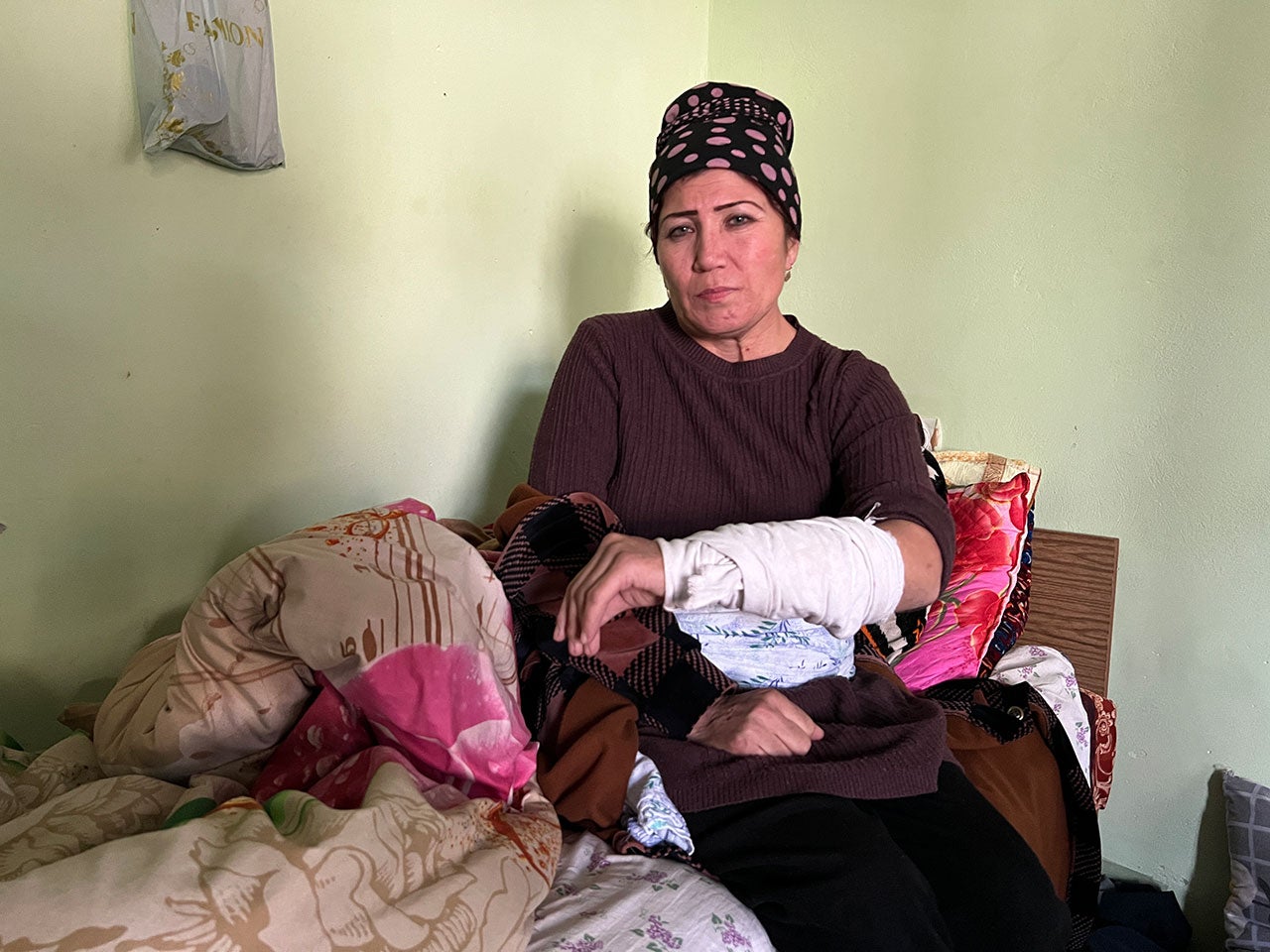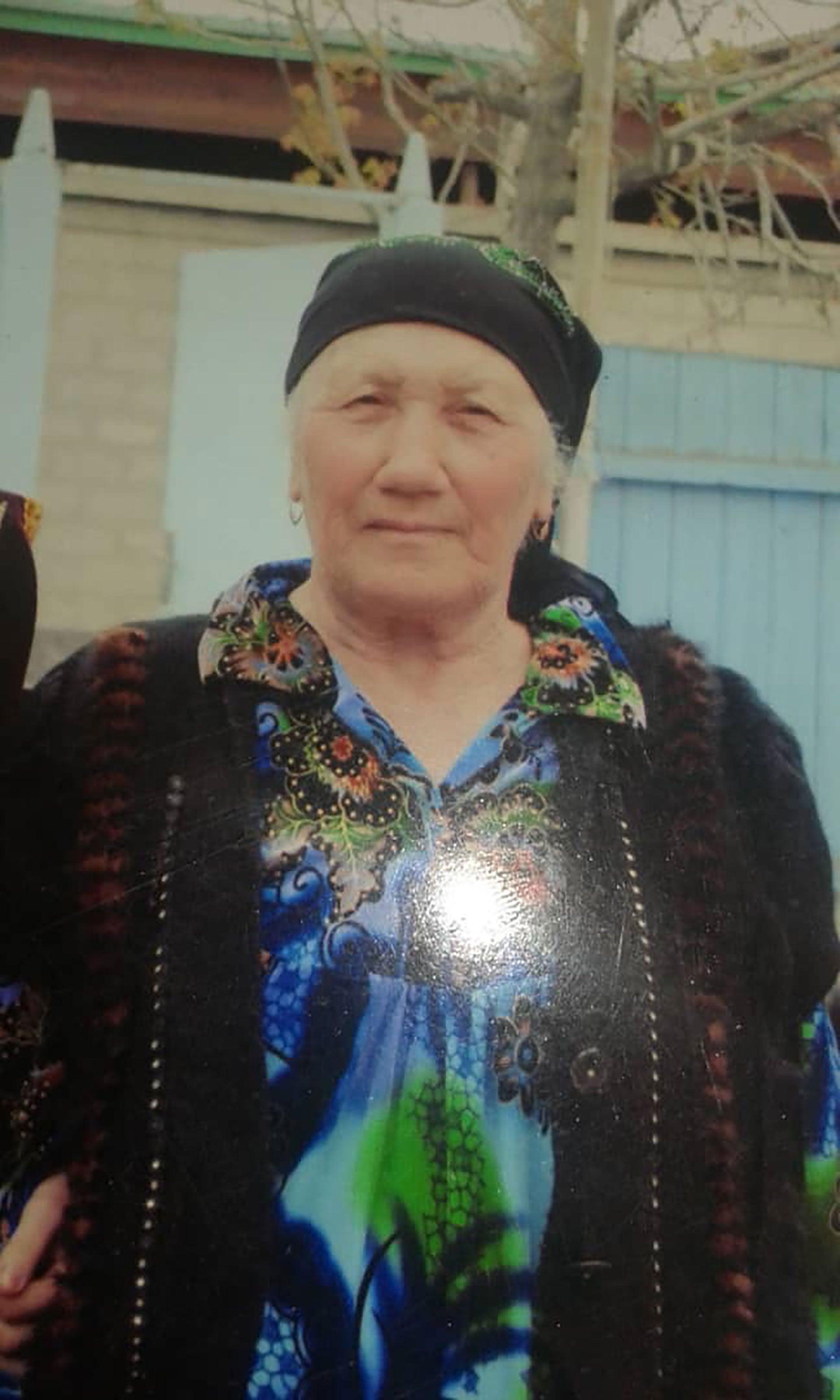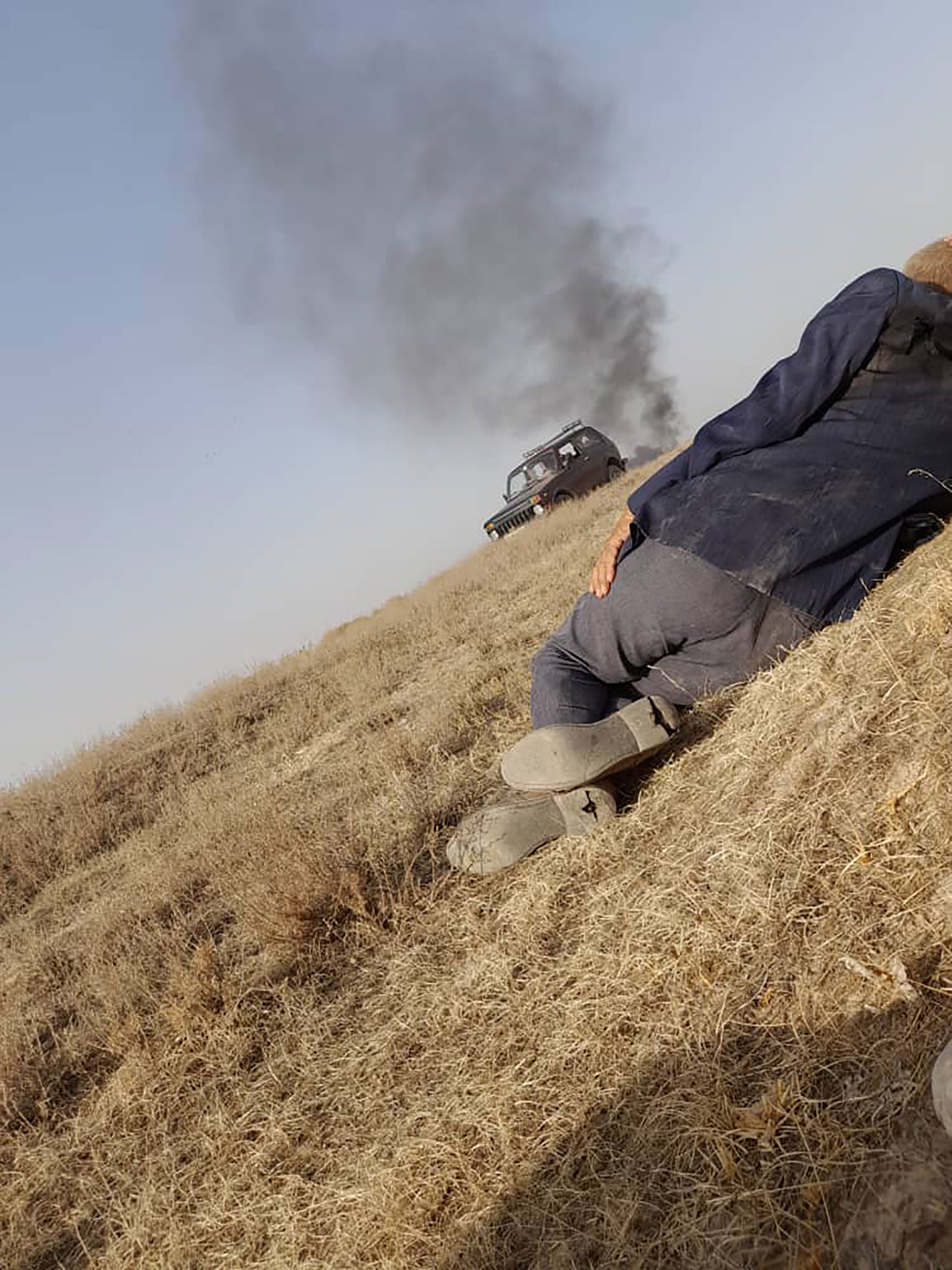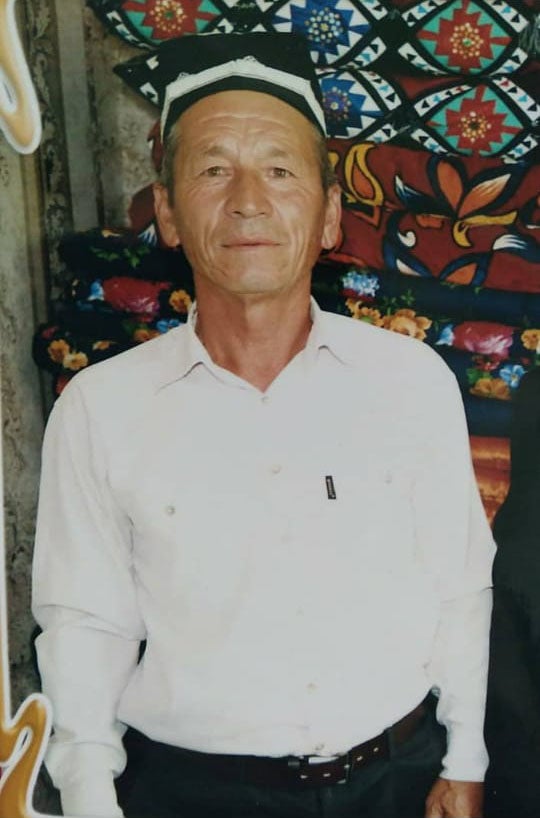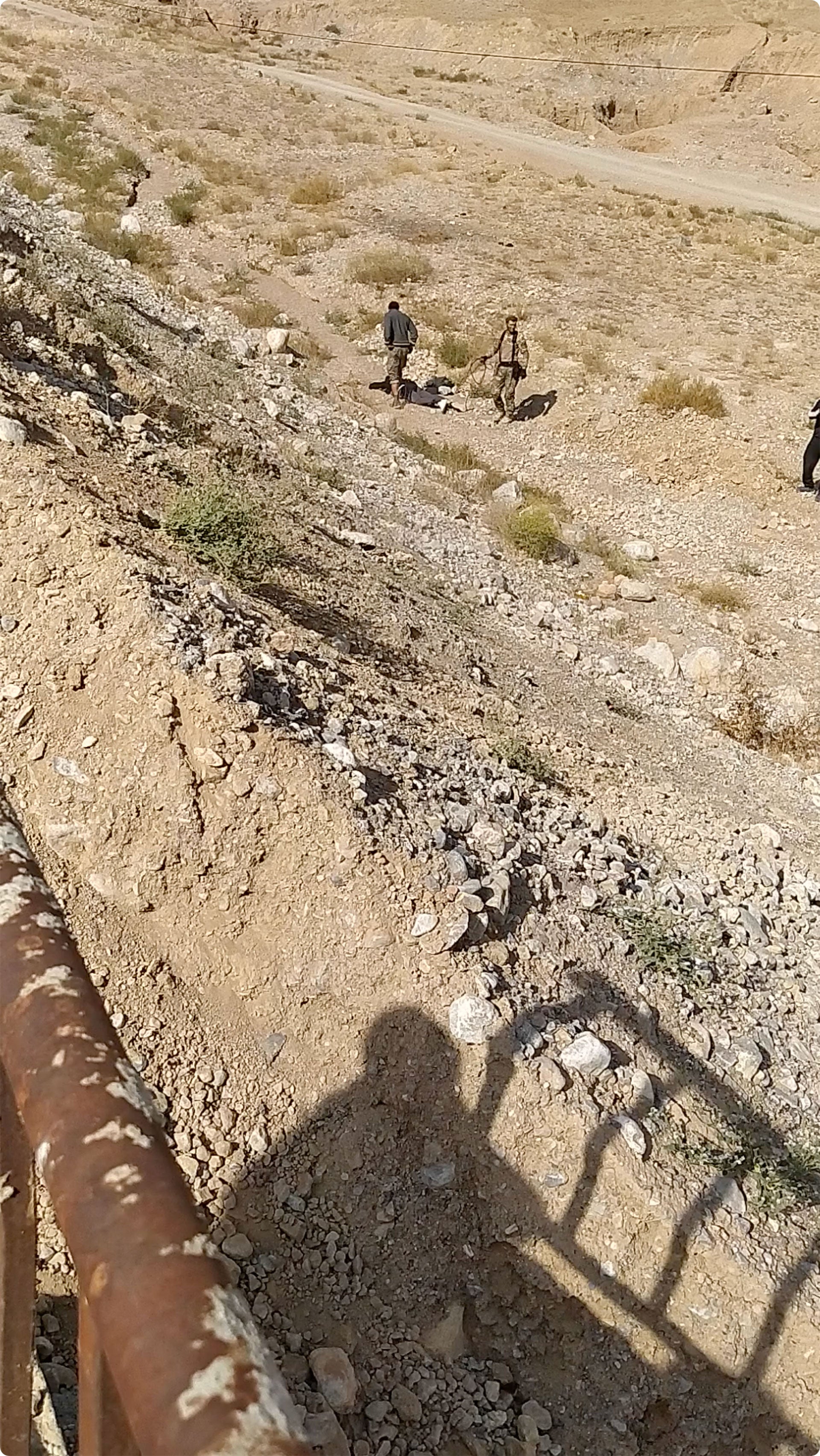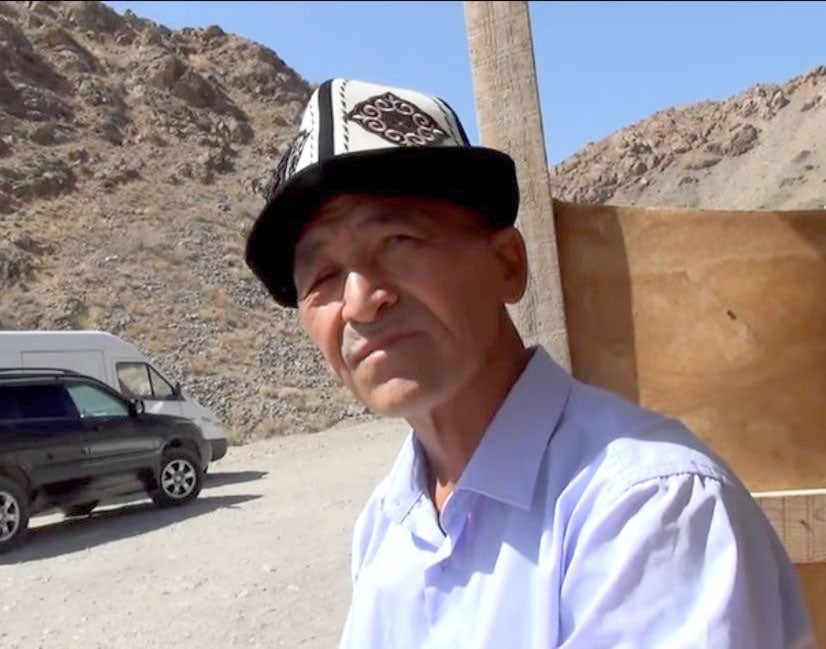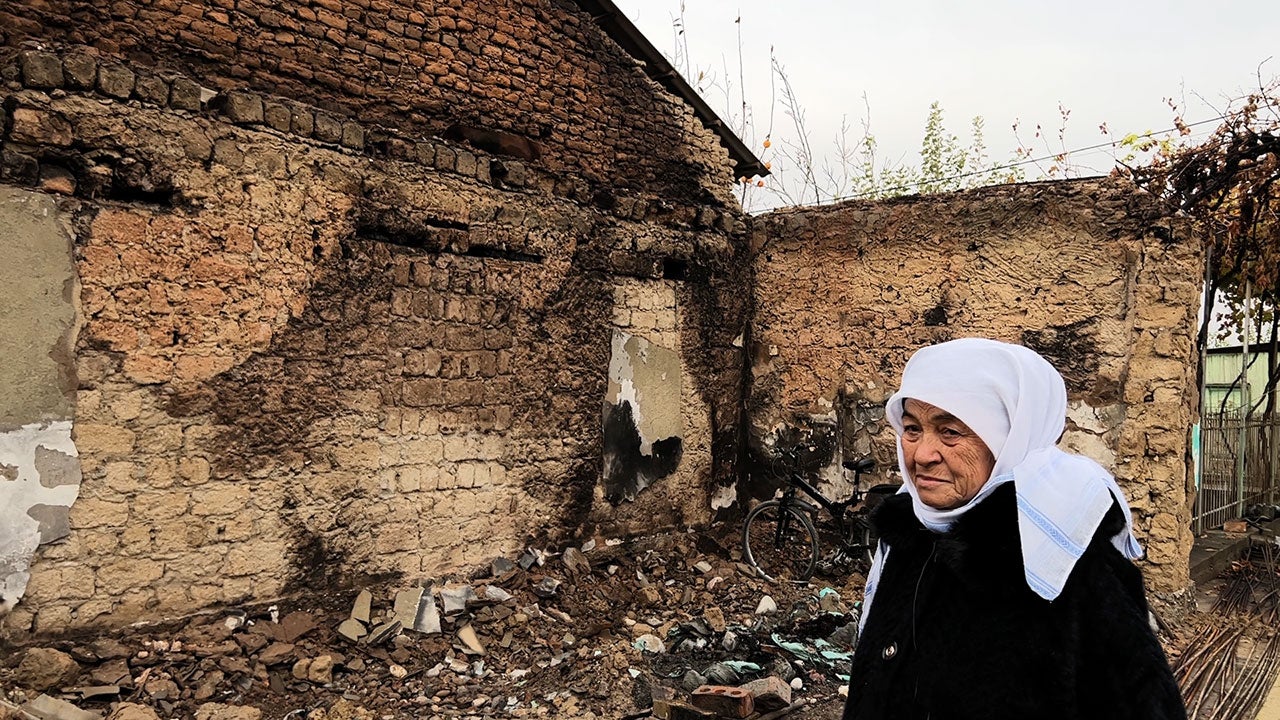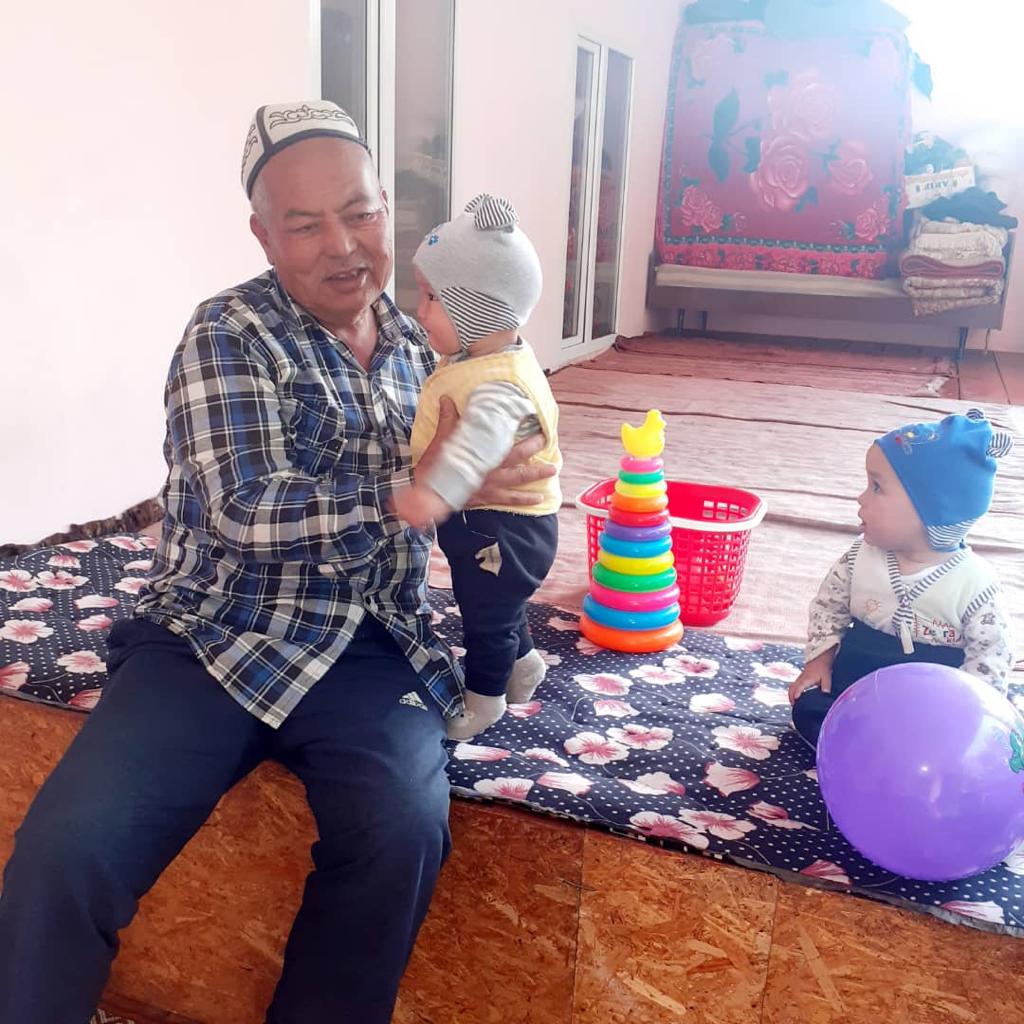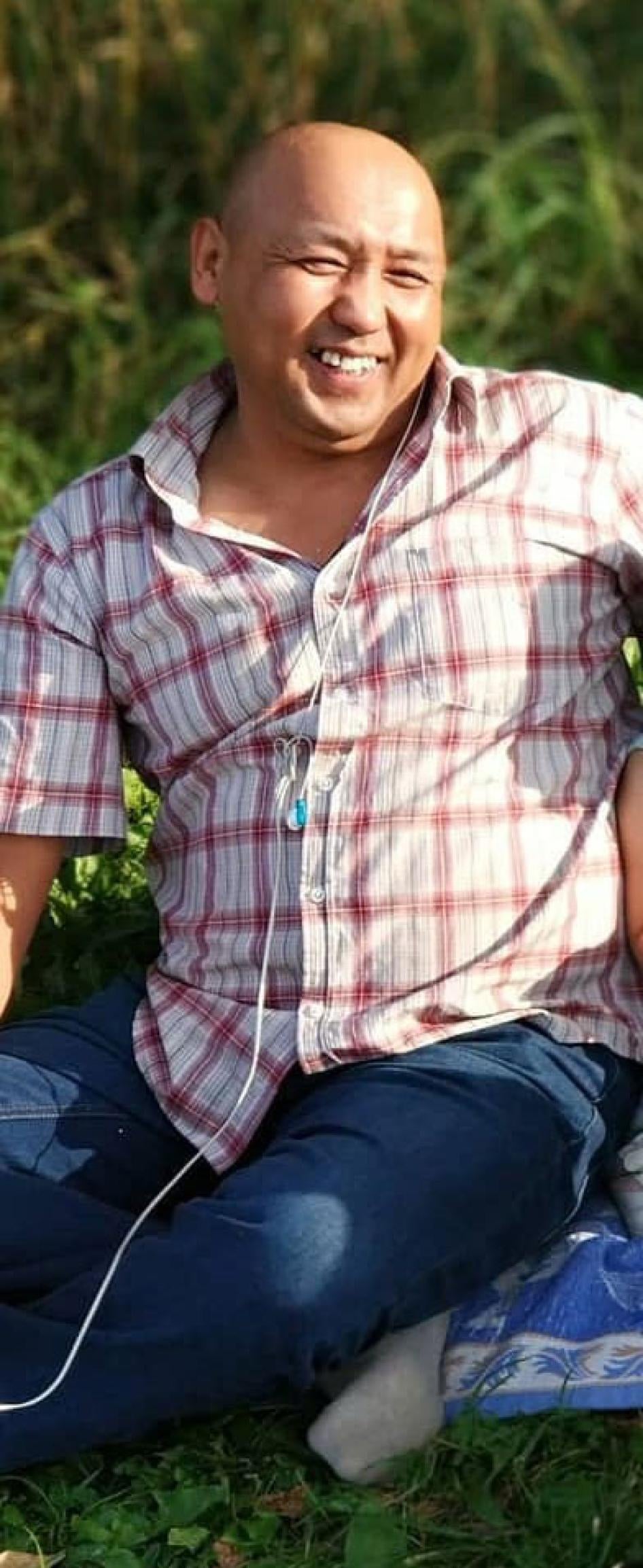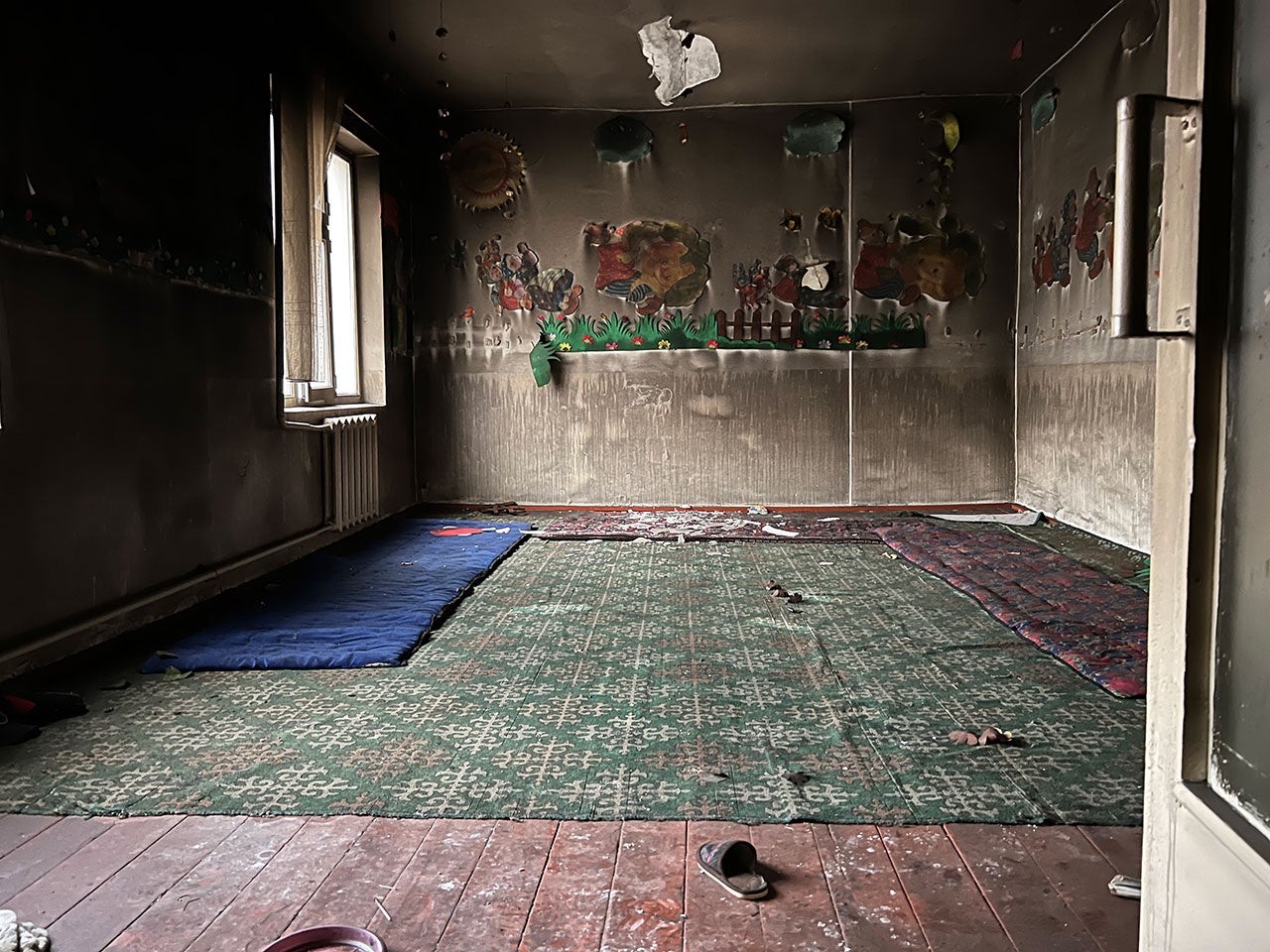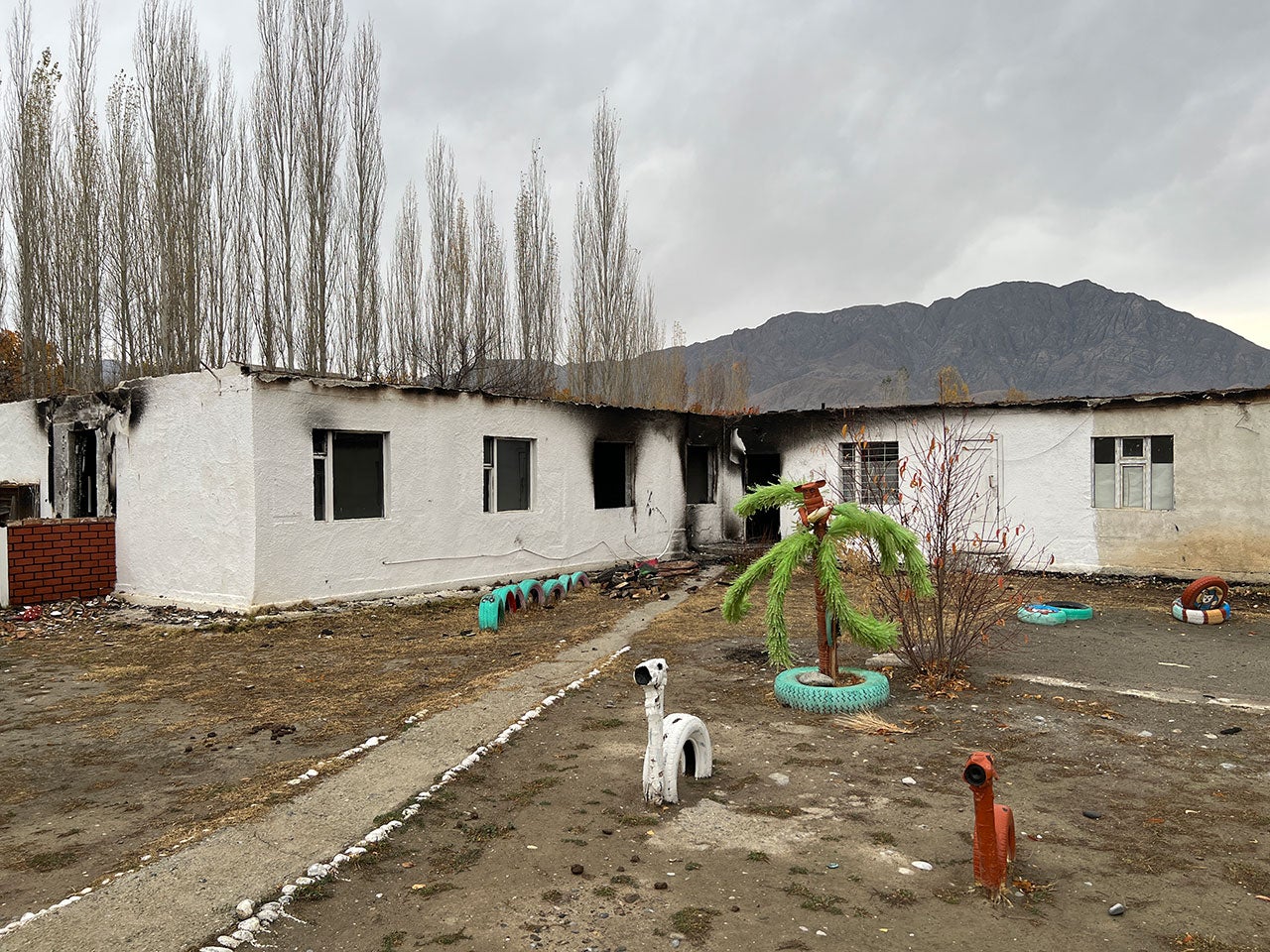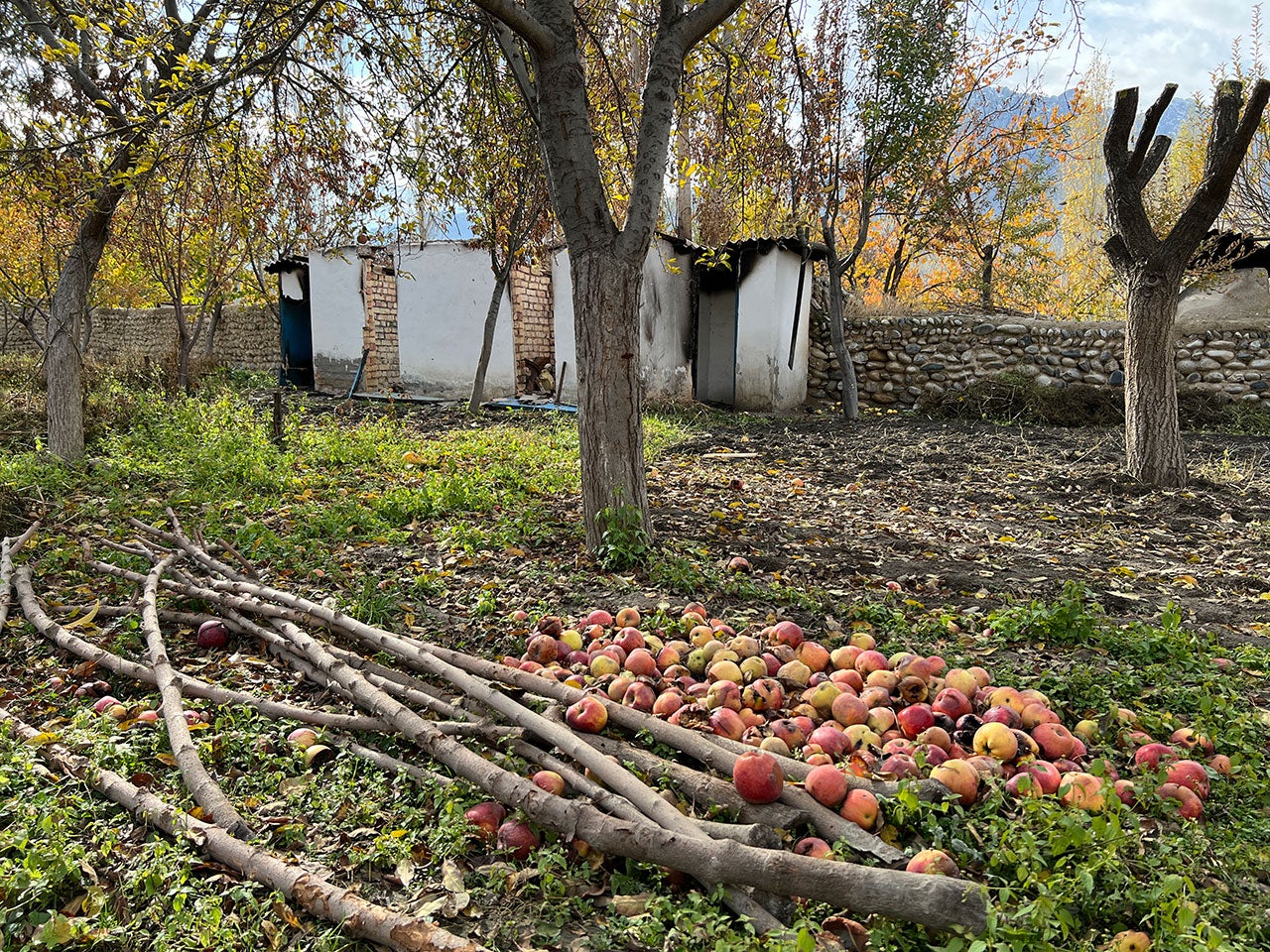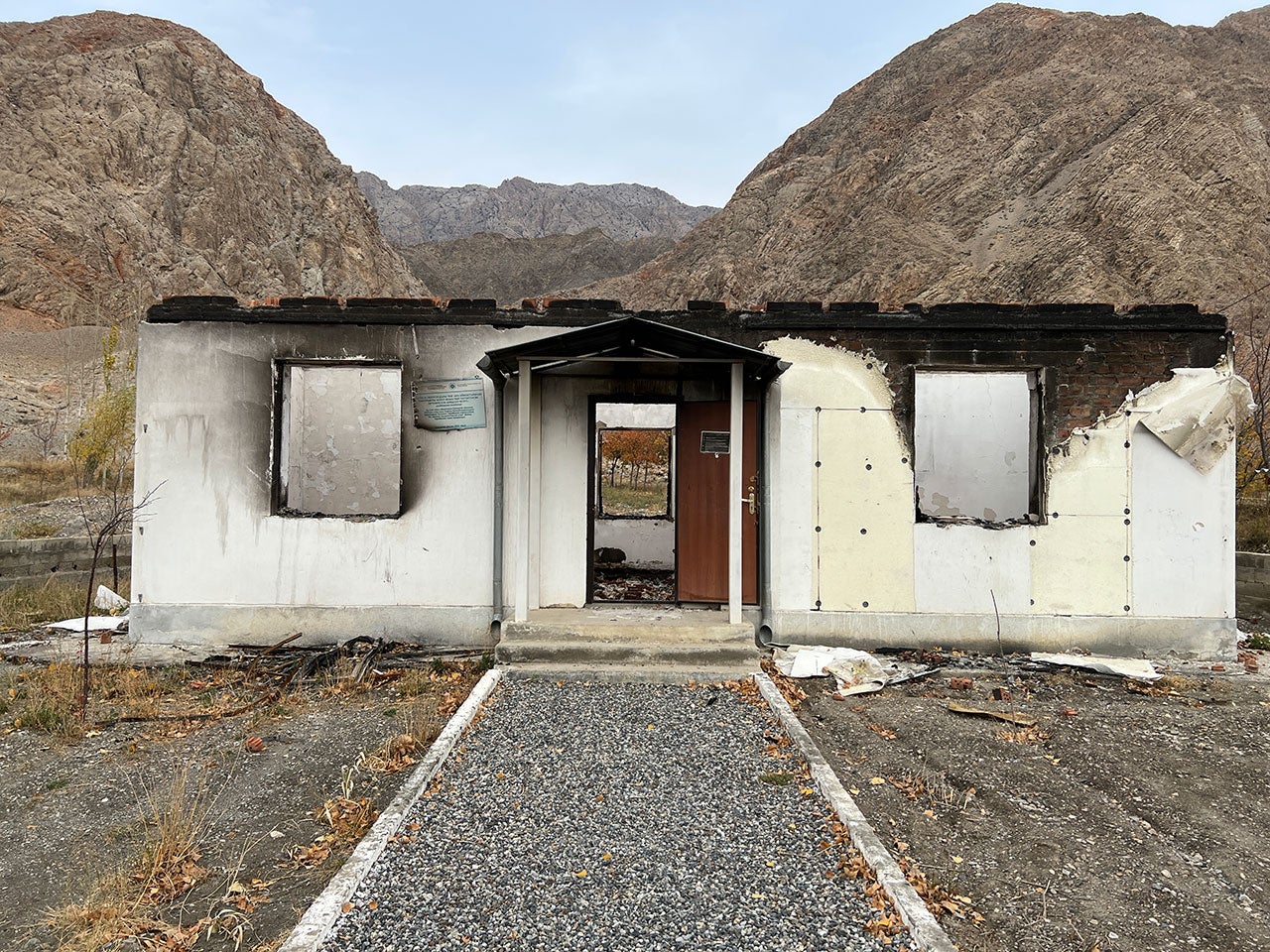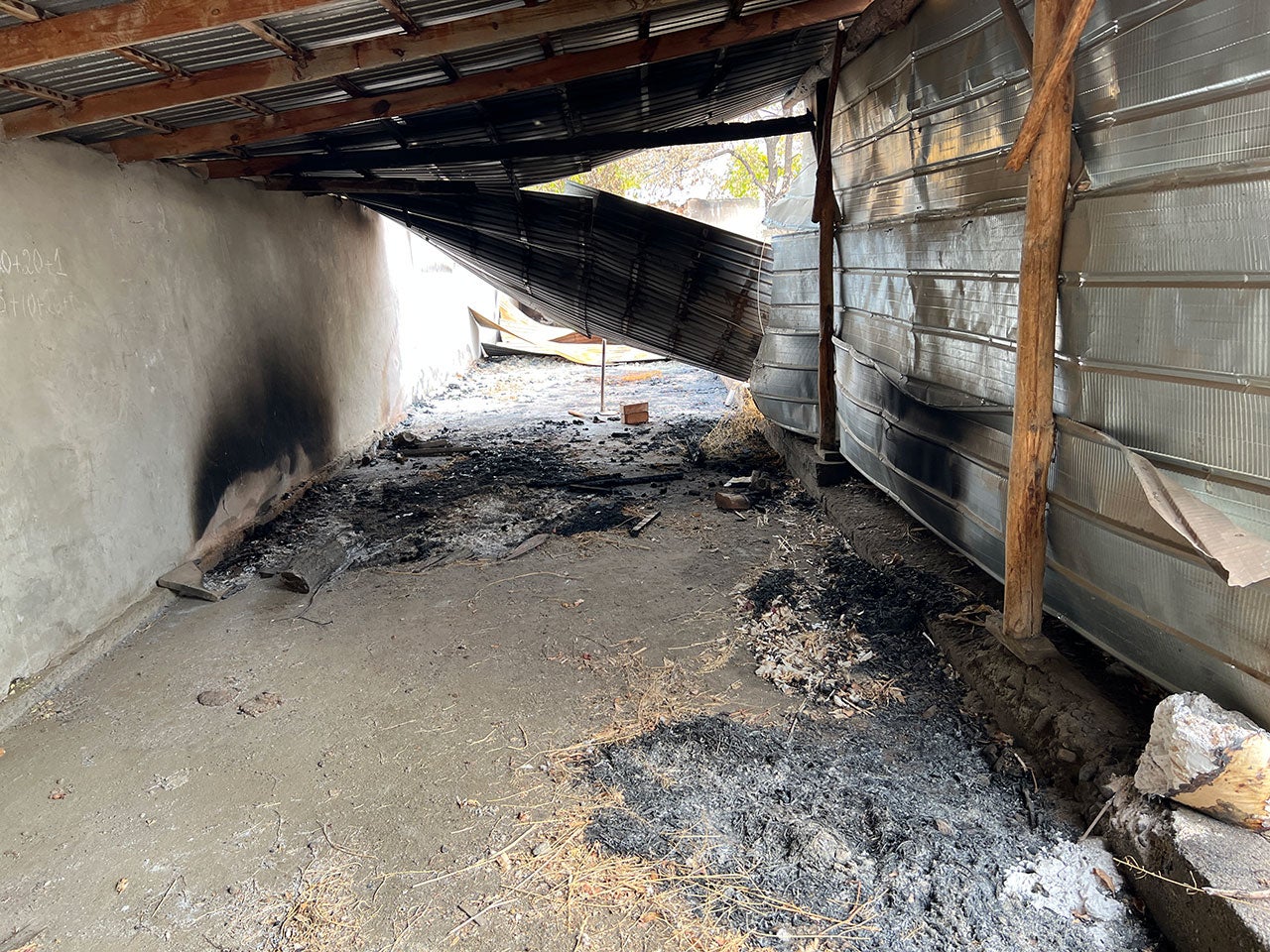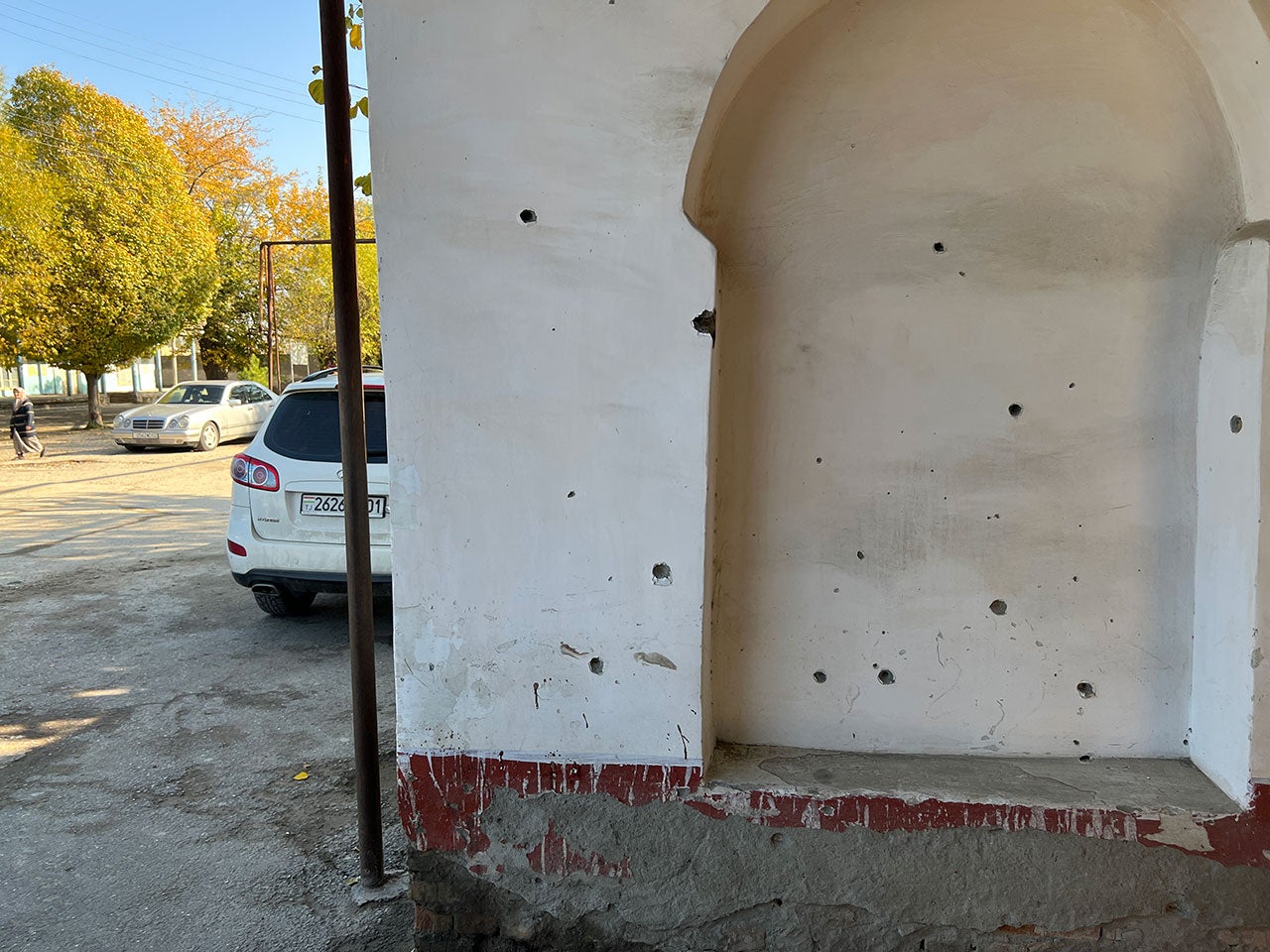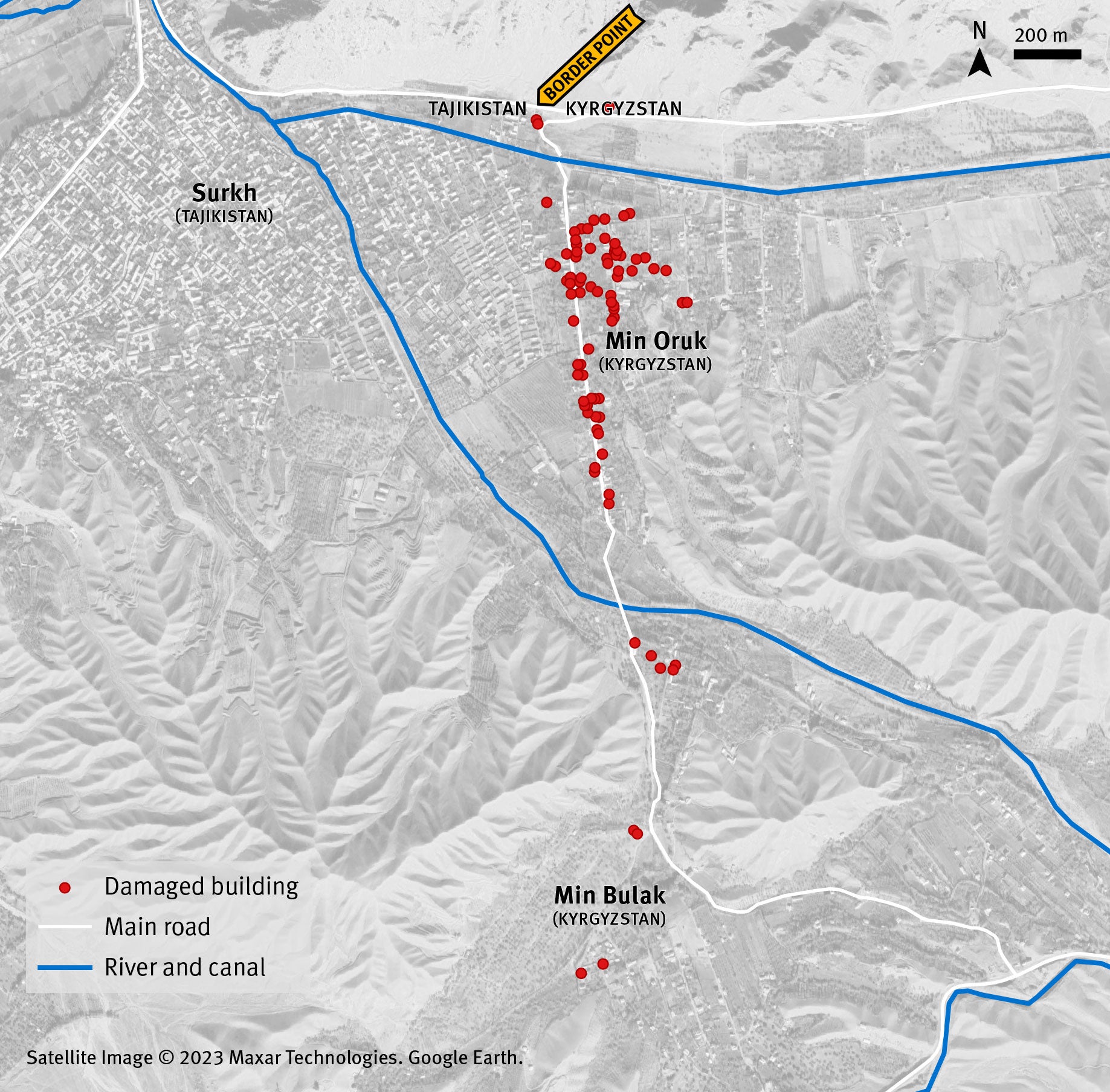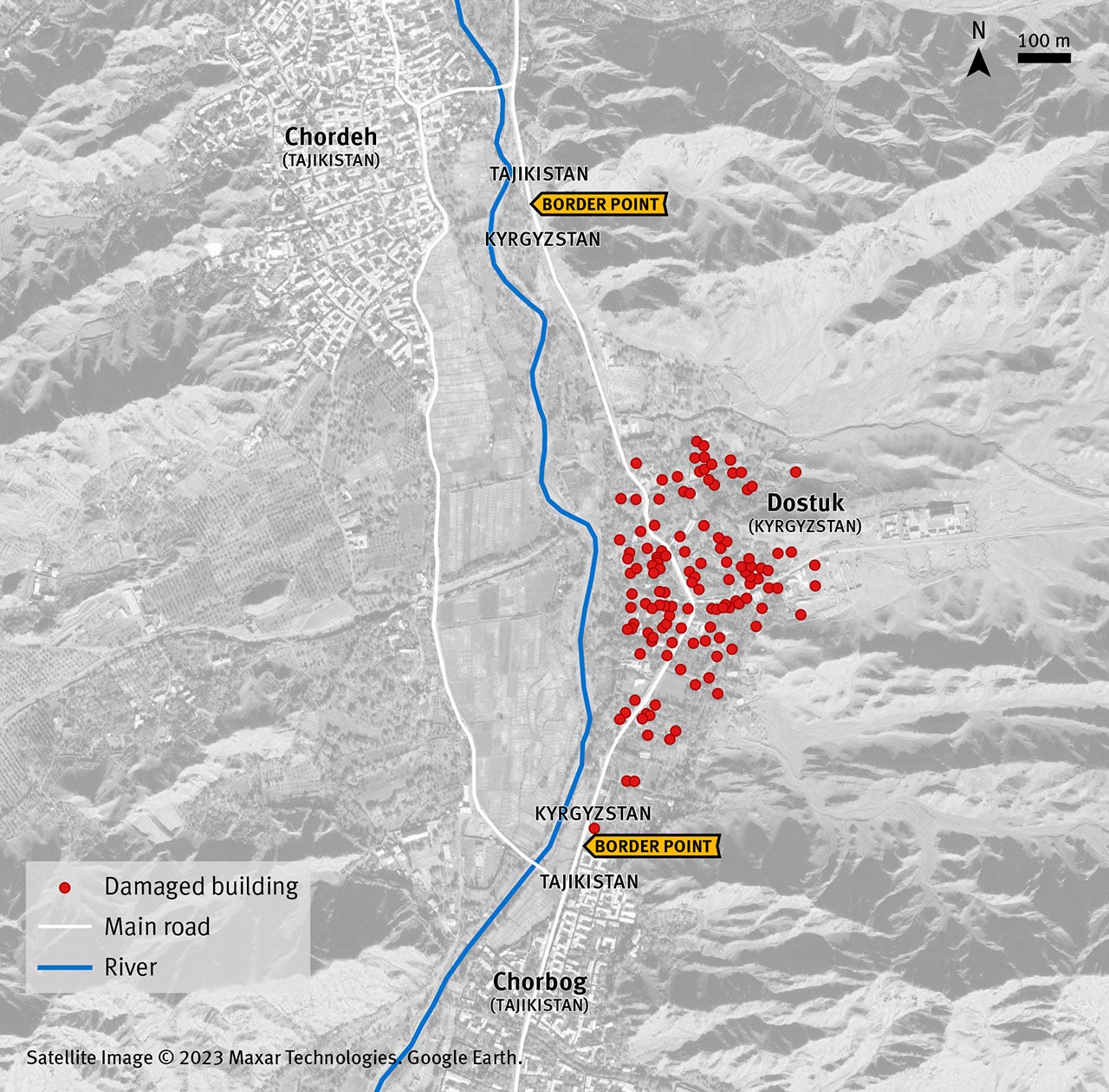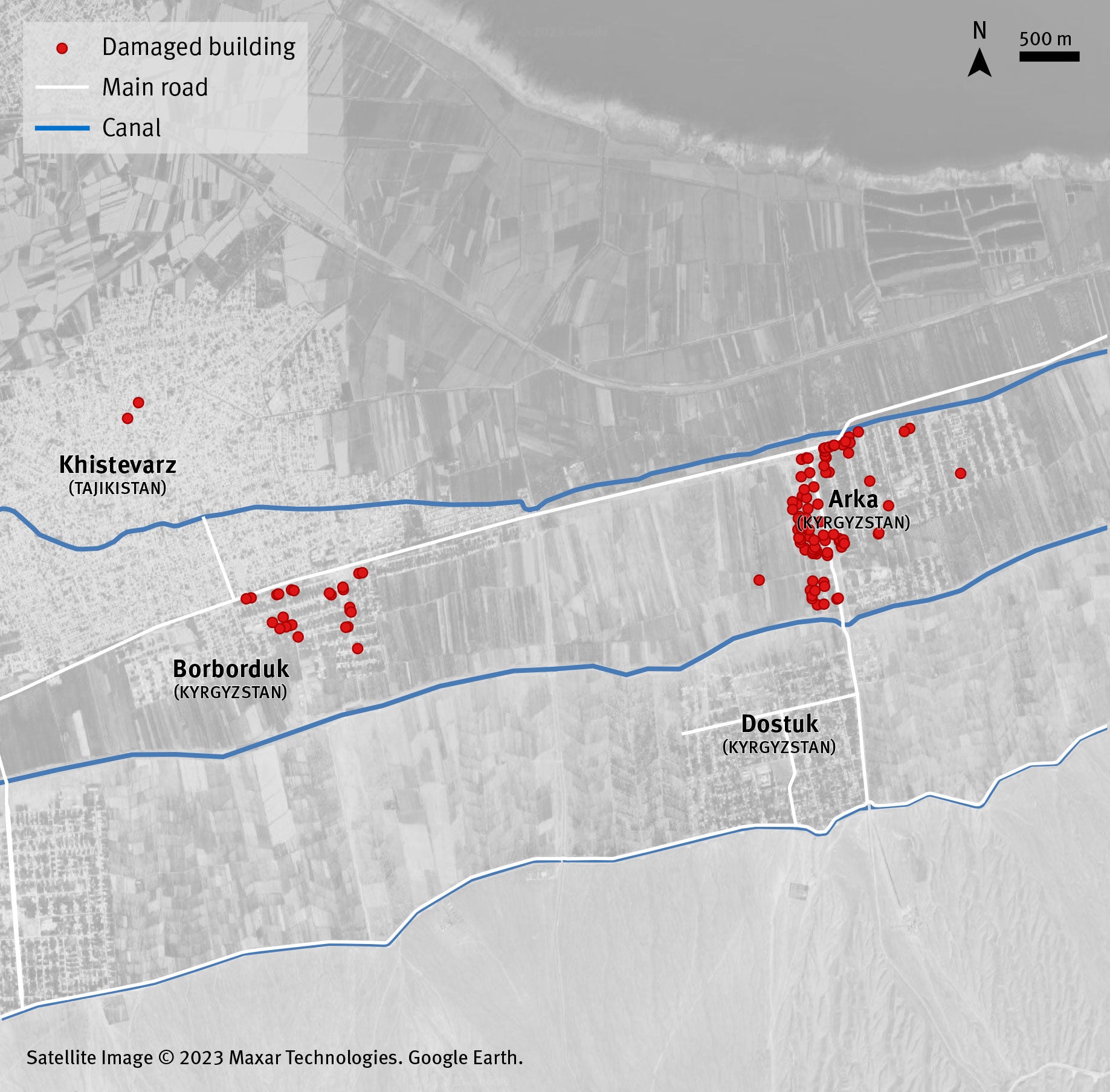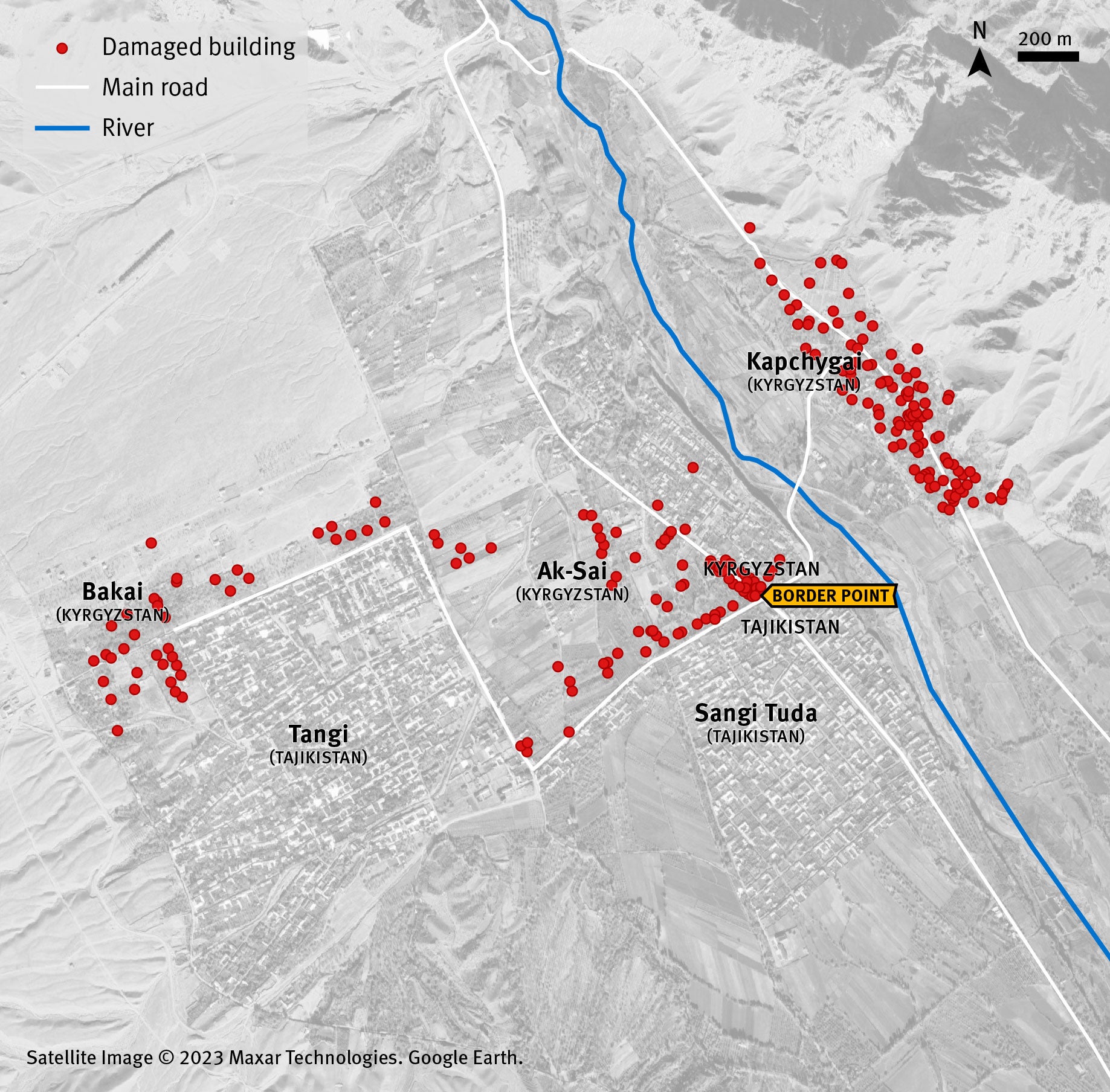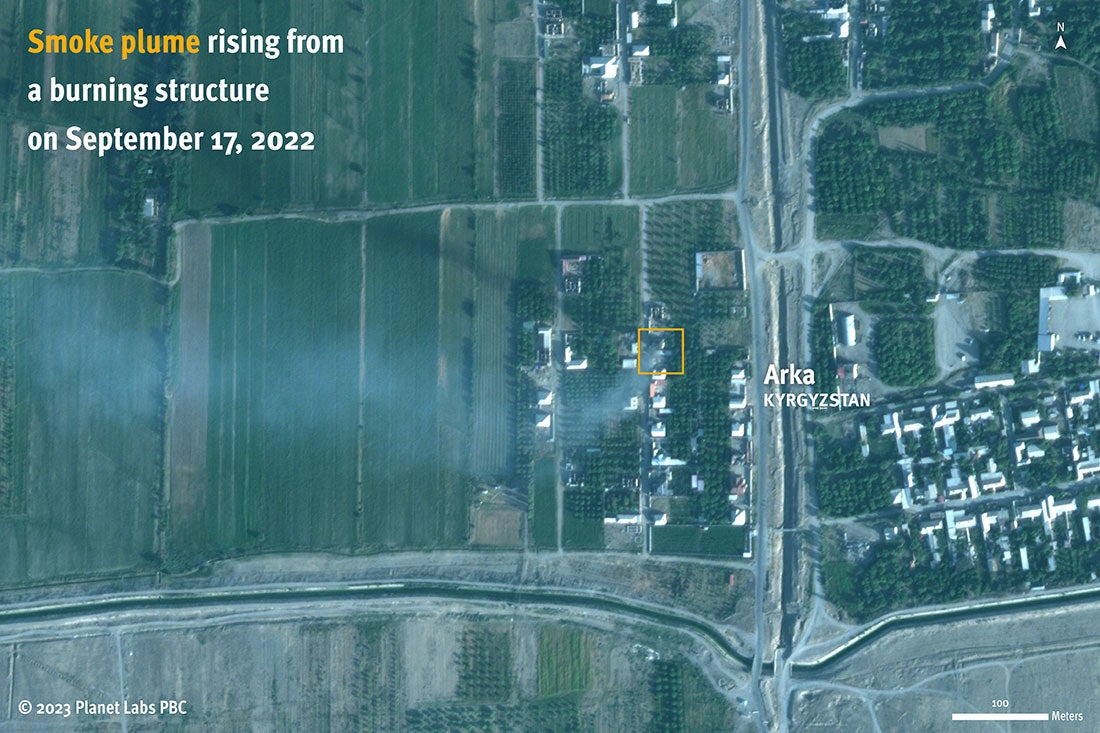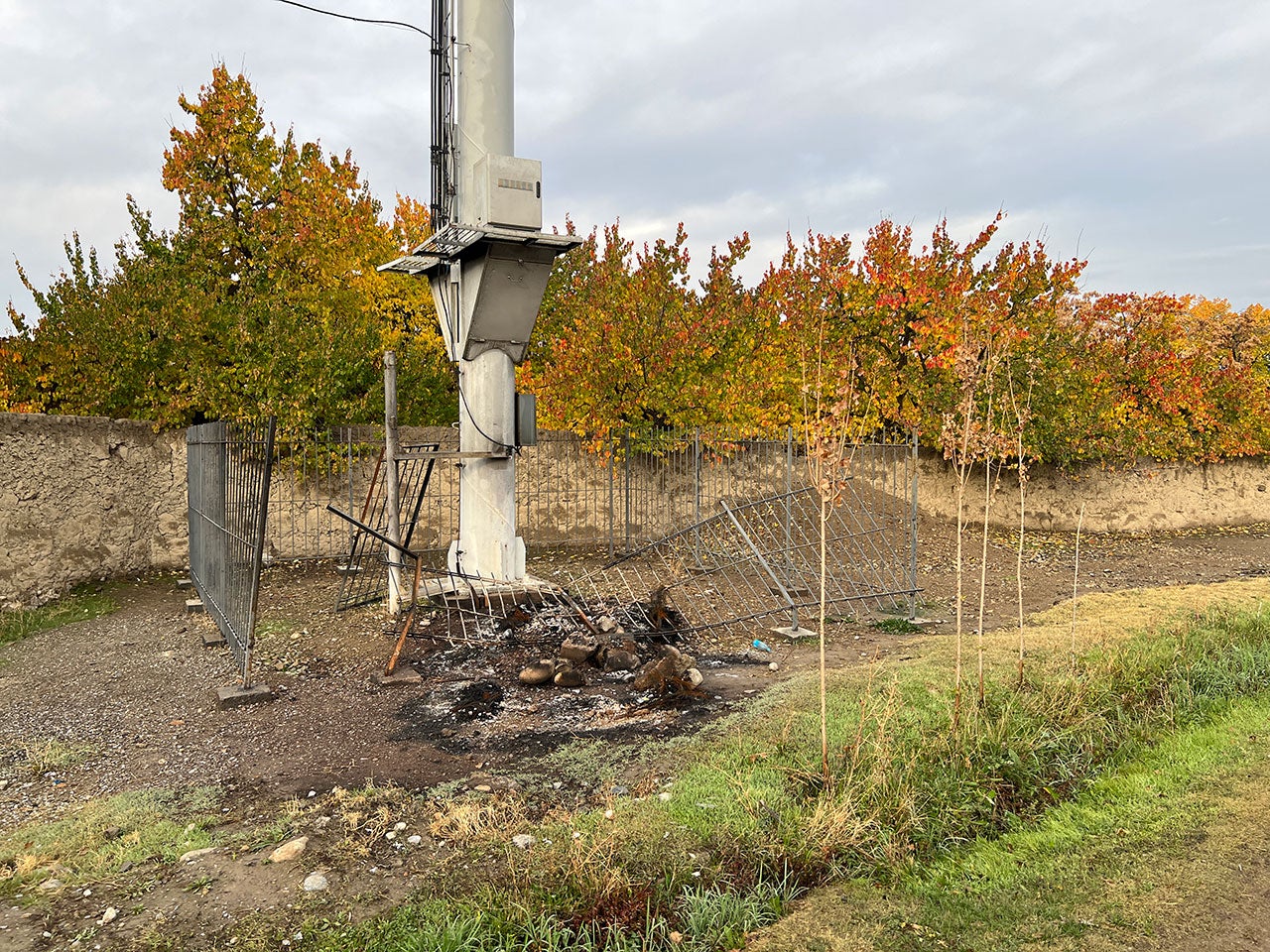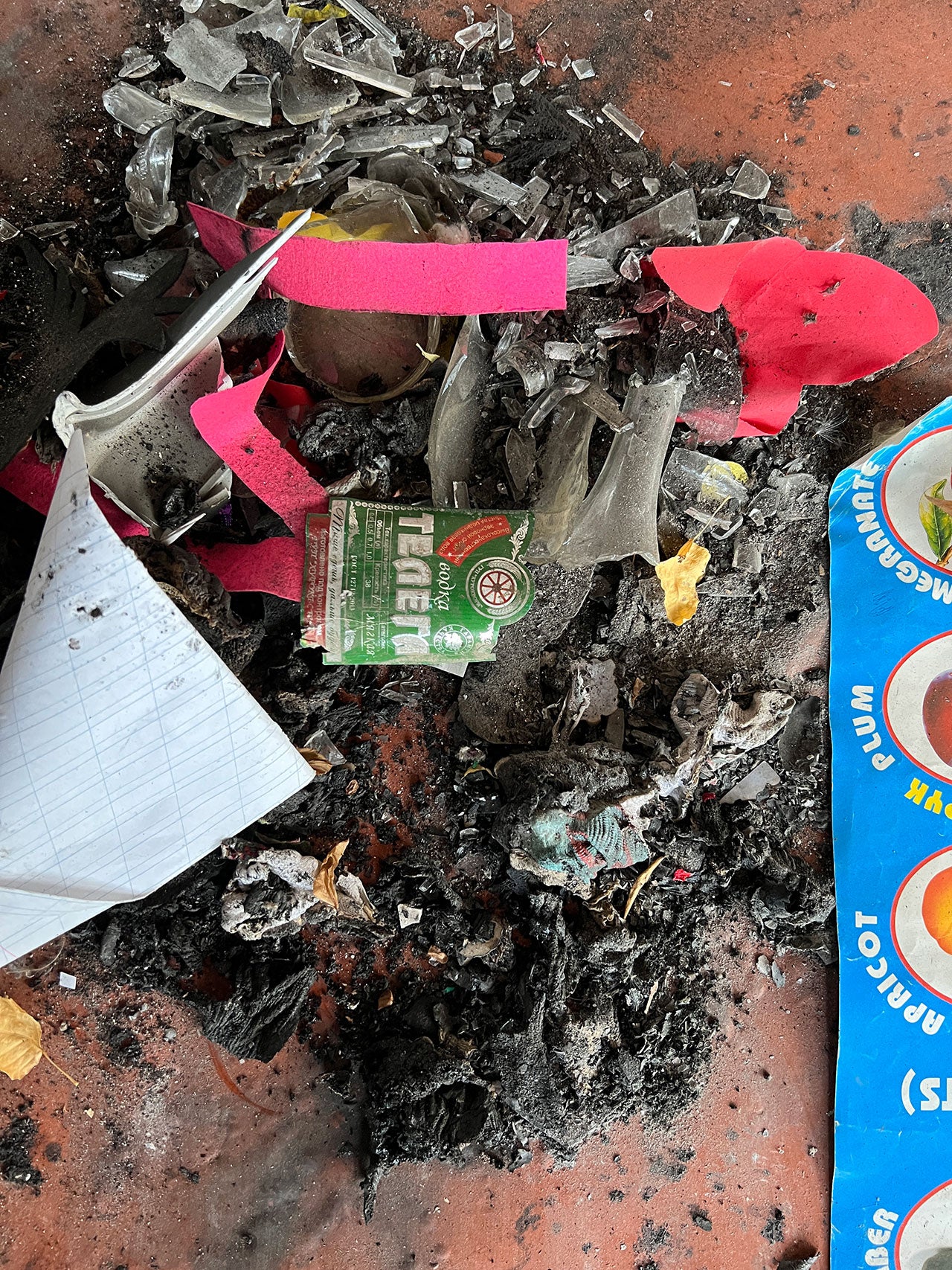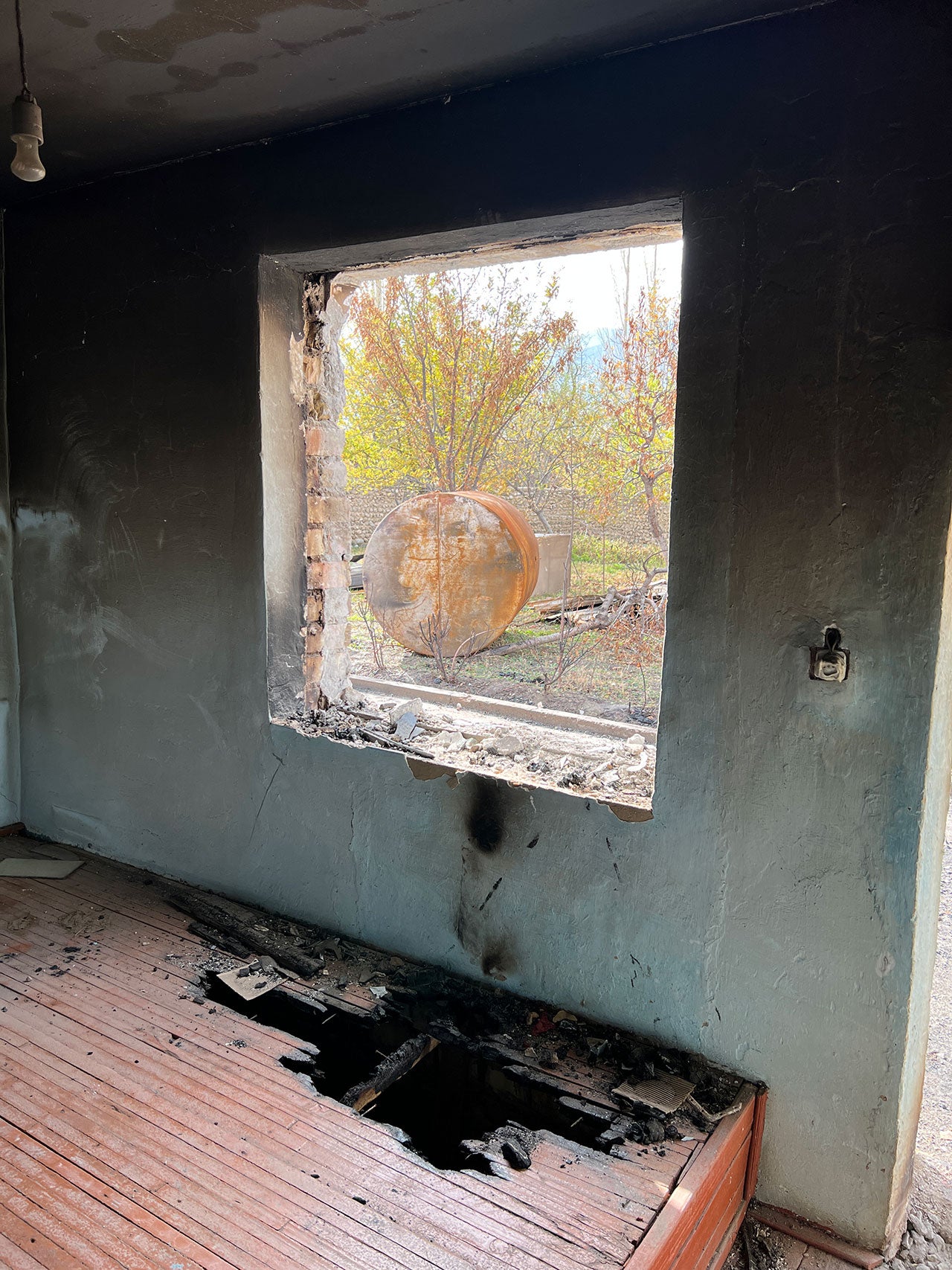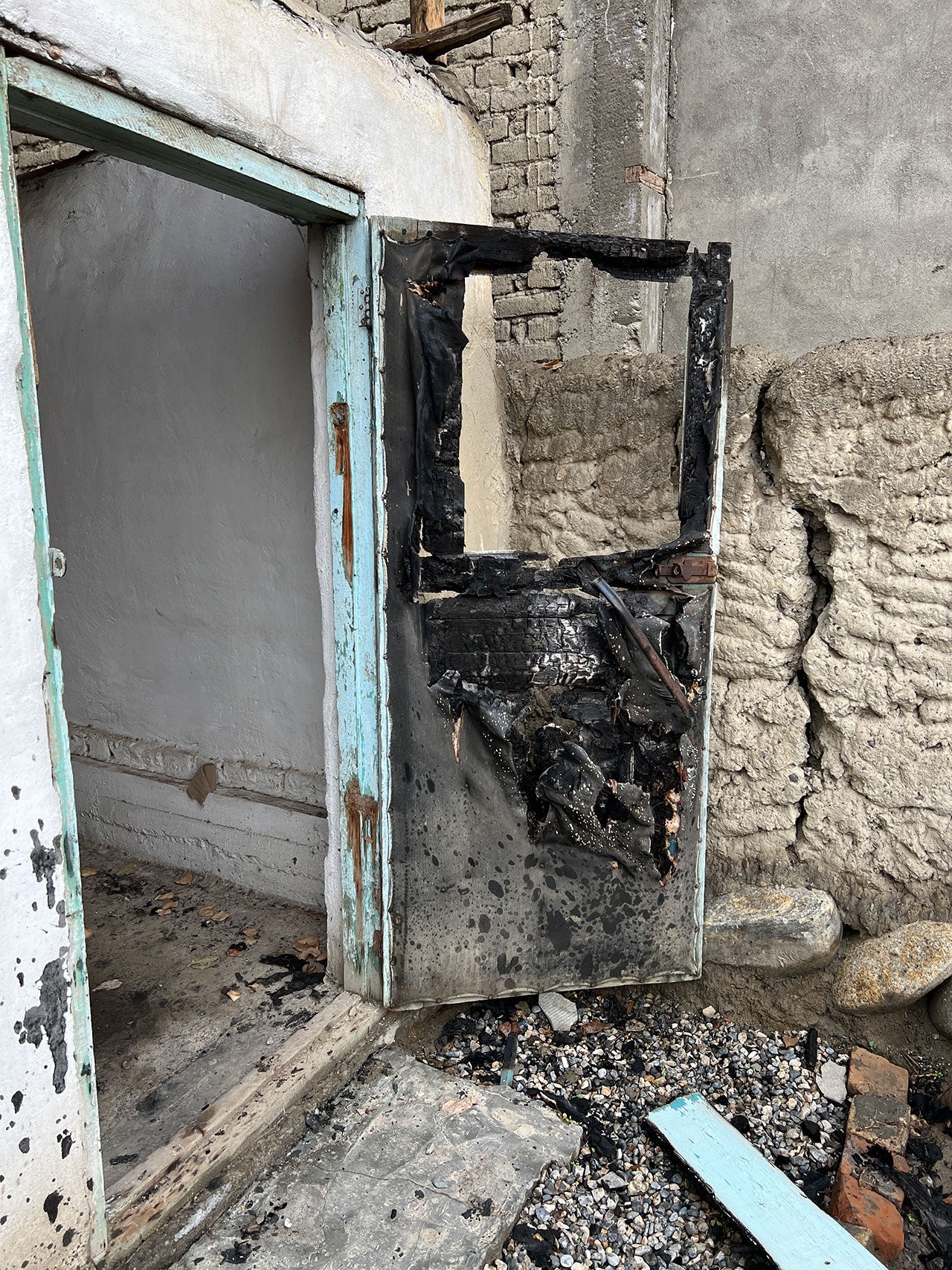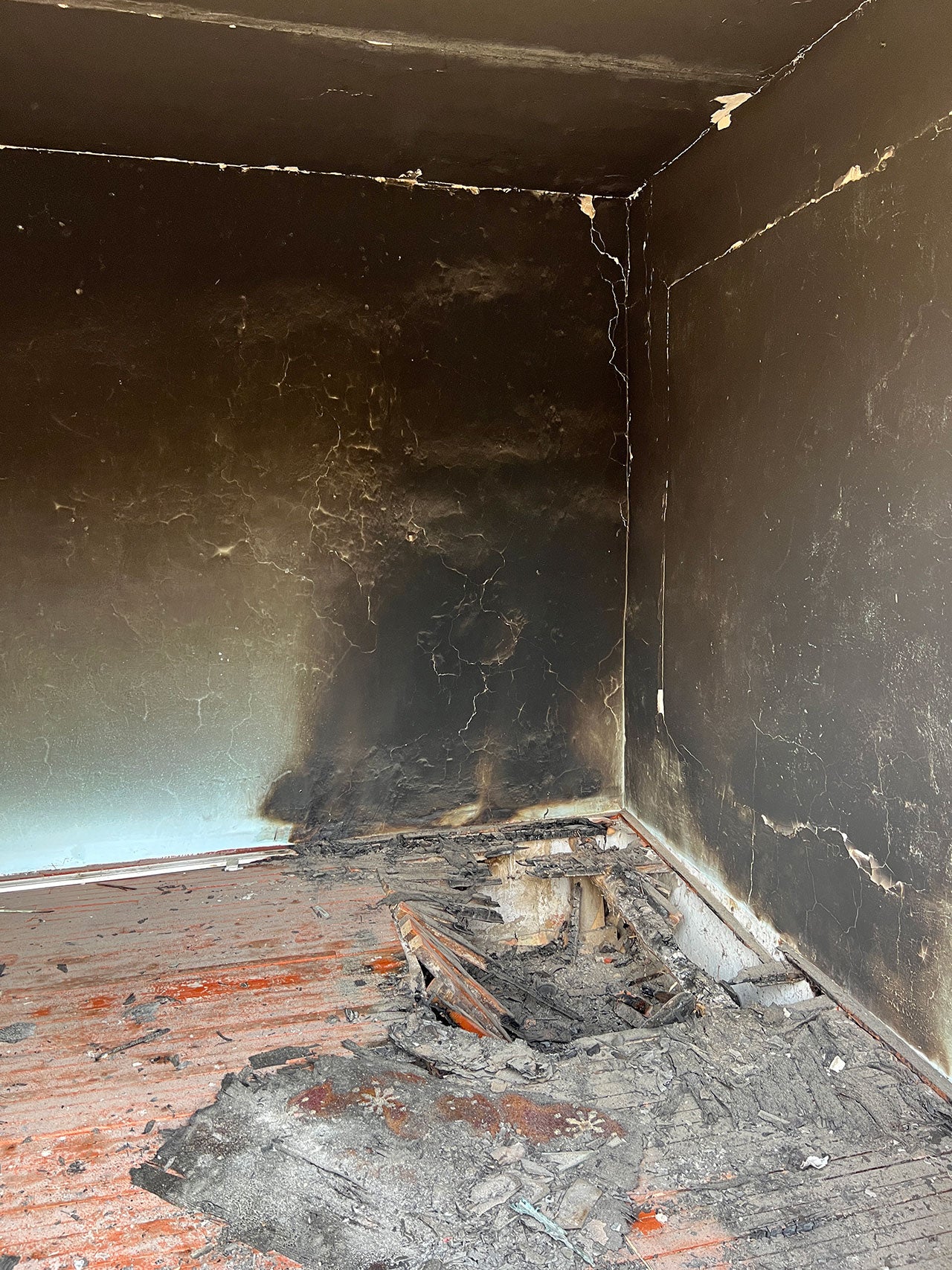May 2, 2023
“When We Moved, They Shot”
Laws of War Violations in the September 2022 Kyrgyzstan – Tajikistan Border Conflict
Summary
I heard a sound, a whistling. The whole square became yellow with smoke. People were flying… A lot of blood. A hand separated from the body.
- 40-year-old woman who survived the September 16 Kyrgyz laser-guided bomb attack on Ovchi Kal'acha, Tajikistan1
First they hit my son. He said to get down. Then they hit my husband. Then we got out of the car and lay down close to the ditch…. When we moved, they shot at us. Bullets were flying above us.
- 63-year-old woman from Kyrgyzstan whose family’s car was attacked by Tajik soldiers as they fled the fighting in the village Maksat on September 162
For four days in September 2022, forces from Kyrgyzstan and Tajikistan engaged in an armed conflict along a disputed stretch of border that has long been a point of contention between the two countries. This report documents serious violations of the laws of war by both sides during that time that resulted in civilians being unlawfully injured and killed and significant damage to homes, schools, medical facilities, and shops.
Kyrgyz forces shot at ambulances and private cars carrying families trying to flee and dropped a laser-guided bomb on a town square, killing at least 10 civilians. Tajik forces shot at cars carrying civilians and unlawfully killed at least eight civilians in different circumstances, and large-scale looting and burning of private property took place in Kyrgyz villages while they were under the control of Tajik forces.
Several of these attacks by both parties likely amount to war crimes.
The report calls on Kyrgyzstan and Tajikistan to investigate these violations by their own forces and to hold those responsible to account. In addition to being an obligation under international law, such steps can help build confidence and show goodwill to promote a peaceful resolution of the long-running border dispute.
Tensions between Kyrgyzstan and Tajikistan erupted into armed conflict on September 14 along a roughly 110-kilometer stretch of their common border in and around the fertile Fergana valley. The region contains critical choke points along rivers that provide water to Batken – the district capital city on the Kyrgyzstan side – and large swathes of irrigated farmland in Tajikistan.
This part of the border was never fully demarcated after the two countries gained independence in 1991 and has been the site of periodic, small-scale clashes over access to water and land, usually pitting local residents from both countries against one another. On occasion – most recently in April 2021 – the countries’ border guards got involved. In September 2022, the countries deployed their border guards and, on the Tajik side, the military and militias. They fought with artillery and armored vehicles, and, on Kyrgyzstan’s side, with armed drones.
This report draws on 86 in-person and remote interviews, including 69 with witnesses, victims, or relatives of victims; 10 days of on-site investigations on both sides of the border in late October and early November 2022; a review of medical records and other documents; an analysis of satellite imagery; verification of 12 videos showing attacks and their aftermath; and 3D modeling to analyze the impact of the laser-guided bomb attack and attacks on medical vehicles.
In total, Human Rights Watch documented the deaths of at least 37 civilians, including five children, and injuries to 36 others on both sides during the four-day conflict. Considering media reports and official victim lists, the full number could reach 51 civilians killed and 121 injured. An estimated 130,000 people were reportedly displaced in Kyrgyzstan alone, and at least 4,000 of these people had, as of January 2023, not yet returned to their homes. (No figure is available regarding the number of people displaced in Tajikistan.)
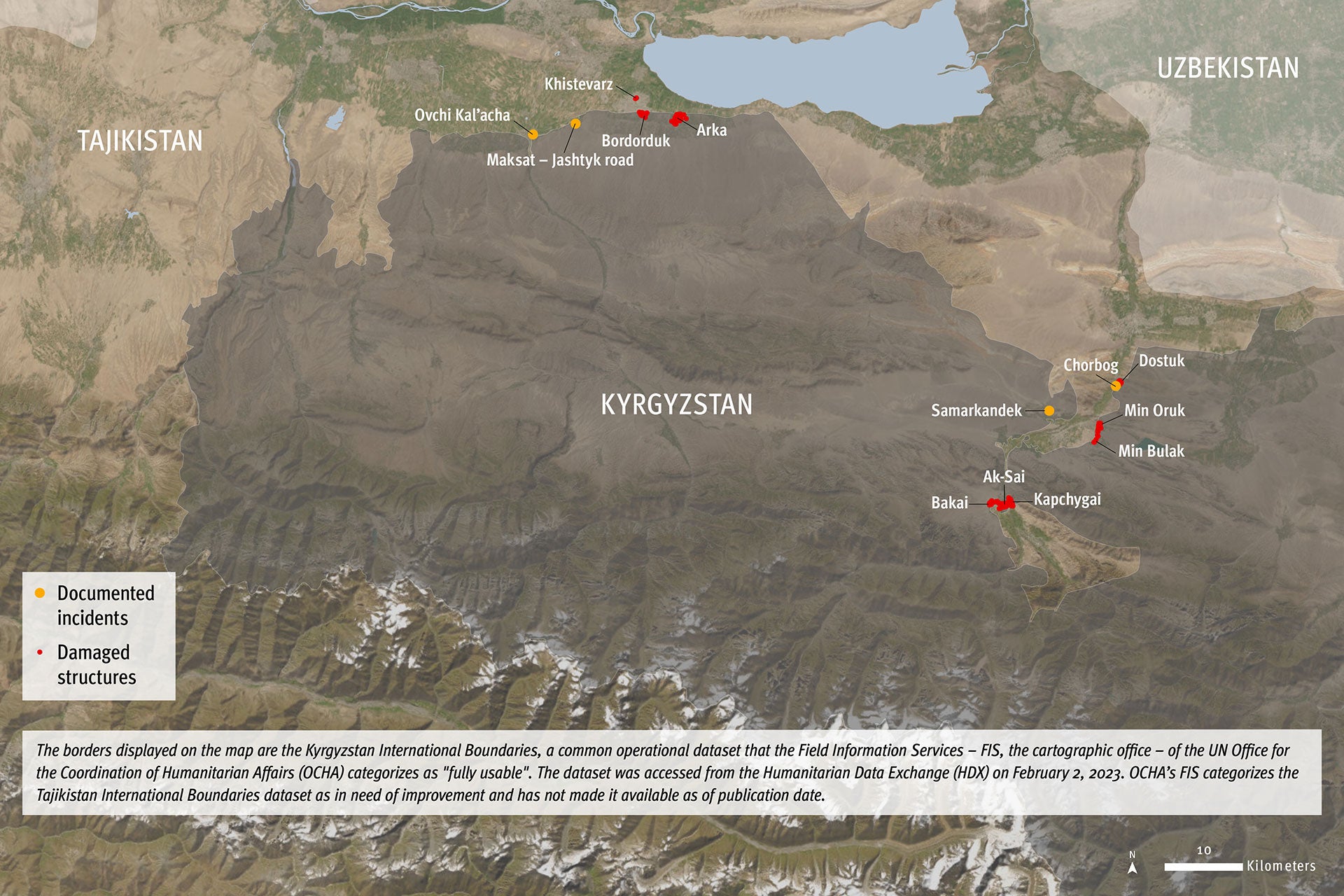
Most of the violations occurred on the third day of the conflict, September 16. At around 5 p.m. that day, the evidence indicated that Kyrgyz forces used a Bayraktar TB-2 drone to deliver a laser-guided bomb near Tajik forces minutes after they arrived in the central square in Ovchi Kal'acha, a Tajik town on the border. Dozens of civilians were in the square at the time, at least 10 of whom were killed – mostly men who had gathered outside a local mosque after a funeral. At least 13 other civilians were wounded in this disproportionate and apparently indiscriminate attack.
On several roads along the border, Tajik forces that day attacked cars carrying fleeing Kyrgyz civilians, killing two men and injuring at least four other people. A 63-year-old woman whose husband and son were injured, said her family crawled out of their car “to avoid being killed in it if it exploded” after Tajik soldiers shot at them.3 The family lay still on the ground for hours, she said, and Tajik soldiers opened fire again when they moved.
Earlier that day, two Tajik ambulances clearly marked as such and a car with civilians came under heavy fire on a bridge near Chorbog in Tajikistan. Ten civilians were killed, including four children, three women and two medical workers, and six others were injured. A detailed 3D model that Human Rights Watch constructed of the attack site showed how the incoming bullets were most likely fired from around the Kyrgyz village of Dostuk, approximately 110 meters away, and possibly from a nearby Kyrgyz border guards base. Ambulances, when they are being used for medical transport, receive particular protection under international humanitarian law and to intentionally direct attacks against them when they are clearly marked is recognized as a war crime in an international armed conflict, under the statute of the International Criminal Court.
As the day progressed, Tajik forces overran Kyrgyz forces and accompanied by Tajik-speaking people in civilian clothes, entered Kyrgyz villages on the border. During this brief occupation, Tajik forces killed at least six civilian men, including three while they were apparently fleeing, and two in apparent extrajudicial executions. People in civilian clothes carried out widespread looting under the watch of Tajik forces, while hundreds of homes and other civilian infrastructure, such as kindergartens, schools, medical facilities, and official buildings, were set on fire in an apparent attempt to clear the area of its population.
The four days of fighting amounted to an international armed conflict that was governed by international humanitarian law. This obliges all parties to distinguish between civilians and combatants at all times. It prohibits attacks that deliberately target civilians or attacks that are indiscriminate, in that they fail to or are unable to distinguish between civilian and military objects, or are disproportionate meaning they can be expected to cause harm to civilians and civilian objects that is excessive in relation to the concrete and direct military advantage anticipated.
Warring parties must take all feasible precautions to avoid or minimize civilian harm.
The governments of Tajikistan and Kyrgyzstan should investigate allegations of violations or abuses committed by their forces and civilians in the areas they controlled, and they should hold perpetrators to account. They should provide training to their military and security forces in international humanitarian law and ensure its standards are upheld in any future conflicts.
The two governments should ensure that any border demarcation agreements and interim border arrangements respect the rights of local populations, including property rights and access to education, adequate housing, and water. They should extensively consult local populations and civil society groups in the context of the border demarcation process. They should also promote confidence-building measures between local communities in border areas, including programs to reduce tensions and hate speech.
Human Rights Watch also calls on both governments to endorse the Safe Schools Declaration and the Political Declaration on the Use of Explosive Weapons in Populated Areas.
Kyrgyzstan and Tajikistan’s international partners should support steps by the two governments to investigate serious violations of international humanitarian law in the September 2022 border conflict and ensure accountability.
Partners should also stand ready to provide financial or other forms of support to military training on international humanitarian law standards and to other measures aimed at avoiding a repeat of the abusive September 2022 conflict.
Recommendations
To the Kyrgyzstan and Tajikistan governments:
- Mount a thorough and independent investigation into allegations of serious violations of international humanitarian law committed by their respective forces and hold perpetrators to account;
- Provide compensation and psychosocial support to the families of victims of serious violations of international humanitarian law;
- Provide training or expand existing training provisions to relevant armed forces personnel on the application of international humanitarian law in conflict situations;
- Ensure that any border demarcation agreement and interim border arrangements respect the right of the local populations, including their access to education, adequate housing, and water, and their ability to ensure an adequate standard of living for themselves, including, as necessary, generating an income through legal cross-border economic activities;
- Ensure that any deprivation of property is appropriately compensated in line with international law, for example in the event of a land swap that could deprive populations of their homes and other property;
- Ensure provision of humanitarian assistance, including shelter, food, water and sanitation, and medical care to those affected by the conflict, including due to displacement or loss of property;
- Promote confidence-building and awareness raising measures between local communities in border areas, including on human rights standards and international humanitarian law;
- Repair and rebuild kindergartens, schools, and medical facilities damaged or destroyed;
- Endorse the Safe Schools Declaration and the Political Declaration on the Use of Explosive Weapons in Populated Areas.
To the Kyrgyzstan government:
- Accede to the Rome Statute to become a member of the International Criminal Court.
To the Tajikistan government:
- Investigate the looting and destruction of civilian infrastructure in Kyrgyz villages by civilians apparently from Tajikistan, under the watch of Tajik forces.
To the European Union:
- Use its high-level engagement with both countries to call for independent investigations and for accountability for violations committed during the border conflict and to press for the border demarcation process to respect the human rights of civilians living in the region. Progress in this area should be considered during the finalization or negotiation of Enhanced Partnership & Cooperation Agreements with both countries and their ratification by EU member states and the European Parliament;
- In particular, raise the issue in the context of the monitoring of Kyrgyzstan’s commitments under the Generalised Scheme of Preferences Plus (GSP+) trade benefits and in the context of Tajikistan’s GSP+ pre-application process;
- Urge Kyrgyzstan to ratify the Rome Statute and join the International Criminal Court;
- Offer to provide technical assistance and good offices to both countries in the framework of its Border Management Programme in Central Asia (BOMKA), and support renewed cross-border cooperation efforts through its Instrument Contributing to Stability and Peace (IcSP) to promote rights-respecting approaches to border management.
To Kyrgyzstan’s and Tajikistan’s International Partners, including United Nations agencies:
- Support steps by the two governments to investigate serious violations of international humanitarian law in the September 2022 border conflict and ensure accountability. Partners should stand ready to support military training on international humanitarian law standards;
- The Organization for Security and Cooperation in Europe (OSCE) in particular, as a leading regional multilateral platform to manage security issues, could step up its role in supporting human rights-sensitive border cooperation and reducing tensions.
Methodology
Human Rights Watch interviewed 86 people for this report in person and remotely. This included 69 people (42 men, 26 women, and one boy) who were survivors, witnesses, or relatives of victims. Interviewees spoke in private, individually or in the presence of a close family member if they preferred to do so.
Interviewees were made aware of the purpose of the research, the nature of the interview, and its voluntary character. Researchers told interviewees that they faced no obligation to participate, that they could decline to answer questions, and that they could end the interview at any moment. The interviews aimed to elicit detailed accounts of the interviewees’ first-hand experiences of the conflict. None of the interviewees received financial or other incentives. The names of the interviewees who preferred to remain anonymous have been withheld.
Researchers corroborated witness accounts with those of other witnesses; material evidence, such as medical records and munition fragments; satellite imagery; photos and videos shared by interviewees or available online; and the researchers’ own observations from the sites where the incidents took place. In addition, Human Rights Watch used 3D scanning (with LIDAR – a technology that uses laser beams to create a 3D representation of the surveyed surfaces), 3D reconstruction (using photogrammetry – the process of generating 3D models from a series of 2D photographs or videos), and basic ballistic analysis to assess angles of attack.
Human Rights Watch excluded from this report the cases of civilians killed or injured in circumstances where it could not be confidently determined that a violation of international humanitarian law had taken place. Such cases included the killings of individuals where we have reasons to believe that they were taking part in hostilities at the time of their deaths and therefore did not enjoy protected civilian status, and killings for which Human Rights Watch was not able to identify witnesses or other supporting material.
Human Rights Watch also submitted a series of questions about the fighting and attacks to the governments of Kyrgyzstan and Tajikistan. Letters concerning events that took place on the government’s territory were sent in December 2022. On March 23, 2023 Human Rights Watch wrote to both governments with a summary of the findings on violations of international humanitarian law during the conflict.
On April 11, the Kyrgyzstan government responded in detail to our December 2022 letter. It provided information on violations committed by Tajik forces against citizens of Kyrgyzstan, including conclusions of a forensic analysis, lists of civilian casualties, lists of looted vehicles and cattle, and 357 pages of photos of damaged and looted structures. This information is reflected in the relevant sections of this report.
The Kyrgyz government declined to respond to the specific questions we raised in our March 23, 2023 letter, and said it had “no information” regarding attacks by Kyrgyz forces.
At the time of publication, the Tajik authorities had not responded to our letters.
This report was updated on May 4, 2023 to correct the spellings of several names and locations. The letter sent by the Kyrgyz Ministry of Foreign Affairs has been updated at their request, to reflect the current position of the Kyrgyz authorities.
Background
The border conflict that is the subject of this report began on September 14, 2022, when forces from Kyrgyzstan and Tajikistan exchanged fire near a Tajik exclave in Kyrgyzstan called Vorukh. The fighting dramatically escalated on September 16, leading the two countries to agree to a ceasefire that afternoon, which committed both parties to remove military forces and heavy weaponry from the border area. Clashes nevertheless continued sporadically through September 17, when the ceasefire finally held.
The 2022 fighting was the latest – and most intense – in a series of clashes along this roughly 110-kilometer stretch of border. In April 2021, Kyrgyz and Tajik forces briefly fought over control of the critical Kyrgyz-owned waterworks of Golovnoy, which provides water reserves to the town of Batken in Kyrgyzstan and lies near the Tajik exclave of Vorukh.
Official lists and media reports combined with Human Rights Watch’s documentation indicate that up to 51 civilians may have been killed and at least 121 injured during the four-day conflict of September 2022.4
The border disputes occurred against the background of an unfinished demarcation process in the aftermath of the collapse of the Soviet Union in 1991. The border in many areas runs through villages with adjacent houses inhabited by Kyrgyzstan and Tajikistan citizens, and each country hosts exclaves from the other.
Since September 2022 the two governments have engaged in renewed bilateral talks, without mediation or involvement of third parties, to delineate disputed areas of the border.
In meetings with Human Rights Watch, Kyrgyzstan and Tajikistan officials in late 2022 expressed optimism that the negotiations would further the demarcation process, but foreign diplomats in both countries warned that the militarization of the border was continuing.5 At the time of writing, it is unclear when the talks will conclude.
Abuses by Kyrgyzstan Forces in Tajikistan
Strike on Ovchi Kal'acha Town Square
On September 16, around 5 p.m., a laser-guided bomb, which the evidence indicates was dropped from a drone, killed at least 10 civilian men and injured at least 13 people on the main square of Ovchi Kal'acha, a Tajik border town. The attack, the first of two strikes on the square that day, may have been targeting a Tajik armored vehicle and other military vehicles that had just arrived at the square, but the area was also full of civilians. About two hours before, the heads of the State Committees for National Security of the two countries had announced a ceasefire, so residents of the town had emerged from their places of shelter. Dozens of people were gathered in the square, including those who were leaving a mosque after the funeral service of a woman who had been killed by a stray bullet earlier that day.
Human Rights Watch spoke with ten witnesses to the attack or its aftermath, including three people who were wounded, and inspected the site.
Ground fighting and shelling had begun around Ovchi Kal'acha in the early morning. Exchanges of fire started along the border shortly before 7 a.m., leading school authorities to cancel classes and ask parents to keep their children home.6 “People heard the shooting and were telling each other… to spread out and go far from the military units of Tajikistan,” one local resident said.7 “The shooting was coming from the border, so people decided to go far from the border,” another said.8
Many women, children, and older people evacuated.9 Those who were unable to flee hid at home, while many others chose to remain in the village to protect their property, finding refuge indoors.10 Throughout the day, Tajik soldiers and military vehicles traveled back and forth through the town square on their way to the frontline.11
In the mid-afternoon, residents learned through online and radio news that a ceasefire had been reached.12 Gradually, people emerged from their homes, and some began to gather in the square. Zarif Egamov, the 44-year-old owner of a restaurant on the square, said that “everybody relaxed” with the announcement of the ceasefire.13
At the mosque, men gathered for prayers and the funeral. After the ceremony, at around 4:50 p.m., some of the congregants walked to the cemetery for the burial, while others – all men – stayed in front of the mosque.14 Other residents also gathered to talk. Altogether, dozens of civilians were in the square at the time, five witnesses said.15
“We were chatting, discussing [talking] about the war, the wounded people,” said Mansur Khakimbekov, a 48-year-old construction worker, who was outside the mosque at the time. “Everybody was worried.”16 The men were also discussing whether, in light of the ceasefire, they should remain in the town and bring their families back, two other witnesses said.17
Around 5:00 p.m., Tajik military vehicles arrived at the square, and the first bomb hit almost immediately. “It was calm. There was no shooting, when two [armored vehicles] came from the side of Gafurov and four vehicles with soldiers came across the square,” a person who was wounded in the attack said. They continued: “When the vehicles arrived at the square, one bomb exploded close to [the] shop [adjacent to the mosque].”18
Based on witness accounts, a video of the attack’s aftermath, a site inspection, and an analysis of the fragmentation pattern, the first bomb apparently hit roughly 10 meters from the entrance of the mosque, near where one of the armored vehicles was parked.19
“We all flew away from the place,” said Mansur Khakimbekov, who was hit by 10 metal fragments. “I lost consciousness and when I woke up, I saw a lot of bodies and blood around.… I was behind other people. All of them died. So their bodies protected me.”20
Zoidbek Dadobekov, a 50-year-old construction worker injured in the attack, said that he had been standing at the entrance of the mosque, next to a wall that partially protected him. He explained:
I don’t remember any smoke, any smell, or any pain. The only thing I remember is that my leg was injured.… I had seven, eight injuries, but I didn’t feel any of them.… I remember two people were standing next to me. They fell [to the ground].… They didn’t even feel that they died, because even their fingers weren’t moving.21
Another witness said that after the strike, all those who had been standing at the entrance of the mosque were on the ground and that the driver of a small pickup vehicle and two of his passengers were injured. “There were a lot of injured and dead people in the square,” he said. “[There was a] lot of blood.”22
Another witness said he rushed out of the mosque when he heard the explosion. “I could hear the guys asking for help,” he said. “The smoke was very thick. I couldn’t see but I could hear the guy say: ‘Please help me, fix my leg! There’s too much blood!’ Two people were alive but dying. Others, their bodies were already destroyed. No heads, no parts of the head.”23
Shahriyor Khasanov, a 39-year-old shop owner who survived the attack, said he was hit by metal fragments in the stomach and his leg was “almost separated” from his body.24 Khasanov later underwent four surgeries and remains unable to walk.25
After the attacks, Tajik forces and civilians rushed to put the injured in vehicles and brought them to regional hospitals, which were overwhelmed with patients injured that day, soldiers and civilians alike.26
Human Rights Watch verified a video27 that was recorded minutes after the first attack and posted on social media.
The video shows eight men in civilian clothes on the ground following the attack. Five of the men appear dead, one appears injured.
At least a dozen men in Tajik military and police uniforms are also visible.
Two pools of blood are on the ground, suggesting that victims with injuries had already moved or been moved.
Four Tajik armored military vehicles and a military truck are visible on the square,
and two other military vehicles – a truck and an armored vehicle – are visible on a side street.
In interviews with survivors and relatives of victims, Human Rights Watch collected the names of 10 civilians who were killed in the first attack and 13 who were wounded.28 Total casualty numbers might be higher.
Around 8 to 10 minutes later, a second strike hit a military vehicle on the street adjacent to the square.29 “The second explosion hit the top” of the vehicle, a man who saw the aftermath of the attack said.30 “The... hatch was open. The bomb came through the opening and exploded inside.31 The soldiers were out of the [vehicle], but they were injured and killed, because they were close” to it.32
By that time, there few civilians still in the square. No civilians appear to have been killed in the second attack. One witness said one or two civilians were injured.33
An unknown number of soldiers were killed or injured in the two attacks. One witness said that one soldier was killed in the first strike.34 Another said he saw three soldiers injured because of the strike, including one in the stomach, and another in the legs.35
Human Rights Watch visited the town square and surrounding area on November 11 and 12, 2022,
and found spherical fragmentation impacts, 5 to 30 millimeters in diameter, as well as steel spheres that were 5 millimeters wide.
The highest concentration of the fragmentation was in the 20-meter radius from the location where witnesses said the first bomb detonated,
while some were observed as far as 70 meters away.
The impact holes were round, consistent with the steel spheres found on site,
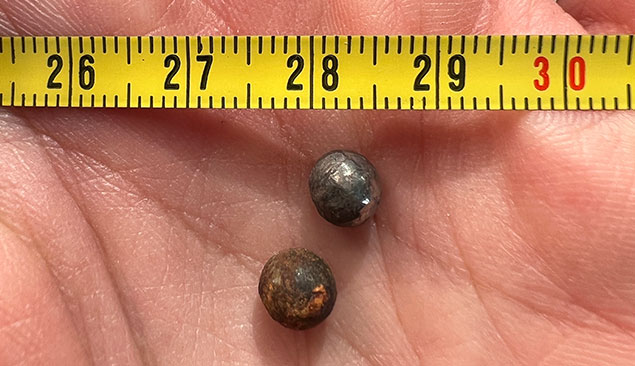 and some of these impact holes still contained steel spheres embedded in them.
and some of these impact holes still contained steel spheres embedded in them.
An x-ray image of a person who said they were injured in the first strike shows what appears to be a sphere similar to those found at the location of the attack.
Other x-ray images of that person show apparent spherical damage to a tibia.
Another person showed Human Rights Watch three injuries they said they sustained from the strike. One of them, in the lower leg, appeared to be entry and exit wounds, both round,
and the other, in the thigh, appeared to be an entry wound, also that shape and size.
Human Rights Watch also examined munition remnants that two residents said they had collected,
as well as photos of remnants provided by a third resident.

The photos were of two distinctive stabilization fins and their associated fasteners, of the munition used in the first strike, that he said he had.36
The same remnants are seen on a local television news segment about the attack.37 In addition, a 3D reconstruction of a thin piece of metal found on site matches the dimensions of an element present in some MAM-L bombs.
Based on this material, Human Rights Watch concluded that at least one MAM-L laser-guided bomb was used on the square. These munitions are delivered by Bayraktar TB-2 drones or other light aircraft.
According to the manufacturer, MAM-Ls can be equipped with one of three types of warheads: enhanced blast (thermobaric), anti-tank, or blast fragmentation. Human Rights Watch concluded that the warhead used in this attack was the blast-fragmentation variant, which is designed to damage “soft targets,” such as infantry, and which produces its fragmentation effects through the steel spheres we found on site and which are specific to this warhead.38
The damage that Human Rights Watch observed on site and the information it gathered regarding the injuries caused by the bomb are also inconsistent with those that would be expected to be caused by anti-tank and thermobaric warheads.
MAM-L bombs can be equipped with a proximity fuze, which detonates the munition before it reaches the ground, magnifying the deadly radius, consistent with the limited size of the crater Human Rights Watch was able to observe on the site. One witness also claimed that the bomb had exploded before it hit the ground, though it is questionable whether he would have been able to determine this visually.39
Publicly available satellite imagery recorded on September 9, one week before the attack, shows a Bayraktar TB-2 drone present on the tarmac at the Kyrgyzstan airbase of Razzaqov (formerly known as Isfana), 34 kilometers from, and within range of, Ovchi-Kal'acha. A hangar large enough for the drone, built between April and July 2022, is also visible, indicating that the base was operational by September 9. Photos from a visit of Kyrgyzstan president Sadyr Japarov to a Kyrgyzstan military airbase in the town of Jalalabad in December 2021 show a Bayraktar TB-2 drone equipped with the blast fragmentation version of the MAM-L laser-guided bomb.40
The MAM-L munition’s laser guidance system makes it an accurate munition. Guiding is aided by live video feed giving the operator a clear, continuous view of the target.41 This means that the operator of at least the first strike should have seen that a large number of civilians were on the Ovchi Kal'acha square and in the immediate proximity of Tajikistan soldiers and vehicles at the time.
Though the first bomb hit meters from an armored vehicle, the operator used a blast fragmentation warhead, rather than an anti-tank warhead. Given the large number of civilians in the square and the effects of such a blast fragmentation munition, it should have been clear to the operator and those planning the attack that there was a high risk that civilian casualties would be excessive in relation to the damage caused to the military using that weapon. The effects of the weapon could also be expected to strike both military and civilian targets without distinction. This strike was therefore disproportionate and apparently indiscriminate, in violation of the laws of war and if committed deliberately or recklessly would constitute a war crime.
Attack on Ambulances and a Civilian Car, Chorbog
In the early morning of September 16, Kyrgyz forces attacked two ambulances and a civilian vehicle near the village of Chorbog (Isfara district) in Tajikistan, killing ten civilians and injuring six.
One ambulance with four healthcare workers had left Isfara State Hospital and was driving south on the road linking the regional capital of Isfara to Chorkuh, a village near the border. Onboard, the driver, a traumatologist, an intensive care doctor, and a nurse, were rushing to assist the medical staff at the Chorkuh Village Hospital.42 After passing the village of Chordeh around 6:20 a.m., the vehicle approached the bridge marking the entrance to the next village, Chorbog.43 On the bridge stood a Tajik military vehicle that had apparently been shot at and stopped by Kyrgyz forces earlier that day. As the road turned southeast, the ambulance came near the Kyrgyz village of Dostuk, which at its nearest point stands about 110 meters north of Chorbog.44 This exposed the front and left side of the vehicle to Kyrgyz forces stationed in Dostuk.
At that moment, shots hit the ambulance.45 “Approximately 30, 40 bullets reached the back of the car, and also the windshield,” the driver, Khusrav Sanginov said.46 The intensive care doctor Ilhom Nazarov, who was in the back, said he was moderately wounded in the head.47
Sanginov stopped the car on the right side of the road and the four healthcare workers ran out, finding refuge near a concrete wall, Sanginov and Nazarov said.48 “After maybe a minute or more … an explosion occurred and then black smoke,” said Sanginov. “I think it was our ambulance.”
Both Sanginov and the doctor Nazarov believe that Kyrgyz forces targeted the ambulance.49 “I know for sure that our ambulance was a target…. They just started shooting. It was not by mistake or something,” Nazarov said.50 He recalled that he had heard shooting before reaching the bridge, but that the sound was very far from them and that there was no warning shot before they came under fire.51 The attack, Sanginov said, came “from the eastern side,” from a gas station in Dostuk.52
Minutes later, a second ambulance approached the bridge from the other side, followed closely by a civilian car. The two vehicles were driving north at high speed in the direction of Isfara.
This ambulance had left Chorkuh Village Hospital in haste to bring three civilians from Chorkuh to Isfara State Hospital. Asmoa Amriddinzoda, a 6-year-old girl; Imron Ilhomzoda, her five-year-old cousin; and Imron’s mother, 29-year-old Dilnoza Bahromzoda, had all been severely injured when shelling hit their home earlier that morning. Four relatives accompanied them in the back of the ambulance, including Asmoa’s mother, 25-year-old Sadokat Uktamzoda, who also carried with her the infant boy she had given birth to that very morning.53 Kamoliddin Ashurov, a 48-year-old nurse, and Khusanboy Valiev, the driver, sat in the front of the ambulance.
Amojon Fayozov, 34, the children’s uncle, said that when he had got into the vehicle earlier at Chorkuh Hospital,54 his niece and nephew “were not fully conscious because of the trauma on their heads but they could make some noises and we could understand that they were in pain.”55
A car carrying civilians, including a family of five fleeing the shelling in their village of Lakkon to the south, was behind the ambulance. Mahbuba Hasanova, 27, said the family had decided to drive with the ambulance because that would be safer.56
As both vehicles approached the Chorbog bridge from the south, passengers recalled seeing the damaged Tajik military vehicle that blocked the bridge.57 At that moment, they came under fire.58 “We were just turning to the bridge when they shot the [ambulance] driver with a rocket-propelled grenade,” Fayozov said.59 The shooting, he recalled, came from the Kyrgyzstan side of the border. At the point that the main road turns west towards the bridge, the border lies roughly 110 meters north of the bend in the road.60
Valiev, the driver, and Ashurov, the nurse, died instantly.61 Fayozov said that he fell to the floor and that a second explosion then injured him and threw him from the vehicle through the window.62
Hasanova, who was in the car behind them, said that their car had just turned near the bridge when the “ambulance received a missile or a bomb” and exploded.63 An exploding projectile then hit the front of Hasanova’s car, she said, killing the front passenger instantly. The car, she recalled, was also hit with bullets.64
The second ambulance caught on fire, killing eight passengers trapped inside.65 Only Fayozov survived after finding shelter under the bridge, where he met Hasanova and her family.66
After these attacks, Tajik soldiers on the western side of the river opened fire on Kyrgyz forces. The shooting and shelling continued for around three hours, witnesses said.67 The group of four survivors from the first ambulance continued to be shot at while trying to flee. “When we started moving, snipers started to shoot,” said Sanginov, the driver of the first ambulance.68 “We jumped from one tree to another, from one place to another place, step by step.”69
Tajik forces eventually forced Kyrgyz forces away and around 11 a.m. they evacuated the injured.70 Hasanova’s husband Akmar and her 3-year-old son, Ahmadjon, were severely wounded. “He had two holes in his stomach, and he didn’t even cry,” Hasanova said of her son.71 “He was so scared that he didn’t cry, he didn’t shout, he didn’t say that he had any pain.”72 Ahmadjon later died at the hospital.
Survivors of the attack and Dostuk residents said that Kyrgyz forces controlled Dostuk in the early morning. Tajik forces occupied Dostuk later that day but were not in the village at the time of the attack. Satellite imagery dated September 17 also shows a border guards base uphill east of Dostuk.
Human Rights Watch inspected the wreckage of the two ambulances, located in the garage of the Isfara state hospital,
and found dozens of bullet holes as well as extensive fire damage consistent with witness accounts.
Researchers also constructed the site of the incident in 3D using photos, videos, and 3D scans taken of the attack site and the two damaged ambulances.
A shot-hole analysis – a basic ballistics technique – of both vehicles was conducted and recorded with 3D scanning.
Human Rights Watch also reviewed satellite imagery and three videos of the site taken by a journalist on September 18 to estimate the positions of both vehicles.
This analysis found that, consistent with witness accounts,
the two ambulances were hit by shots fired from around the Kyrgyz village of Dostuk, north and northeast of where the two ambulances had been positioned
Taken together, the witness statements, damaged ambulances, and 3D model strongly suggest that Kyrgyz forces in Dostuk deliberately targeted the two ambulances, resulting in ten civilian deaths. Incidental fire seems very unlikely, given that the vehicles were attacked with different types of munitions, including explosive munition and bullets of various calibers, and that survivors from the first ambulance continued to come under fire while running away.
Both ambulances were clearly marked with red and white painting and the word “Ambulance” on the front, which would have been visible from where the Kyrgyz forces were based. This makes it highly unlikely that the ambulances could have been mistaken for military vehicles.
The presence of a damaged Tajik military vehicle on the bridge when the first ambulance reached the area indicates that hostilities were ongoing, but Kyrgyz forces had a duty to distinguish between military and civilian targets.
Together these elements indicate that Kyrgyz forces in Dostuk targeted the vehicles even though they should have known they were medical vehicles, which would render the triple ambush unlawful and an apparent war crime.
Attack on Ambulance, Ovchi Kal'acha
A doctor and a nurse were killed when a Tajik ambulance from Ungi Hospital came under attack around 4 or 5 p.m. on September 16 in the Tajik village of Ovchi Kal'acha.73 The location of the attack – a steep-sided valley 110 meters downhill from the nearest position of Kyrgyz forces – and an analysis of the bullet holes indicate that the ambulance was very likely attacked by Kyrgyz forces, despite its markings as a medical vehicle.
There were four healthcare workers in the ambulance who had spent the day driving back and forth to frontline areas to pick up injured Tajik civilians and soldiers, the ambulance driver and one of the medical workers said.74 Around 3.30 p.m., the group received information about a civilian injured on the southern outskirts of Ovchi Kal'acha.75 When they arrived in the area, the ambulance staff set out to find the injured person.76 One of the nurses, Abdunabi – known by his colleagues as “Nabijon” and who was in his late 40s – left the vehicle looking for the injured person, while the driver turned the ambulance around, preparing to leave.77
As Nabijon returned minutes later, the vehicle came under attack. “Shooting first started from the back but didn’t reach the car and Nabijon hurried to the car.… I think he was injured while he was out,” the driver said.78 Nabijon then entered the ambulance, sat on the floor, and placed his head between the two seats.79
The other nurse on board, Mazbutjon Karimov, 52, was sitting in the back alongside Solijon Rahimov, a 45-year-old doctor. As the shooting started, Karimov said, he fell to the floor.80 “Abdunabi [Nabijon] was not talking,” he said. “The doctor next to me [Rahimov] was talking over the phone… when he received a bullet. He shouted ‘Aaaah.’… I fell on the floor of the car. The floor was full of blood.”81
The ambulance driver rushed to the Bobojon Gafurov state hospital, but Nabijon and Rahimov both died of their injuries. Nabijon had received a bullet in the neck, while Rahimov had been shot with a large caliber bullet in the forehead and received two smaller caliber bullets in the stomach, one of which hit a kidney and the other, the spine.82
Human Rights Watch examined the bullet damage on the ambulance and visited the site of the attack with one of the survivors. The ambulance was clearly marked as such: painted white and red, the vehicle featured the star of life on the hood and had “AMBULANCE” written on the front above the windshield. All but one of the entry bullet holes on the vehicle were located on the back right corner of the vehicle. One hole showed the bullet had entered from the back left side. The downwards trajectory of some of the shots indicates that those shots were fired from a higher elevation. On site, Human Rights Watch established that the vehicle had been facing north at the time of the attack, indicating that all but one of the bullets had hit the vehicle from a downwards, southeastern angle.
The angles of the shots fired and the location and direction of the ambulance at the time it was first hit indicate that the shots came from the hills controlled by Kyrgyz forces.
Residents of a neighboring house said that Kyrgyz forces had fired at their house repeatedly throughout the day from three locations: a building 110 meters up the hill to the east; a complex of container buildings to the southeast on the same hill; and the top of the hill on the opposite side of the valley to the south, which is also under Kyrgyzstan’s control.
Human Rights Watch is not aware of any Tajik military presence in the area at the time of the attack on the ambulance, though holes consistent with firing holes in the wall immediately adjacent to the ambulance were found, suggesting the Tajik military may have operated in the area at other times.
The ambulance was clearly marked and any deliberate attack on a medical vehicle operating as such is an apparent war crime.
Indiscriminate Shelling of Khistevarz
Two women were killed and six people injured in Khistervarz in Tajikistan on the morning of September 16 in two incidents of apparent indiscriminate shelling. The attacks hit a densely populated residential neighborhood around 1.75 kilometers from the border.
Savrineso Hojiboeva, 59, was killed when an artillery strike hit her house around 7:30 a.m. that day. The explosion took many residents by surprise; although fighting had begun in the distance, it was not clearly audible to all. Five of Hojiboeva’s relatives were injured in the attack.
“You could hear the shooting. The border is very close,” one victim said.83 “We were thinking … should we leave or not? But then we decided we shouldn’t panic.” The victim said they had seen no military activity in the area prior to the strike: “We are … deep in the middle of the village.”84
The shell hit the family courtyard, causing lethal injuries to Hojiboeva, as well as serious injuries to her sister, 73-year-old Fayziniso Rahimova, Rahimova’s 41-year-old daughter-in-law Gulchera Juraeva, and Juraeva’s three children, 16-year-old Mubina Rahimova, 22-year-old Jafar Rahimov, and their brother.
“I saw that [Juraeva’s] shoulder was injured, and [bleeding],” said Fayziniso Rahimova.85 “I called my son: ‘You have to run here, your wife is injured!’ And my son said: ‘I’m busy with my aunt’, and I didn’t understand what aunt he was talking about. It was my sister [Savrineso Hojiboeva].”86
Fayziniso Rahimova sustained severe injuries from metal fragments in her shoulder, hand, and leg. Jafar Rahimov suffered internal bleeding in the chest and a collapsed lung. Both of Juraeva’s legs were injured, leaving her with a permanent disability. Mubina Rahimova suffered a lung injury.
Human Rights Watch visited the site of the attack and found fragments and damage consistent with artillery shelling. The survivors said that there was no military presence in the area at the time.
Minutes later, around 8 a.m., another shell fell nearby, in the courtyard of the house of 83-year-old Kutbineso Hamidova and her family, who live around 160 meters away. The strike killed Hamidova on the spot and severely injured her daughter, 54-year-old Munavvar Kosimova.87 Kosimova said that “it was very calm” before the explosion. “Suddenly it got very dark.” She recalled:
I went out to the street, somehow went to my neighbors.… I was shouting that my mom is dead.… My neighbor … said I needed to look at my hand. I realized that [it] was full of blood and the muscles were [exposed], but I couldn’t feel any pain.88
Besides the injury on her left hand that has left her with a permanent disability, Kosimova was hit by fragments in the abdomen and left leg. She was taken to the Bobojun Gafurov state hospital, where she underwent several surgeries. Her body remains full of fragments, she said.
Human Rights Watch examined the site of the strike and found extensive fragmentation damage consistent with artillery fire. Kosimova said there had been no military presence near her house at the time of the attack.
Abuses by Tajik Forces in Kyrgyzstan
Ambushes of Civilian Vehicles
Tajik forces killed two civilians and injured at least four others when they opened fire on vehicles with families who were trying to flee the fighting on September 16.
Multiple Attacks Between Maksat and Jashtyk
Tajik forces opened fire on three vehicles with civilians on September 16 on an un-demarcated stretch of the border between the Kyrgyz villages of Maksat and Jashtyk. The attacks, which killed a man and injured at least three other people, occurred on a road that links the two villages and is mostly used by Kyrgyzstan citizens. It passes just south of fields cultivated by Tajikistan citizens.
When they came under attack at around 8.30 a.m., 22-year-old Keldibek Koldoshev, three of his relatives and six neighbors, were crammed in the family car, fleeing the fighting that had broken out near their home in Maksat.89 The car was hit four times, Koldoshev said.90 He suffered an injury in the leg from a bullet. The family stopped the car and ran away, but the shooting continued, Koldoshev said.91
Minutes later, at around 8:37 a.m., the car of the Sulaimanov family, who were driving to the area from Maksat, came under fire meters away.92 “Soldiers from the Tajik side … shot at us,” said Gulsun Sulaimanova, a 63-year-old woman who was in the car. “First they hit my son. He said to get down. Then they hit my husband.”93 Sulaimanova’s 66-year-old husband Abdykuddus Sulaimanov was injured in the abdomen by shrapnel, while her son Kydyr Sulaimanov was injured in the head. Her 4-year-old grandchild Imamidin remained uninjured.94
The family fled the car and found refuge near Koldoshev’s family where they lay in hiding for the day as Tajik soldiers kept shooting at them whenever they became visible. “We [heard] them speak in Tajik.… We lay there, not moving.… When we moved, they [would] shoot at us. Bullets were flying above us,” Sulaimanova said.95
“All this time, shooting and shelling was going on …The Tajik side was shooting cars that were passing on the road,” Koldoshev said. “We had Kyrgyz plates; they knew we were Kyrgyzstanis.”96
A third car was attacked later that day when it arrived at the same location. After hearing that fighting had started, 59-year-old Rokiya Dadajonova and her husband, 58-year-old Normatzhon Dadajonov were rushing back from Maksat when Rokiya said their car was fired at from the Tajik side.97 Normatzhon was hit by multiple bullets on the neck, hip, hands, and head. “I bent down, moved my head down. Bullets were flying towards me,” Rokiya said.98 “Then I opened the door. I said: ‘Hey! What sin have I committed? Why do you shoot bystanders?’” Normatzhon died later by the side of the road. His car had been burned out.99
In total, five or six civilian cars were attacked at that location, Sulaimanova said.100
The Tajik soldiers approached the injured civilians hiding by the side of the road and, rather than provide them with assistance, proceeded to threaten and rob them. Sulaimanova said that around 2:30 or 3 p.m., a group of five Tajik soldiers in uniforms approached. “I saw the tip of [a] gun pointed at me, 20 centimeters away,” she said, adding that one “soldier checked the pulse of Kydyr, said something like: ‘He is about to die,’ then looked at my husband, saw his injury, and left.”101
Koldoshev said that four Tajik soldiers searched his car and stole his phone, his car battery, wheel pump, and his mother’s phone. “One of them said that I need[ed] to be taken to Dushanbe [because of the injuries],” he said. “I kept lying on the ground [and] put my face towards the ground.… They told each other that I would die and left me.… My leg kept bleeding.”102
The Sulaimanov family ran away in the dark of the night, but Koldoshev, too injured to move, stayed there for more than 36 hours, surviving on water that the Sulaimanov family had given him, until he was rescued by Kyrgyz soldiers and brought to a hospital.
Human Rights Watch reviewed a video posted on social media showing the cars of the two families on the road, their hoods open, which appears consistent with Koldoshev’s claim that Tajik soldiers looted spare parts. The video shows two other apparently civilian vehicles, including one that was burned out.103
In its response to Human Rights Watch, the government of Kyrgyzstan said that a forensic examination had found that Dadajonov had been killed by a gunshot wound to the head.
Killing of Suhrob Kenjebaev between Arka and Margun
On that same morning of September 16, Tajik soldiers ambushed the car of a family fleeing the Kyrgyz village of Arka. Suhrob Kenjebaev, a 44-year-old man, was driving with his wife, 43-year-old Gulshan Yuldasheva, and their 14-year-old son Abboz. Like many residents of the area, the family was heading south, away from the valley and the border and towards the village of Margun, located south of Arka across a desert ridge.
Soldiers opened fire on the car and shot a grenade, which failed to explode. “Soldiers had been hiding behind bushes and trees,” Yuldasheva said. “As we were driving, all of a sudden, they started shooting. About twenty soldiers. After the car stopped, they surrounded us and started shooting again.”104
Yuldasheva, who was sitting in the back of the vehicle with her son, was injured in the leg and chest, while her husband Kenjebaev was killed on the spot. “They had surrounded the car. I didn’t understand their language,” she said. “All were armed.… I had blood all over.… My son looked at me.… He said, ‘Mom, blood!’ I said: ‘Keep silent!’ I looked at my husband in the front of the vehicle. He was already dead with his head hanging down. He wasn’t breathing.”105
Yuldasheva said that she then saw Tajik forces open fire on another civilian vehicle. With her son, they escaped and were rescued by another driver, and then by an ambulance. She underwent two surgeries.
Human Rights Watch researchers inspected the car wreckage at the police station in Arka and found more than a dozen bullet holes all over the car, as well as large blood stains on seat covers and floor mats.
Killings of Civilians in Occupied Areas
Human Rights Watch documented six killings of Kyrgyzstan civilians during the Tajik occupation of Kyrgyzstani villages on September 16 and 17. In two cases, Tajik forces shot at men while they were fleeing on foot, killing three. In two other cases, older men were killed in their homes; the locations of the bodies and the injuries suggested that they had been killed at close range while defenseless. In the last case, Tajik forces opened fire at a group of civilian men, killing one.
Myktybek Avrorov and Aibek Ysmanov, Killed in Ak-Sai
Two witnesses said that Tajik forces killed Myktybek Avrorov, a 22-year-old man fleeing the fighting in his village of Ak-Sai, and 35-year-old Aibek Ysmanov, a government employee of the Ministry of Emergency Services, during an attack in Ak-Sai on September 16.106
There was shooting in the town at the time the two men were killed, two witnesses said. Zairbek Kadirov, a friend of Avrorov, said he watched from a nearby hill as five armored Tajik vehicles entered Ak-Sai and two Kyrgyz soldiers were shot dead.107 The other Kyrgyz forces in town were quickly overrun, another witness who watched the fighting said.108
Shortly thereafter, Avrorov was driving with his brother Shumkar while Ysmanov drove his own car close to them, both trying to flee the area, when some of the armored Tajik vehicles opened fire on the two cars, one witness said.109 The witness said he saw that most of the armored vehicles had driven down from the neighboring village of Bakai and were firing at civilians.110 When their car was hit, Myktybek and Shumkar stopped and got out of the vehicle. At that point, the witness said, a Tajik soldier opened fire on them with an automatic weapon mounted to the vehicle. He explained:
There was a machine gun on top of the Tajik vehicle. They turned it and started shooting.… They literally targeted us and directly shot at [Myktybek and Shumkar]. As soon as the Tajiks shot, [Myktybek and Ysmanov] got hit.111
Shumkar ran away and survived.112
Kadirov, a friend of Myktybek, said he saw the body of Myktybek at this location on September 17, when Kyrgyz soldiers inspected it.113 He also attended Myktybek’s funeral on September 17 and saw his friend’s body there. He said that Myktybek had been shot in the face and was missing half of his head and that he had smaller bullet injuries in the chest.114 Kadirov showed researchers the video he recorded when Kyrgyz soldiers inspected Myktybek’s body.115
Matisa Nadyrov, Killed in Ak-Sai
In the same village, 58-year-old Matisa Nadyrov, a chicken breeder, was killed on September 16 during the occupation of his farm by Tajik forces. His son Adilet Nadyrov said that his father had been reluctant to flee with the rest of the family, who left at around 7:30 a.m. as Tajik forces approached. Adilet said he was watching from a nearby mountain when he saw Tajik forces enter the village and civilians with them loot private property. “I saw there were four armored cars going towards the farm,” he said. “That’s where my father was shot by them.”116
Adilet did not see the shooting but went to his family’s farm later, after Tajik forces had left, and said he found his father’s body away from the main house with two bullet wounds, one in the stomach and one in the neck. “He had managed to escape from the farm, but not far enough,” Adilet said.117
Human Rights Watch also interviewed an acquaintance of Nadyrov who attended his funeral.
Myrzakmat Homidov, Person with Physical Disabilities Killed in Borborduk
Seventy-two-year-old Myrzakmat Homidov, a retired farmer who suffered from hearing difficulties and asthma, was the victim of an apparent unlawful killing on September 16 when Tajik forces occupied his village of Borboduk.
His wife, 70-year-old Satkiniso Ahmedova, said that after fighting broke out that morning, she went to hide in a neighbor’s basement, but her husband refused to leave and decided to stay in their garden. “What will they do to an old person? I will be at home,” she recalled him saying.118
The couple’s neighbor Bektemir Mutaliev went to the house at around 2:30 p.m. to check on Homedov. “I saw the house of my neighbor was burning,” he said. “I knew that my neighbor was there alone. After I put out the fire … we found his body in the backyard.”119
Mutaliev, who later performed funeral rites on Homedov and washed his body, said Homedov had a bullet injury in the shoulder and another with an entry wound on the right cheek and an exit wound in the back of his neck. Mutaliev and Ahmedova said they found bullet casings near the body.
Killing of Ysmail Mamyrov, Person with Physical Disabilities in Min Oruk
Ysmail Mamyrov, a 62-year-old Kyrgyz man who walked with crutches due to a previous leg injury, was shot and killed in his house in Min Oruk on September 16, while the village was occupied by Tajik forces, three of his family members said.120 “My mom and my son had fled while my dad collected his documents,” Mamyrov’s 27-year-old daughter Mahabat said.121 A video provided by the family shows what looks like Kyrgyz soldiers entering a bathroom and finding a slain man, which the family says is Mamyrov, on the floor of the shower. Three bullet holes are visible on the tiles close together suggesting that Mamyrov had been killed at close range.
Killing of Jusup Normatov in Samarkandek
Tajik forces killed Jusup Normatov, a 54-year-old resident of the Kyrgyz border village of Samarkandek, on September 16, when they opened fire on a group of nine civilian men who, despite the fighting, had remained in the village to protect property. Both sides exchanged fire that day, as Kyrgyz forces shot at Tajik forces advancing on the village, a man who was present when Normatov was killed said122 A relative of Normatov said that Normatov had fled that morning with his family after the fighting started, but he decided to go back. “I told him not to do that, but he refused, saying that men should stay in the village,” the relative said.123
A survivor of the attack said that he and Jusup Normatov, alongside other civilians, none of them with weapons, were hiding by a road when Tajik vehicles approached, and that Normatov stood up, mistakenly believing these were friendly Kyrgyz forces. Tajik forces in the vehicles opened fire at the group with seven or eight bullets and mortally wounded him, the survivor said. “They targeted us, they did not shoot above us in the air,” he said. He added that the Tajik soldiers then drove by and headed in the direction of where Kyrgyz forces were based. The other men took Normatov to the hospital, but he lost a lot of blood and died on the way.124
Looting and Destruction of Villages
When Tajik forces entered Kyrgyz-held territory on September 16, they were followed in some places by people in civilian clothes speaking Tajik.125 Although Tajik control lasted less than 24 hours, in that time the Kyrgyz village of Kapchygai and a vast majority of the villages of Bakai and Dostuk (Batken district) were systematically burned down. Civilian infrastructure was deliberately destroyed in at least four other villages, with entire neighborhoods in Arka, Min Oruk, and Ak-Sai being burned down. Hundreds of houses, as well as schools, kindergartens, medical facilities, commercial buildings, and cell phone towers, were destroyed.
Human Rights Watch visited all the affected villages, analyzed satellite imagery recorded before and after the events, and spoke with 16 Kyrgyz residents, in person or remotely, whose houses had been burned.
Satellite imagery showed the nearly complete destruction of Kapchygai and Dostuk villages in Batken district. Within the villages of Bakai, Arka, Min Oruk, and Ak-Sai, entire neighborhoods along sides of the road were burned.
Most damage observed in satellite imagery is consistent with destruction by fire. The lack of damage to surrounding vegetation indicates that fire did not spread naturally throughout a given village, but rather started in different locations within each village. In addition, the concentration of structures damaged by fire is higher in the areas of each village that are located closer to the de facto border between Kyrgyz- and Tajik-inhabited territory. In some instances, satellite imagery dated September 17, one day after Tajik forces entered Kyrgyz villages, showed the ongoing destruction. Smoke plumes from active burning, for instance, are visible on an image from the village of Arka.
In the villages of Ak-Sai, Arka, Bakai, Borborduk, Dostuk (Batken district), Kapchygai, and Min Oruk, Human Rights Watch saw signs of significant fire damage in areas that had no visible signs of fighting. In Ak-Sai, researchers found the remnants of a Molotov cocktail made with a bottle of vodka produced in Tajikistan and unavailable on the Kyrgyzstan market. In multiple other locations, researchers saw isolated burn marks indicating that a fire had started but failed to spread.
A video posted to Telegram on September 16 and verified by Human Rights Watch shows six men, four in plain clothes and two in military camouflage, standing beside a parked car and a burning building at an intersection in that Kyrgyz village of Kapchygai.126 A seventh man sitting inside the car says in Tajik: “Here are the Tajik lions … tell them to bring and hoist the flag.” A man in plain clothes responds by raising a Kalashnikov pattern rifle in approval. Researchers visited the site where the video was filmed and observed the fire damage.
Human Rights Watch identified two other videos shared online on September 16 that appear to show people burning homes while speaking Tajik. They were recorded indoors and show active fires burning the floors of buildings. People in both videos claim the homes belong to Kyrgyzstanis, saying: “Brothers, here are the houses of the Kyrgyz, here is the fire!” and “There are Kyrgyz here” in Tajik. Human Rights Watch was not able to verify the date or location of these videos.127
A 46-year-old farmer said he was watching from a hiding spot on a hill overlooking his village of Bakai when Tajik soldiers entered different streets of the village. “There was a lot of fire coming from the roofs of the houses [after that],” he said.128
After the ceasefire was declared on the afternoon of September 16, Jakyp Meldikulov, a former resident from Dostuk village, returned to his village and saw burned walls, a destroyed roof, and some of his possessions scattered outside of his house. “The first thing that came to my mind was that my house was not attacked by artillery shells but was burned on purpose, because I didn’t find any trace of artillery ... and no trace that my house was attacked by the military,” he said.129
Mahabat Topchieva also said she found her house destroyed by fire when she returned to Bakai village after the fighting ended. “This is the second time my house burned,” she said. “It was also burned during the first conflict [in April 2021].”130
In its April 11, 2023 letter to Human Rights Watch, the government of Kyrgyzstan said that a total of 418 residential and other buildings and 27 social facilities, including 12 schools, 9 kindergartens, and 6 medical facilities “were burned… during the armed aggression by military personnel and illegal armed groups from Tajikistan.” It added that 233 buildings and structures were “in need of capital repair,” and 630 “in need of current repair,” but did not specify what proportion had been damaged deliberately, rather than in the course of the fighting. The letter mentioned that burning occurred in the villages of Tangi, Internatsional, and Maksat.
Nineteen witnesses reported that there was widespread looting while Tajik forces and civilians were in their villages. Jakyp Meldikulov, for instance, said that when he returned to his village of Dostuk he saw that many of his household appliances, such as his refrigerator and washing machine, had been stolen. An electric heater was outside his house along with the windows that had been removed from their frames – apparently in order to be taken, he said.131 Jamila Akmatova, 58, from Kapchygai village, said that when she returned to her home she found that it had been badly burned, but that as she saw no signs of burned appliances, she believed they had been looted.132 In addition, 30,000 Russian rubles and her family’s apricot harvest had been stolen, she said.133
Patta Yuldashev, a 69-year-old man, was one of the few people who remained in Arka when the Tajik military controlled the village. “From [September] 16, including the whole night until 8 or 9 a.m. the morning of [September] 17, shooting continued,” he said.134 “They were scaring people off with a purpose of making them flee. I think I was the only one remaining in the area.… There were people directing which houses should be looted. From our street, six cars were stolen.”135
A resident from Borborduk, a majority ethnic Uzbek village on Kyrgyz-held territory along the border, described similar looting there on September 16. He did not dare to leave his house because the street was full of people who were looting and burning buildings. Some of them were wearing masks and others hiding their faces with a t-shirt, he said, all in the presence of men wearing Tajik police and border guard uniforms. The border guards, he said, were shooting in the air. “I thought there was maybe fighting between military forces, but I realized that… Tajik forces were just shooting in the air to scare people,” he said.136
In its April 11, 2023, letter to Human Rights Watch, the government of Kyrgyzstan said that a total of 49 vehicles and 1,600 farm animals had been looted by the Tajik side during the conflict, amounting to 3.28 billion Kyrgyz soms in value (US $37.6 million).
Some residents whose houses were burned said they believed that the looting and destruction were aimed at driving them away. “They burned our houses to decrease our spirit, so we leave our places,” said Altynay Kamchieva, a 34-year-old schoolteacher in Arka.137 “If we leave our places, they can easily occupy [them].”138
By late January 2023, at least 4,000 of the Kyrgyz citizens displaced by the conflict had yet to return to their homes and were reportedly residing in shelters or relatives’ homes.139 In February, about 75 percent of the population had yet to return to the areas of Ak-Sai, Kapchygai and Bakai, while 80 percent of people from Dostuk in Batken district had not returned. Only 80 of the 640 private houses destroyed in the conflict had been rebuilt.140
Those who have returned to the area told Human Rights Watch they remain in fear of recurring violence. “There is no confidence that it won’t happen again because my house is located right on the border line,” a 53-year-old man from Bakai said.141 “I’m thankful that I’m alive, but I can’t guarantee that I will be able to save my family, so I decided not to come back [to the village].”142
Under international humanitarian law, the deliberate destruction of civilian property that is not militarily justified is a war crime, as is looting.
International Legal Standards
International Humanitarian Law
International humanitarian law, which applies to all parties to an international armed conflict such as the September 2022 conflict between Kyrgyzstan and Tajikistan, includes a fundamental obligation to distinguish between civilians and combatants at all times. It prohibits attacks that deliberately target civilians or attacks that are indiscriminate or cause disproportionate harm to civilians and civilian objects. Warring parties must take all feasible precautions to avoid or minimize civilian harm.
Indiscriminate attacks strike military objectives and civilians or civilian objects without distinction. These include attacks that are not directed at a specific military objective or that use weapons that cannot be so directed. Prohibited indiscriminate attacks include area bombardment – attacks by artillery or other means that treat as a single military objective a number of clearly separated and distinct military objectives in an area containing a concentration of civilians and civilian objects.
Military commanders must choose a means of attack that can be directed at military targets and will minimize incidental harm to civilians. If the weapons used are so inaccurate that they cannot be directed at military targets without a substantial risk of civilian harm, they should not be deployed.
Disproportionate attacks are those which can be expected to cause harm to civilians and civilian objects that is excessive with respect to the direct and concrete military advantage anticipated.
The laws of war also bestow special protections to medical facilities and personnel, which include ambulances and other medical transportation, whether military or civilian. Parties to a conflict are obligated to ensure that they do not endanger or harm medical personnel, and do not attack or damage hospitals and ambulances.
Serious violations of international humanitarian law, or the laws of war, committed with criminal intent – that is, deliberately or recklessly – are war crimes. War crimes, listed in the “grave breaches” provisions of the Geneva Conventions of 1949, and as customary law as reflected in the International Criminal Court statute and other sources, include a wide array of offenses for which individuals may be held criminally liable – deliberate, indiscriminate, and disproportionate attacks harming civilians; attacks against medical personnel; murder; pillage and looting; the deliberate destruction of civilian property – unless required by imperative military necessity; and collective punishment, among others. Individuals also may be held criminally liable for attempting to commit a war crime, as well as assisting in, facilitating, aiding, or abetting a war crime.
Responsibility also may fall on people planning or instigating a war crime. Commanders and civilian leaders may be prosecuted for war crimes as a matter of command or superior responsibility when they knew or should have known about the commission of war crimes and took insufficient measures to prevent them or punish those responsible.
Ensuring justice for serious violations is, in the first instance, the responsibility of the country whose nationals are implicated in the violations. Governments have an obligation to investigate serious violations that implicate their nationals or other people under their jurisdiction. The government must ensure that military or domestic courts or other institutions impartially investigate whether serious violations occurred, identifying and prosecuting the individuals responsible for those violations in accordance with international fair-trial standards, and imposing punishments on individuals found guilty that are commensurate with their deeds.
International humanitarian law prohibits pillage, also sometimes referred to as looting, plunder, sacking, or spoliation. Pillage is the unlawful appropriation of any property during an armed conflict against the will of the rightful owner and is a war crime. International humanitarian law also prohibits, as a “grave breach” of the Geneva Conventions, and a war crime, the “extensive destruction and appropriation of property, not justified by military necessity and carried out unlawfully and wantonly.” Similarly, “destroying or seizing the enemy’s property unless such destruction or seizure is imperatively demanded by the necessities of war” is a war crime.
Acknowledgments
This report was researched and written by Jean-Baptiste Gallopin, senior researcher in the Crisis and Conflict division of Human Rights Watch.
Martyna Marciniak, senior visual and spatial researcher in Human Rights Watch’s Digital Investigations Lab (DIL), conducted spatial and visual research, and produced the 3D models. Léo Martine and Carolina Jordà Alvarez, senior geospatial analysts in the DIL, analyzed the satellite imagery. Devon Lum, research assistant in the DIL, and Sophia Jones, open-source researcher and capacity building manager in the DIL, verified and analyzed videos and photographs collected from social media platforms and provided by other sources. Vika Kim, assistant researcher in the Europe and Central Asia (ECA) division provided research and advocacy support.
The report was edited by Ida Sawyer, director of the Crisis and Conflict division. Aisling Reidy, senior legal advisor, provided legal review, and Fred Abrahams, associate program director, provided programmatic review. The report was also reviewed by Hugh Williamson, director of the ECA division; Sam Dubberley, managing director of the DIL; Mark Hiznay, associate director of the Arms division; Richard Weir, senior researcher in the Crisis and Conflict division; Anagha Neelakantan, senior editor in the Crisis and Conflict division; Iskra Kirova, advocacy director in the ECA division; Philippe Dam, European Union director for Advocacy; Claudio Francavilla, senior EU advocate; Hillary Margolis, senior researcher in the Women’s Rights division; Samer Muscati, associate director of the Disability Rights division; Elizabeth Evenson, director of the International Justice program; Bede Sheppard, deputy director of the Children’s Rights division; and Kyle Knight, senior researcher on health.
Dilrabo Samadova provided research support and translation in Tajikistan.
Nia Knighton, associate in the Crisis and Conflict division, coordinated the project and prepared the report for publication. Production assistance was provided by Elida Vikic, coordinator, ECA division, and Xenia Kastner, intern, ECA division; Travis Carr, publications officer; Ivana Vasic, senior graphic designer; and John Emerson, senior design technologist. Laura Prieto Uribe, video producer, and Ifé Fatunase, multimedia director, directed and produced the video for the report, with the support of Win Edson, graphic designer.
This report would not have been possible without the critical contributions of people whose names are being withheld.
Human Rights Watch would like to thank the interviewees and others who shared their experiences and contributed to this research.
3D scans 3D model produced using photogrammetry (creating a 3D model from a series of 2D photographs or a video) and LiDAR scanning (creating a 3D representation of surveyed surfaces using near infra red laser measurements).
Shot-hole analysis The analysis of damage to objects caused by projectiles to determine the size of the projectile (commonly known as caliber), trajectory, and other characteristics, such as the materials of which it is comprised.
Verification (visual) Determining the veracity of the content, including the place, time and originality of a photograph or video to a certain degree of confidence.
Satellite imagery / Satellite data Information about Earth and other planets in space, gathered by man-made satellites.
Satellite damage assessment Process of analyzing satellite imagery to identify and quantify the damage caused by natural disasters, conflicts, or other events. This involves comparing pre- and post-event satellite images to determine changes, such as damage to buildings and infrastructure or changes in land cover.
1 Human Rights Watch interview with (name withheld), Ovchi Kal'acha, November 11, 2022.
2 Human Rights Watch interview with Gulsun Sulaimanova, Dostuk, December 5, 2022.
3 Human Rights Watch interview with Gulsun Sulaimanova, Dostuk, December 5, 2022.
4 In its April 11, 2022 letter to Human Rights Watch, the Kyrgyzstan government said that 13 Kyrgyz civilians had been killed and 96 injured in the conflict. Tajik authorities have not shared civilian casualty counts.
5 Human Rights Watch remote interviews with diplomats based in Kyrgyzstan and Tajikistan, February to March 2023.
6 Human Rights Watch interview with (name withheld), Ovchi Kal'acha, November 10, 2022.
7 Ibid.
8 Human Rights Watch interview with (name withheld), November 10, 2022, and with (name withheld), Ovchi Kal'acha, November 11, 2022.
9 Human Rights Watch interview with (name withheld), Ovchi Kal'acha, November 10, 2022.
10 Human Rights Watch interviews, Ovchi Kal'acha, November 10, 11, and 12, 2022.
11 Human Rights Watch interviews, Ovchi Kal'acha, November 11, 12, and 15, 2022.
12 Human Rights Watch interviews, Ovchi Kal'acha, November 10, 2022.
13 Human Rights Watch interview with Zarif Egamov, Ovchi Kal'acha, November 11, 2022.
14 Ibid.
15 Human Rights Watch interview with (names withheld), Ovchi Kal'acha, November 11 and 15, 2022.
16 Interview with Mansur Khakimbekov, Ovchi Kal'acha, November 11, 2022.
17 Human Rights Watch interview with (name withheld), November 10, 2022, and Mansur Khakimbeov, Ovchi Kal'acha, November 11, 2022.
18 Human Rights Watch interview with (name withheld), Ovchi Kal'acha, November 11, 2022.
19 Human Rights Watch interview with (name withheld), Ovchi Kal'acha, November 11, 2022.
20 Human Rights Watch interview with Mansur Khakimbekov, Ovchi Kal'acha, November 11, 2022, and Human Rights Watch interview with (name withheld), Ovchi Kal'acha, November 11, 2022.
21 Human Rights Watch interview with Zoidbek Dadobekov, Ovchi Kal'acha, November 12, 2022.
22 Human Rights Watch interview with (name withheld), Ovchi Kal'acha, November 10, 2022.
23 Human Rights Watch interview with (name withheld), Ovchi Kal'acha, November 10, 2022.
24 Human Rights Watch interview with Shahriyor Khasanov, Ovchi Kal'acha, November 11, 2022.
25 Ibid.
26 Human Rights Watch interview with (name withheld), Ovchi Kal'acha, November 11, 2022.
27 Anonymous post to Telegram channel, September 16, 2022, (accessed April 4, 2023).
28 Human Rights Watch interviews with survivors and relatives of victims, Ovchi Kal'acha, November 10, 11, and 12, 2022.
29 Human Rights Watch interview with (name withheld), Ovchi Kal'acha, November 10, 2022.
30 Ibid.
31 Ibid.
32 Human Rights Watch interview with (name withheld), Ovchi Kal'acha, November 10, 2022.
33 Human Rights Watch interview with (name withheld), Ovchi Kal'acha, November 10, 2022.
34 Ibid.
35 Human Rights Watch interview with (name withheld), Ovchi Kal'acha, November 15, 2022.
36 Human Rights Watch interviews with (names withheld), Ovchi Kal'acha, November 11 and 12, 2022. Private correspondence with a resident, November 27, 2022.
37 Фируза Мирджумаева, “Удар по таджикской мечети Овчи-Калача,” video report, YouTube, September 19, 2022, https://www.youtube.com/watch?v=Bc5cWpE64i8&ab_channel=%D0%A4%D0%B8%D1%80%D1%83%D0%B7%D0%B0%D0%9C%D0%B8%D1%80%D0%B4%D0%B6%D1%83%D0%BC%D0%B0%D0%B5%D0%B2%D0%B0 (accessed March 3, 2023).
38 Human Rights Watch remote exchange with (name withheld), March 23, 2023.
39 Human Rights Watch interview with Mansur Khakimbekov, Ovchi Kal'acha, November 11, 2022.
40 “Unmanned aerial vehicles ‘Bayraktar’ entered service with the Border Service of the State Committee for National Security of the Kyrgyz Republic,” Official website of the President of the Kyrgyz Republic, December 18, 2021, https://www.president.kg/ru/sobytiya/21523_bespilotnie_letatelnie_apparati_bayraktar_postupili_navoorughenie_pogranichnoy_slughbi_gknb_kr (accessed March 7, 2023).
41 Human Rights Watch remote exchange with (name withheld), March 23, 2023.
42 Human Rights Watch interview with Ilhom Nazarov, Isfara, November 13, 2022.
43 Human Rights Watch interview with Khusrav Sanginov, Isfara, November 13, 2022.
44 Human Rights Watch interview with Ilhom Nazarov and Khusrav Sanginov, Isfara, November 13, 2022.
45 Human Rights Watch interview with Khusrav Sanginov, Isfara, November 13, 2022.
46 Ibid, and Human Rights Watch interview with Ilhom Nazarov, Isfara, November 13, 2022.
47 Human Rights Watch interview with Khusrav Sanginov, Isfara, November 13, 2022.
48 Human Rights Watch interviews with Ilhom Nazarov and Khusrav Sanginov, Isfara, November 13, 2022
49 Ibid.
50 Human Rights Watch interview with Ilhom Nazarov, Isfara, November 13, 2022.
51 Ibid.
52 Human Rights Watch interview with Khusrav Sanginov, Isfara, November 13, 2022.
53 Human Rights Watch interviews with Amojon Fayozov and the head of Chorkuh Village Hospital, Chorkuh, November 14, 2022.
54 Human Rights Watch interview with Amojon Fayozov, Chorkuh, November 14, 2022.
55 Ibid.
56 Human Rights Watch interview with Mahbuba Hasanova, Lakkon, November 14, 2022.
57 Human Rights Watch interviews with Mahbuba Hasanova, Lakkon, November 14, 2022, and Amojon Fayozov, Chorkuh, November 14, 2022.
58 Ibid.
59 Human Rights Watch interview with Amojon Fayozov, Chorkuh, November 14, 2022.
60 Ibid.
61 Human Rights Watch interview with widow of Ashurov, Chorkuh, November 14, 2022.
62 Human Rights Watch interview with Amojon Fayozov, Chorkuh, November 14, 2022.
63 Human Rights Watch interview with Mahbuba Hasanova, Lakkon, November 14, 2022.
64 Ibid.
65 Human Rights Watch interviews with Mahbuba Hasanova, Lakkon, November 14, 2022, and Amojon Fayozov, Chorkuh, November 14, 2022.
66 Human Rights Watch interviews with Mahbuba Hasanova, Lakkon, November 14, 2022, and Amojon Fayozov, Chorkuh, November 14, 2022.
67 Human Rights Watch interviews with Mahbuba Hasanova, Lakkon, November 14, 2022, and Amojon Fayozov, Chorkuh, November 14, 2022, and Khusrav Sanginov, Isfara, November 13, 2022.
68 Human Rights Watch interview with Khusrav Sanginov, Isfara, November 13, 2022.
69 Ibid.
70 Human Rights Watch interviews with Mahbuba Hasanova, Lakkon, November 14, 2022, and Amojon Fayozov, Chorkuh, November 14, 2022.
71 Human Rights Watch interview with Mahbuba Hasanova, Lakkon, November 14, 2022.
72 Ibid.
73 Human Rights Watch interview with (name withheld), Bobojun Gafurov, November 15, 2022.
74 Human Rights Watch interviews with (names withheld), Bobojun Gafurov, November 15, 2022.
75 Ibid.
76 Ibid.
77 Ibid.
78 Human Rights Watch interview with (name withheld), Bobojun Gafurov, November 15, 2022.
79 Ibid.
80 Human Rights Watch interview with Mazbutjon Karimov, Bobojun Gafurov, November 15, 2022.
81 Ibid.
82 Human Rights Watch interviews with widow of Rahimov, Ovchi Kal'acha, November 12, 2022, and (name withheld), Ovchi Kal'acha, November 12, 2022.
83 Human Rights Watch interview with (name withheld), Histevarz, November 12, 2022.
84 Ibid.
85 Human Rights Watch interview with Fayziniso Rahimova, Histevarz, November 12, 2022.
86 Ibid.
87 Human Rights Watch interview with Munayva Kosimova, Histevarz, November 12, 2022.
88 Ibid.
89 Human Rights Watch interview with Keldibek Koldoshev, Maksat, November 18, 2022.
90 Ibid.
91 Ibid.
92 Human Rights Watch interview with Gulsun Sulaimanov, Dostuk, December 5, 2022.
93 Ibid.
94 Ibid.
95 Ibid.
96 Human Rights Watch interview with Keldibek Koldoshev, Maksat, November 18, 2022.
97 Human Rights Watch interview with Rokiya Dadajonova, Borborduk, November 5, 2022.
98 Ibid.
99 Human Rights Watch interviews with Gulsun Sulaimanov, Dostuk, December 5, 2022, and Keldibek Koldoshev, Maksat, November 18, 2022.
100 Human Rights Watch interview with Gulsun Sulaimanov, Dostuk, December 5, 2022.
101 Ibid.
102 Human Rights Watch interview with Keldibek Koldoshev, Maksat, November 18, 2022
103 (Name withheld) post to TikTok, September 20, 2023, (accessed April 4, 2023).
104 Human Rights Watch interview with Gulshan Yuldasheva, Arka, November 4, 2022.
105 Ibid.
106 Human Rights Watch interviews with (names withheld), Ak-Sai, Kapchygai, September 22, 2022, November 4, 2022.
107 Human Rights Watch interview with Zairbek Kadirov, Kapchygai, November 2, 2022.
108 Human Rights Watch interview with (name withheld), Batken, November 22, 2022.
109 Human Rights Watch interview with (name withheld), Ak Sai, December 2, 2022.
110 Ibid.
111 Human Rights Watch interviews with (name withheld), Ak Sai, December 2, 2022, and (name withheld), Batken, September 22, 2022.
112 Human Rights Watch interviews with (name withheld), Ak Sai, December 2, 2022, and (name withheld), Batken, September 22, 2022.
113 Human Rights Watch interview with Zairbek Kadirov, Kapchygai, November 2, 2022.
114 Ibid.
115 Ibid.
116 Human Rights Watch interview with Adilet Nadyrov, Bakten, September 22, 2022.
117 Ibid.
118 Human Rights Watch interview with Satkiniso Ahmedova, Borborduk, November 5, 2022.
119 Human Rights Watch interview with Bektemir Mutaliev, Borborduk, November 5, 2022.
120 Human Rights Watch interviews with Adanbaeva Bagdagul, Irisov Ulukbek, and Ysmail kyzy Mahabat, Min Oruk, November 3, 2022.
121 Human Rights Watch interview with Ysmail kyzy Mahabat, Min Oruk, November 3, 2022; Human Rights Watch interview with Adanbaeva Bagdagul, Min Oruk, November 3, 2022.
122 Human Rights Watch remote interview with (name withheld), in Samarkandek, November 21, 2022.
123 Ibid.
124 Human Rights Watch remote interview with (name withheld), December 20, 2022.
125 @batken1 post to Telegram channel, September 16, 2022, https://t.me/batken1/1366 (accessed March 28, 2023).
126 @batken1 post to Telegram channel, September 16, 2022, https://t.me/batken1/1269 (accessed March 28, 2023).
127 @batken1 posts to Telegram channel shows a 70-second video apparently shot by a Tajik speaking individual that shows other Tajik speaking individuals, dressed in civilian clothing, inside a house. The individuals in the video can be heard and seen deliberately damaging the house and apparently discussing setting the house on fire. The video was first posted on September 16, 2022, to Telegram by @batken1, https://t.me/batken1/1290; @Tojikon post to VK, September 16, 2022 (accessed April 4, 2023).
128 Human Rights Watch interview with (name withheld), Ak Sai, November 3, 2022.
129 Human Rights Watch interview with Jakyp Meldikulov, Dostuk, November 6, 2022; @batken1 post to Telegram channel shows Tajik combatants leaving the Kyrgyz village of Dostuk (Batken district), September 17, 2023, https://t.me/batken1/1416 (accessed April 4, 2023).
130 Human Rights Watch interview by video with Mahabat Topchieva, November 3, 2022.
131 Human Rights Watch interview with Meldikulov Jakyp, Dostuk, November 6, 2022.
132 Human Rights Watch interview with Jamila Akmatova, Kapchygai, November 3, 2022.
133 @batken1 post to Telegram channel shows looting was evident in a video also posted online showing household appliances left on the street while Tajik forces occupied the Kyrgyz town of Internatsional, September 16, 2022, https://t.me/batken1/1277 (accessed April 4, 2023).
134 Human Rights Watch interview with Patta Yuldashev, Arka, November 4, 2022.
135 Ibid.
136 Human Rights Watch interview by video with (name withheld), Borborduk, November 4, 2022.
137 Human Rights Watch interview with Altynay Kamchieva, Arka, November 4, 2022.
138 Ibid.
139 Kloop на русском, “Остаться без крыши. Где зимуют баткенцы, потерявшие дома после конфликта на границе,” YouTube, January 22, 2023, https://www.youtube.com/watch?v=8HYGCRukm6M&ab_channel=Kloop%D0%BD%D0%B0%D1%80%D1%83%D1%81%D1%81%D0%BA%D0%BE%D0%BC (accessed March 6, 2023).
140 “Orunbekov wrote that 35 more owners were handed over in Batken,” Azattyk, February 2, 2023, https://www.azattyk.org/a/32251996.html (accessed March 6, 2023).
141 Human Rights Watch interview with (name withheld), Ak Sai, November 3, 2022.
142 Ibid.
